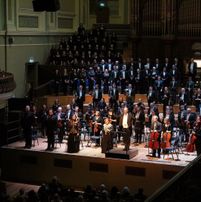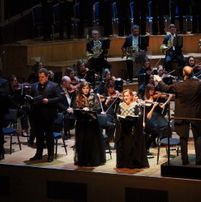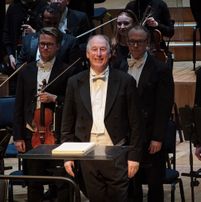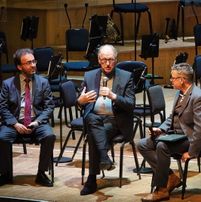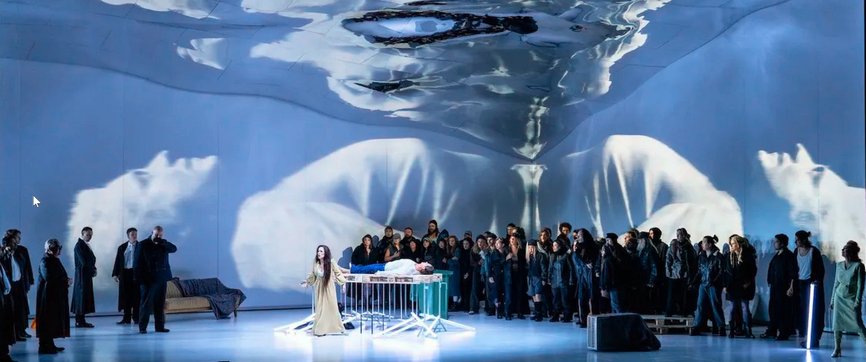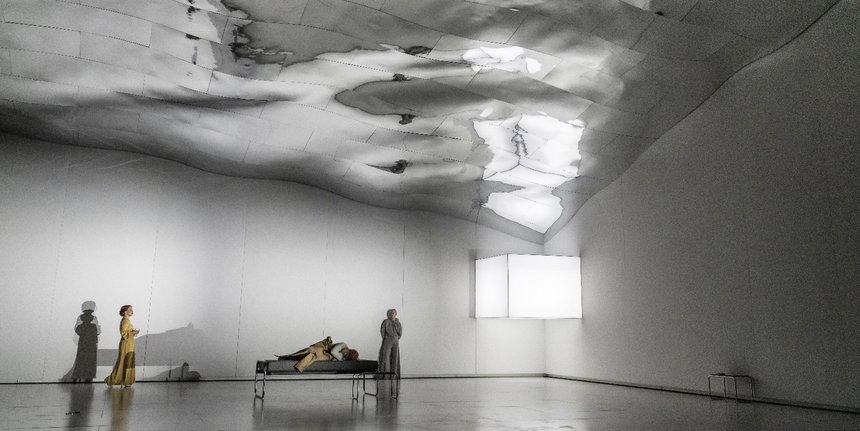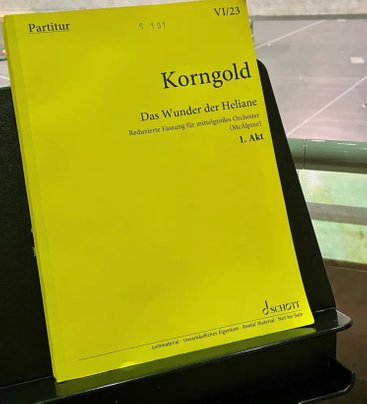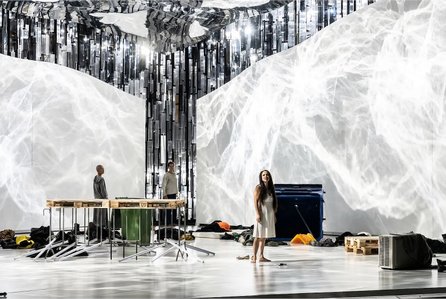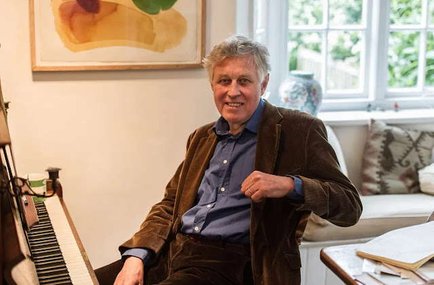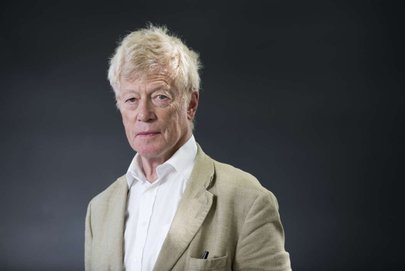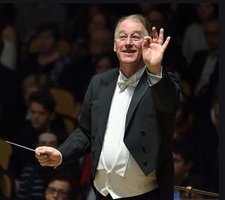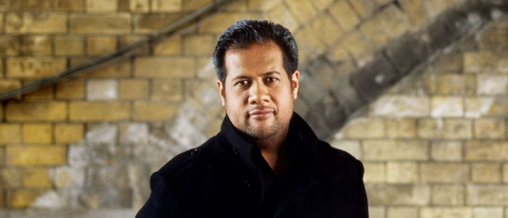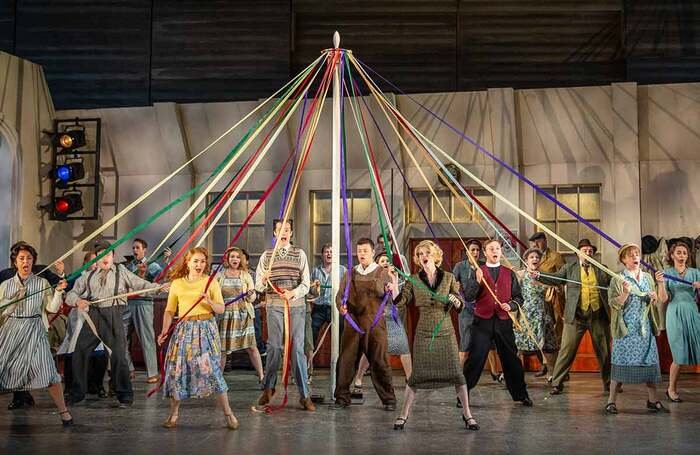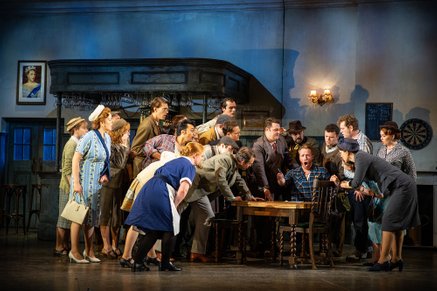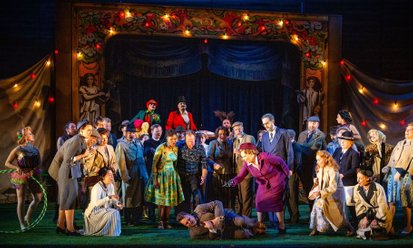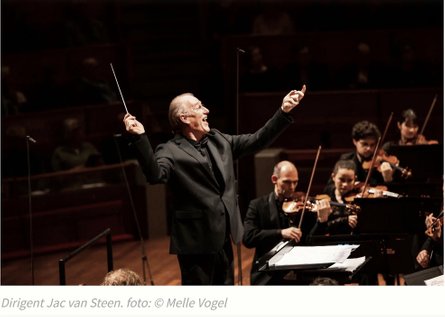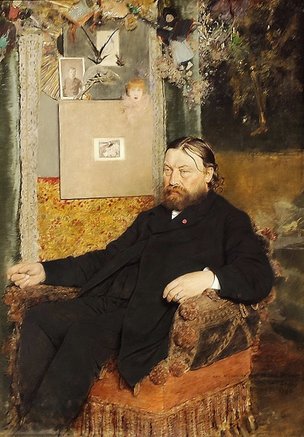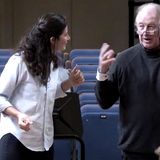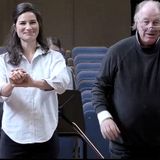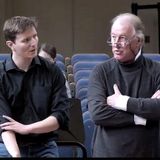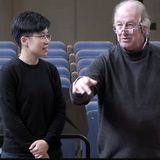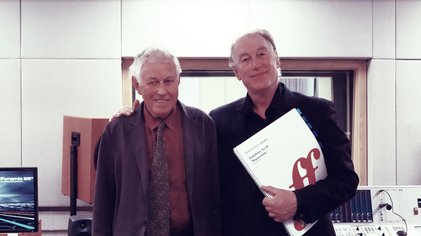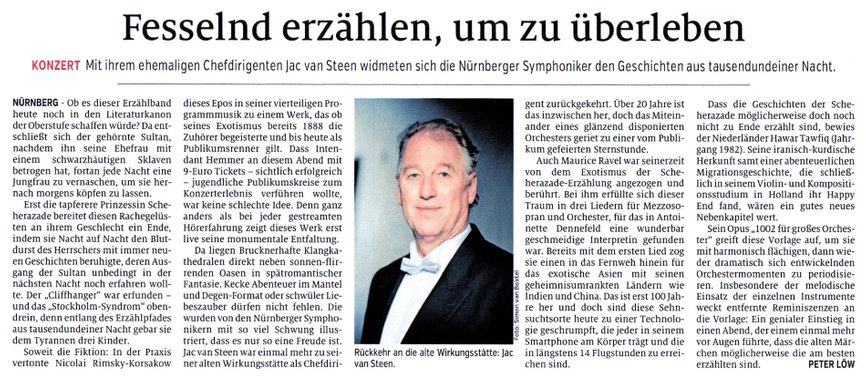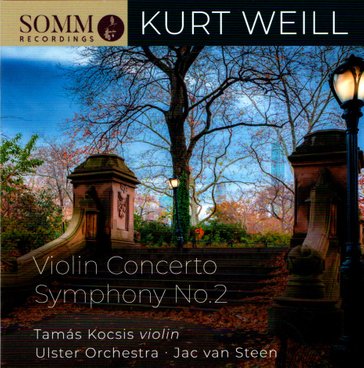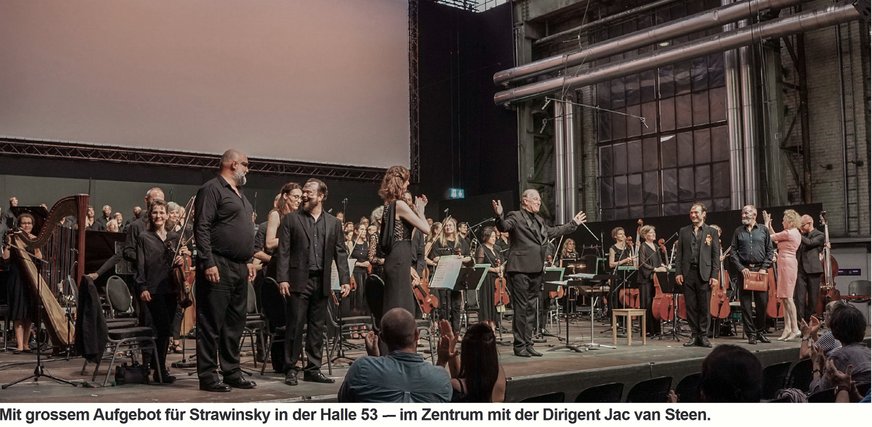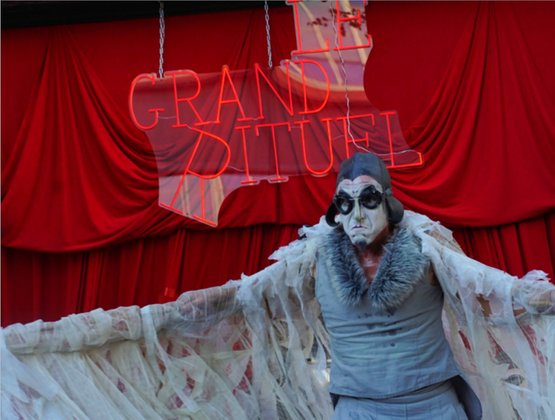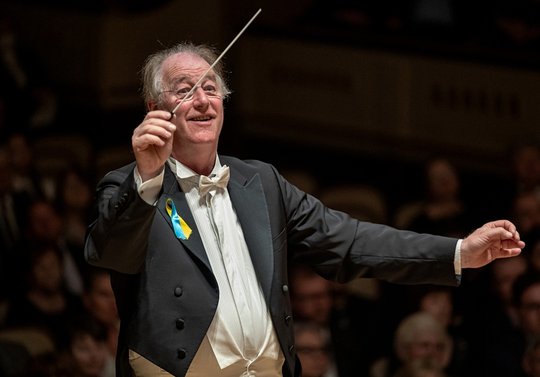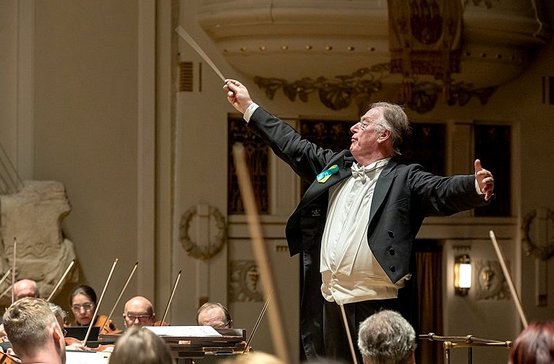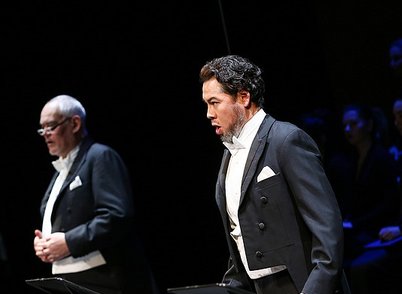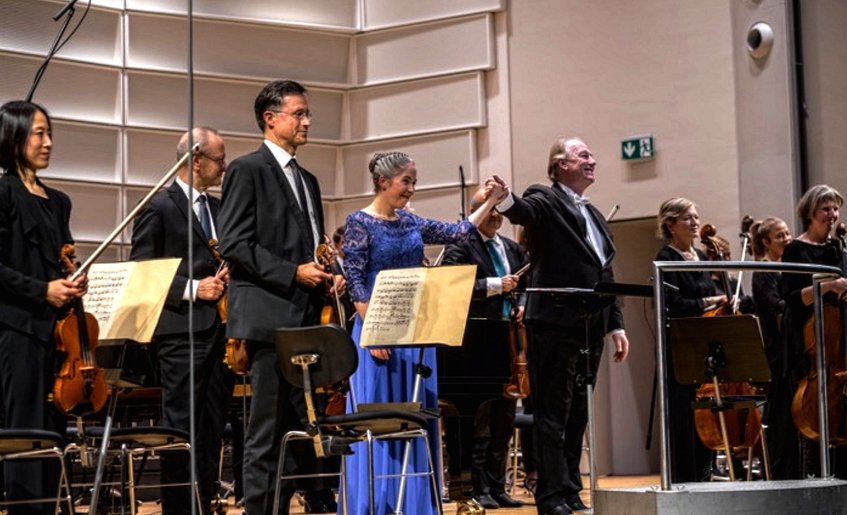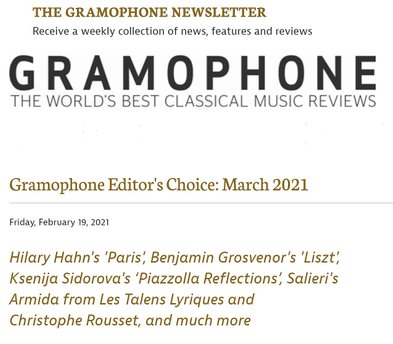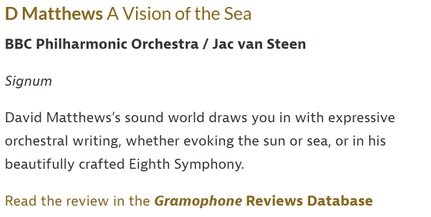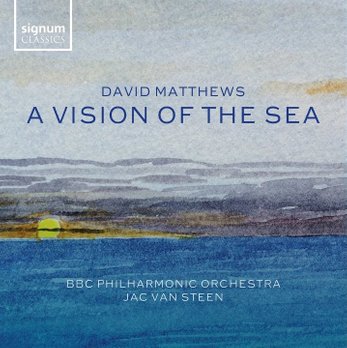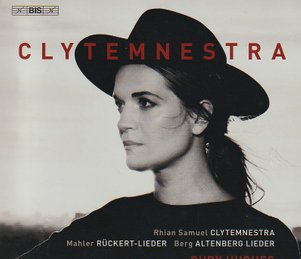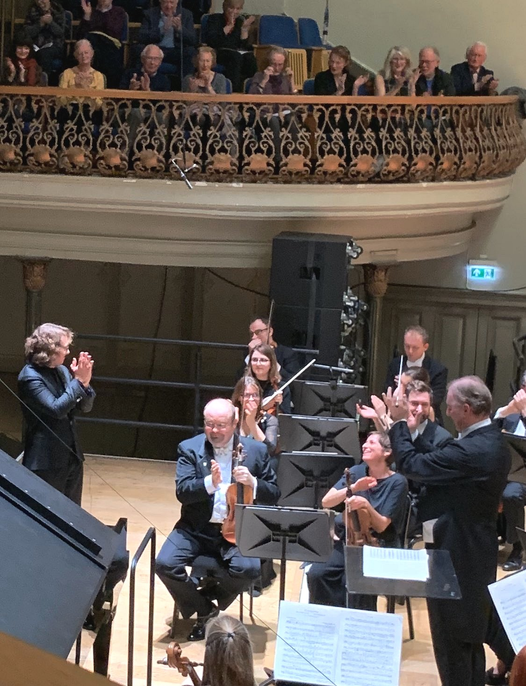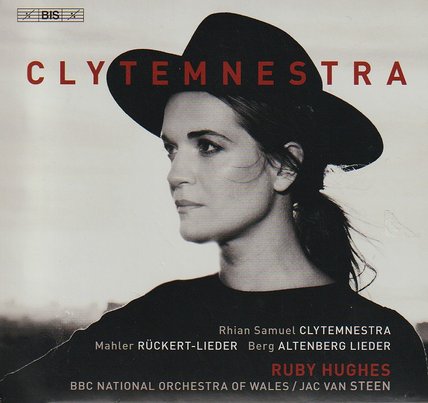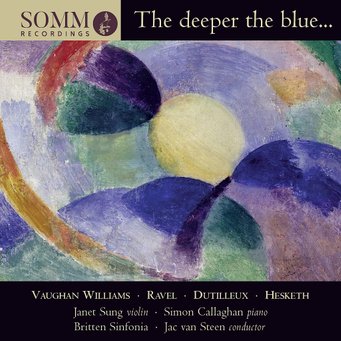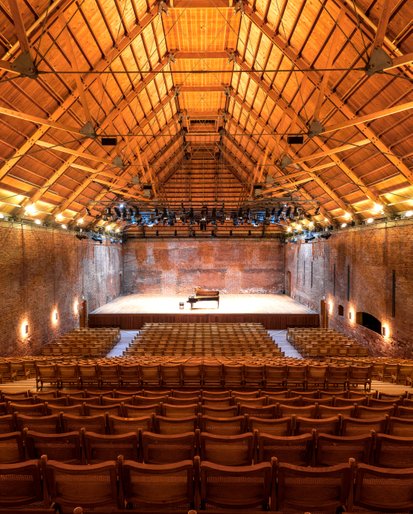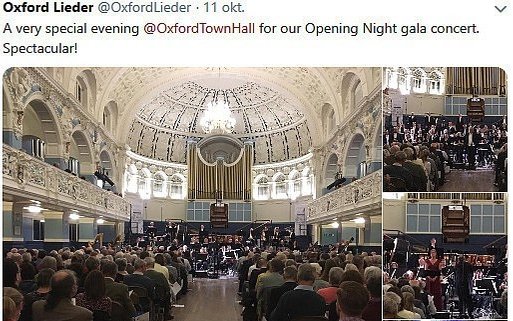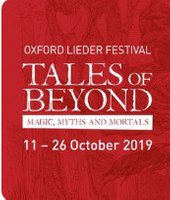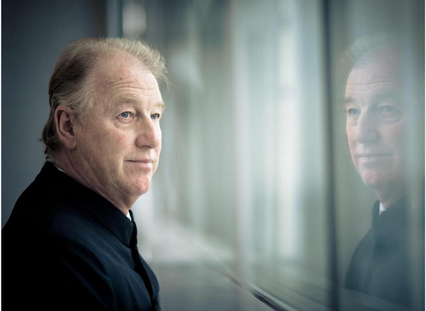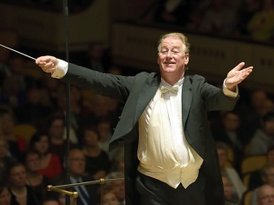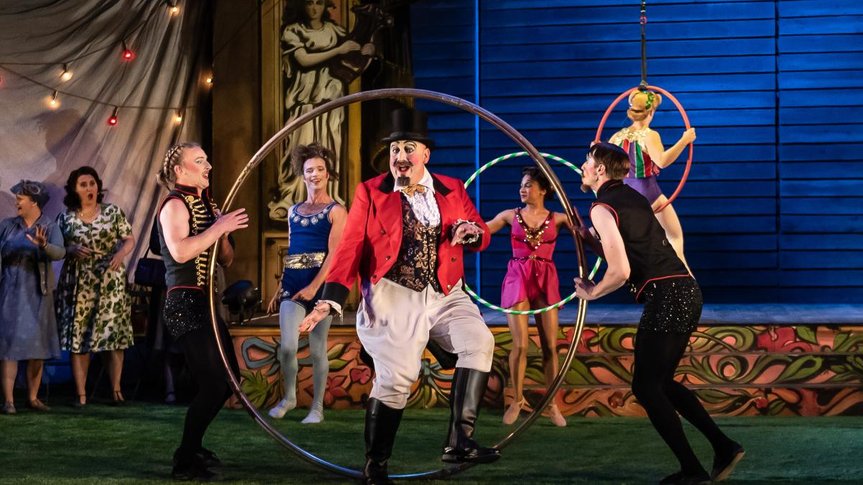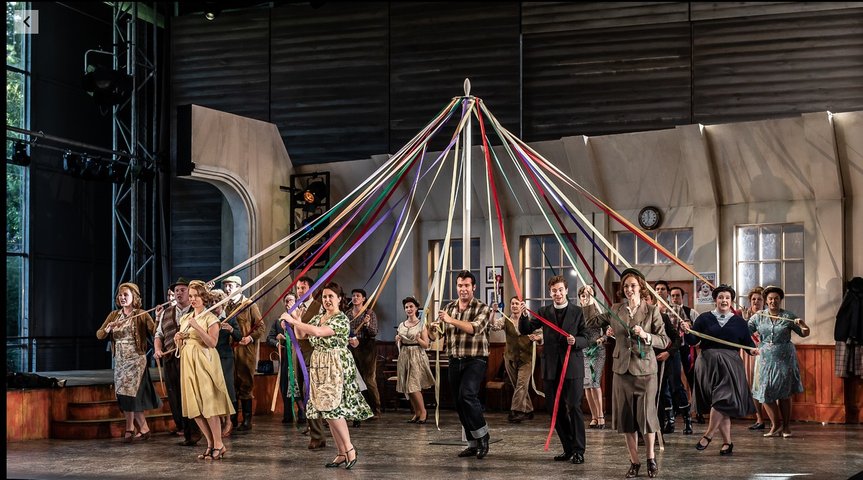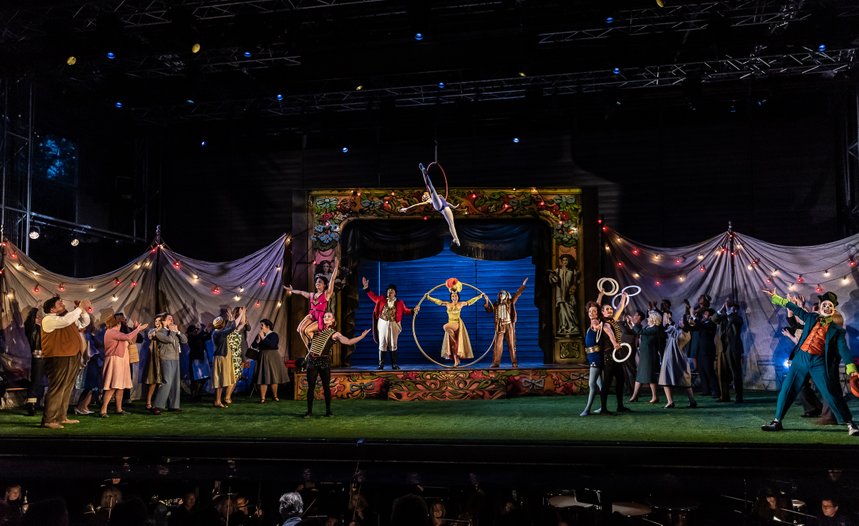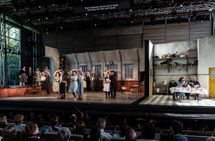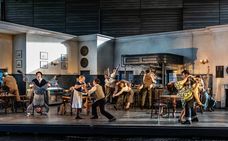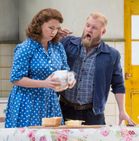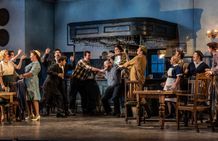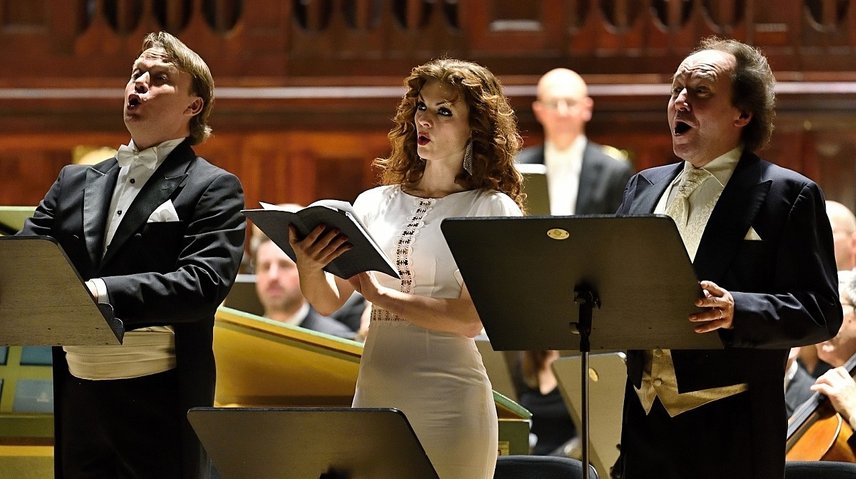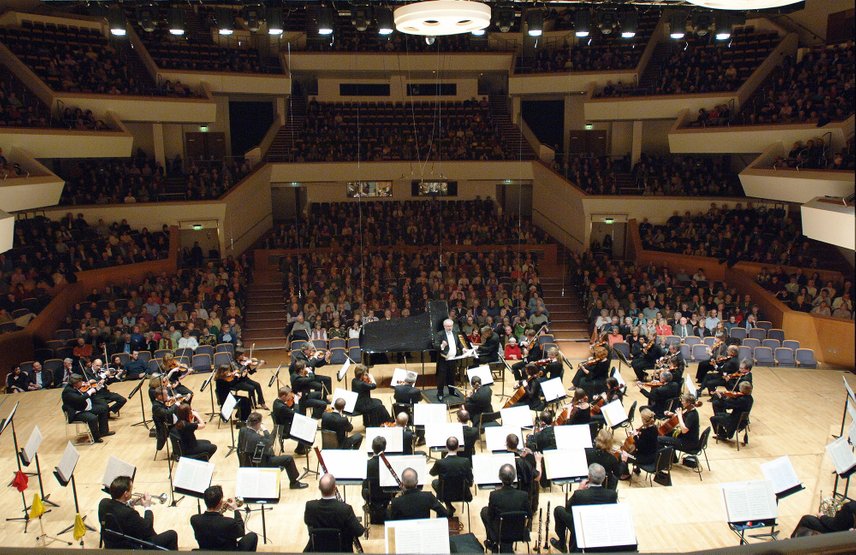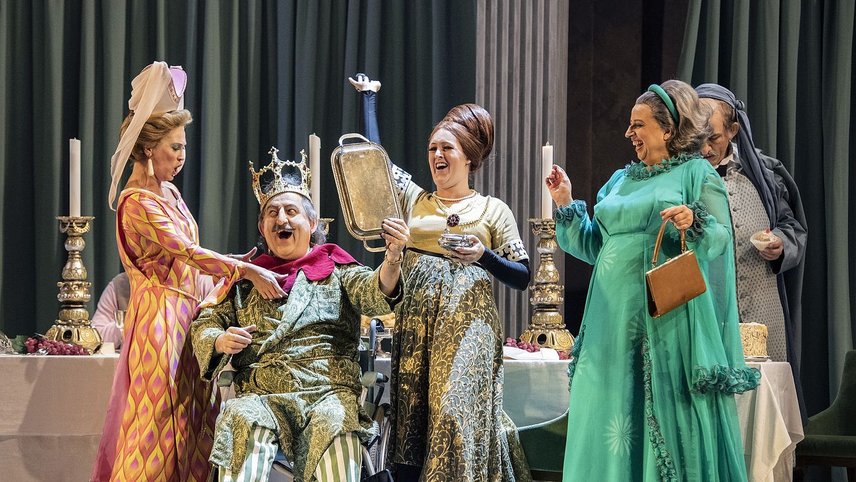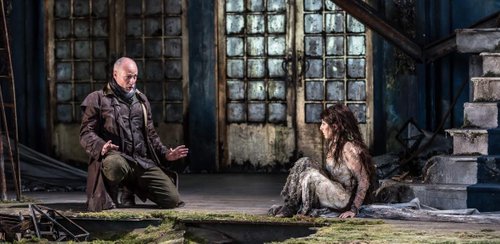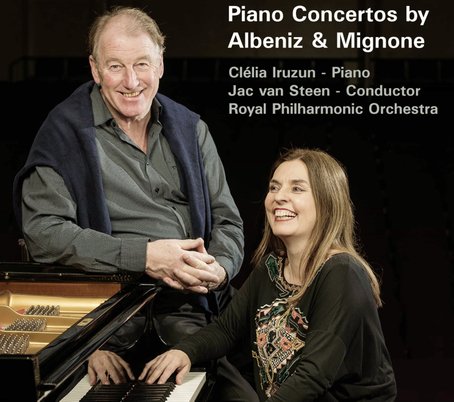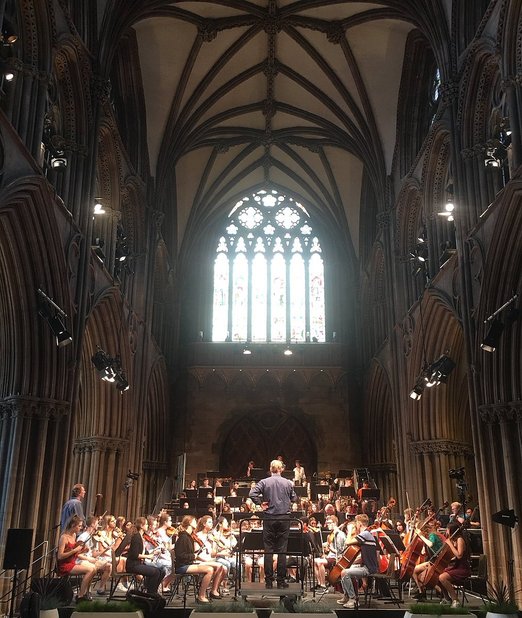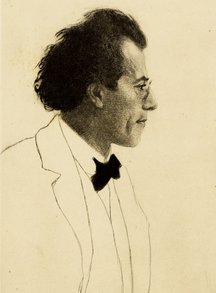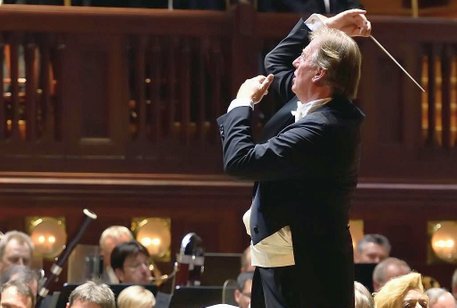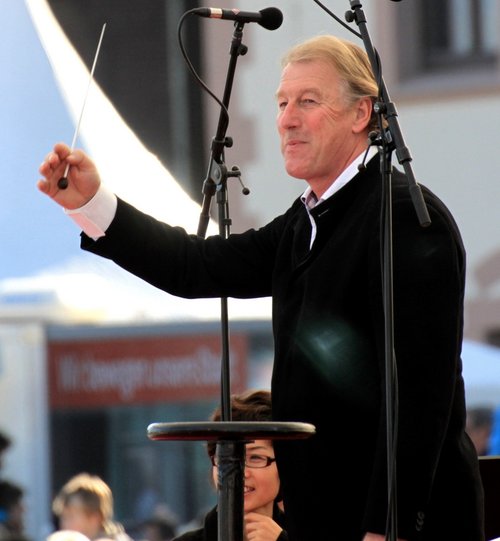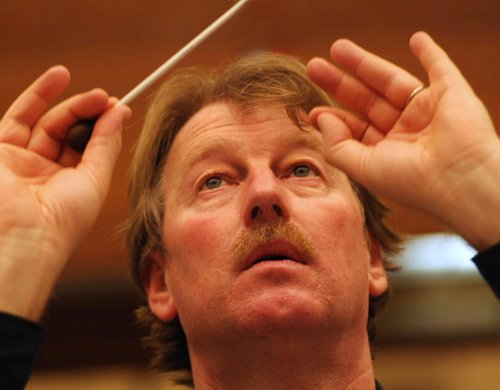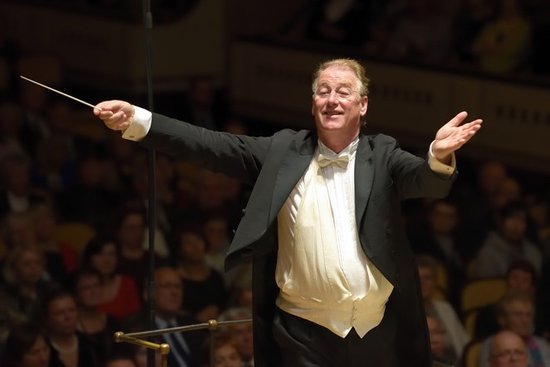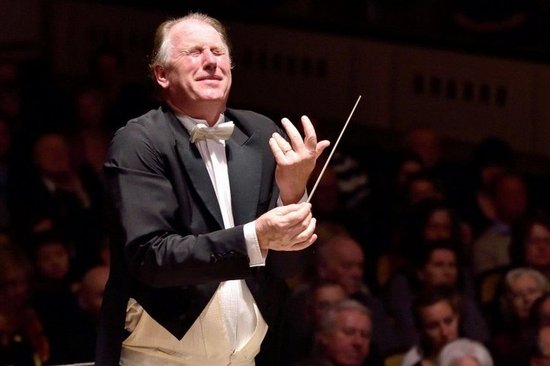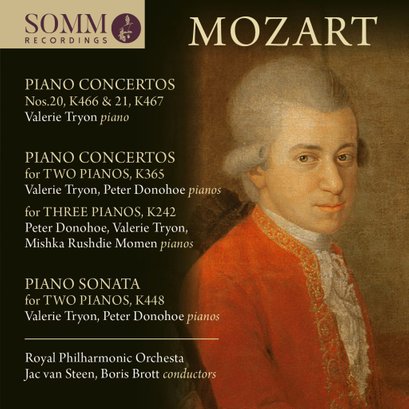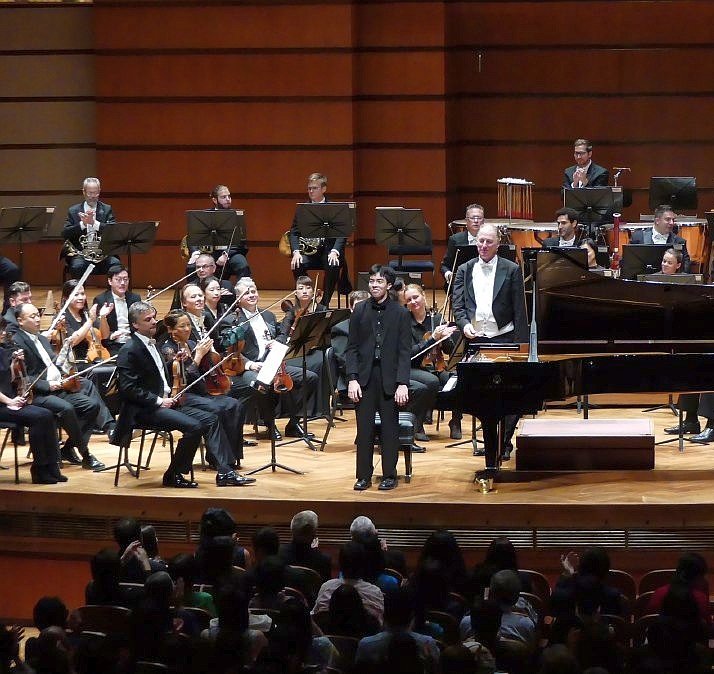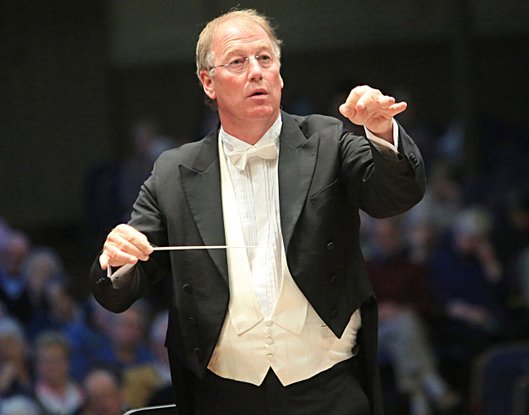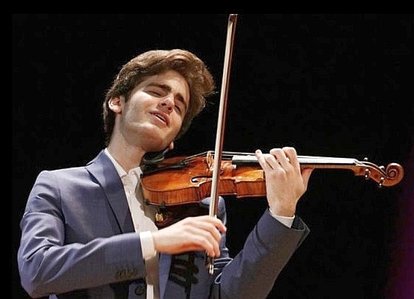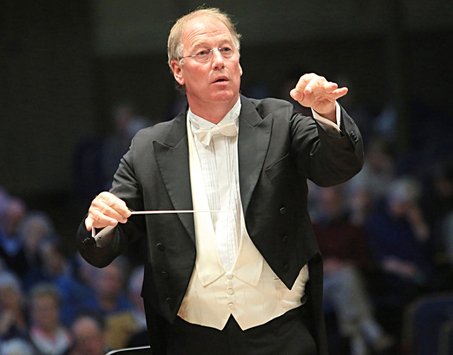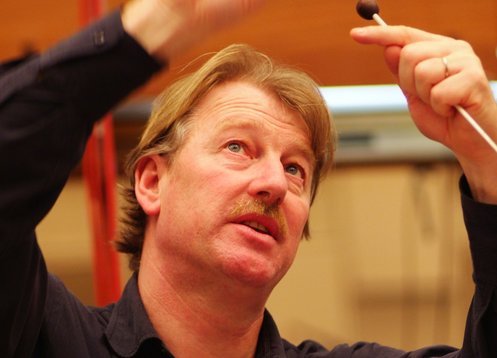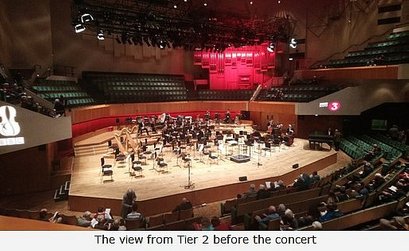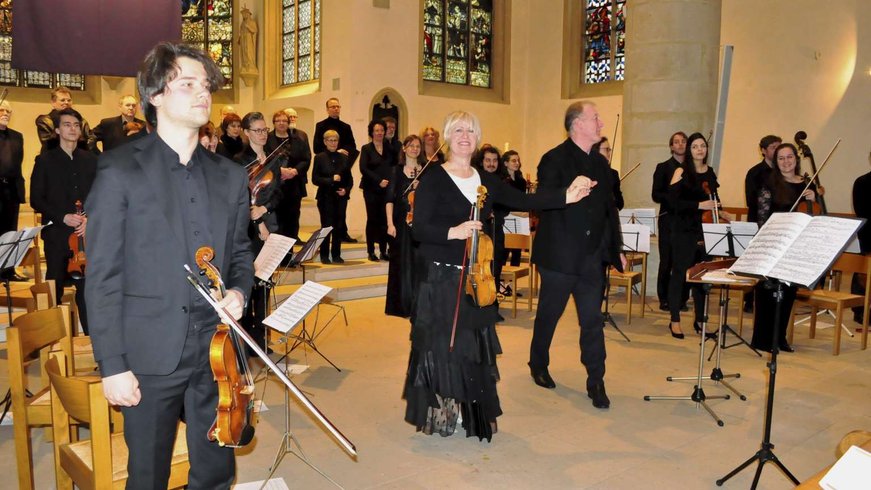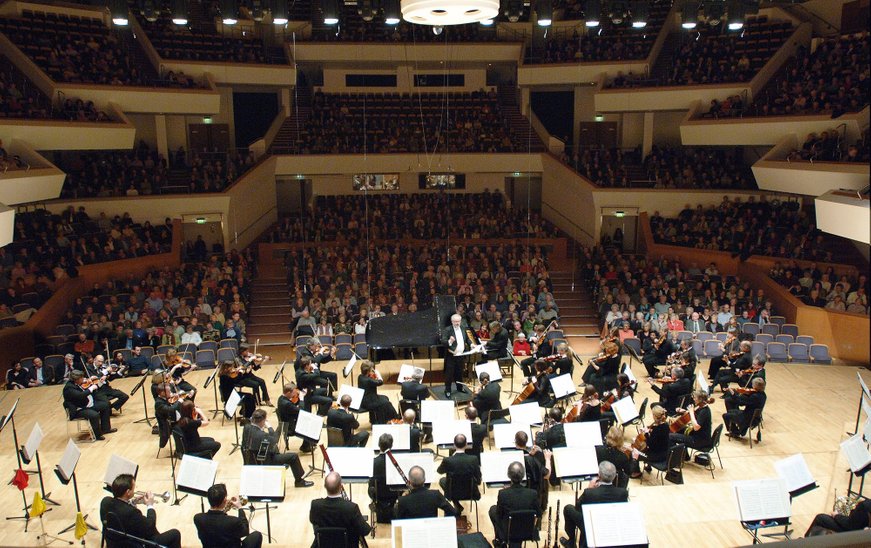Jac van Steen - Reviews
Sadness and beauty in Dvorak concert
Belfast Newsletter – 01 April 2024
When concert-goers see Dvorak's name they tend to think of his final symphonies, including the best-known Ninth 'New World' Symphony, but people may be less familiar with his Stabat Mater which is a masterpiece in its own right.
It was performed by the Ulster Orchestra, the Belfast Philharmonic Choir and soloists on Good Friday evening, for an appreciative audience in a well-filled Ulster Hall. In recent years the orchestra has performed sacred works on this important weekend in the Christian calendar, and last year the focus was on Haydn's Creation, so the timing of the Dvorak Stabat Mater was entirely appropriate. The concert was in the extremely capable hands of the distinguished Jac Van Steen, the honorary principal guest conductor of the Ulster Orchestra who is a regular visitor to Belfast.
Antonin Dvorak (1841- 1904) was a deeply religious husband and father, and his is Stabat Mater was completed in 1877 after the deaths of his young children at a time when infant mortality was common place. The Stabat Mater poem about Mary at the Cross, used by so many other composers, is an inspired context in which to express emotions and thoughts about life and death, and the mystery of resurrection for those who believe in such deliverance.
Dvorak's Stabat Mater was written and performed in 10 separate movements for over 81 minutes without an interval, and it moved so seamlessly and compellingly that the journey seemed much shorter, with the orchestra and soloists Ailish Tynan, Carolyn Dobbin, John Findon and Darren Jeffery always delivering with sincerity and understanding. There was sadness and beauty throughout, and the prolonged final Amen was powerful and riveting, and ending in a quiet finality reminiscent of Christ's last words from the Cross-"it is finished".
This was an evening to elevate the soul, as one concert-goer remarked on the way out. The Belfast Philharmonic Choir, which celebrates its 150th anniversary next season, was impressive with its soaring chorus rippling across the auditorium. It was also good to see so many of the 120-strong choir on stage, and much credit due to its chorus director James Grossmith for maintaining the highest standards since his arrival in 2022.
Facebook Ulster Orchestra 1 april 2024
Last Friday, our Honorary Principal Guest Conductor Jac van Steen led the orchestra and Belfast Philharmonic Society in Dvořák's powerful, emotional Stabat Mater, with brilliant soloists Ailish Tynan, Carolyn Dobbin Mezzo-soprano/contralto, John Findon and Darren Jeffery.
Some reactions from the audience on Facebook:
L.C...... This was one of the best concerts that I've attended in recent times. It was absolutely amazing.
U.D...... Uister Orchestra. It was the most wonderful experience. Thank you!
C.D:..... A Thrilling evening!! Thank you
J.B......A very memorable evening
V.R......Carolyn Dobbin is phenomenal
M.H....... The choir were amazing
E.H...... Stupendous!
THE magic of musical storytelling is surely nowhere better captured than in Bedrich Smetana’s six symphonic poems, Má Vlast, together telling of the myths, legends and beauty of his homeland Bohemia.
This powerful, patriotic, unrivalled nationalist composition encompasses tales of knightly valour, a magnificent castle, rage, deception, vengeance, the natural beauty of the landscape, defeat, victory and the journey of the mighty majestic Vltava river, by far the best known of the six pieces.
The connection between music and cultural identity of course runs long and deep and Smetana is seen as one of major inspirations in the ambition of independent Czech statehood, ultimately achieved. For those like me, relatively unfamiliar with all but the much played Vltava and Bohemia’s Woods and Fields, a screen over the stage told each story in words.
In another departure from the norm, the audience was encouraged to applaud between movements. Conductor Jac van Steen, principal guest conductor at the Prague Symphony Orchestra (so who better to be at the podium for the evening) instructed at the outset: “In fact, you are not allowed not to applaud between movements.”
In Vltava, the second piece, Smetana evokes the sounds of one of Bohemia’s greatest rivers, rising as two springs, through woods and meadows, with nymphs dancing in the moonlight, past castles and ruins swirling through rapids and bursting into Prague and onwards. The sixth movement speaks to warriors, battle and ultimate victory. In the rousing, uplifting finale, the High Castle of Vyšehrad, Prague stands proudly over the lands of Bohemia. Maestro was compelling and the players’ performance overflowing with joy, pride and exuberance. A triumph all round then. We all clearly thought so.
Andy Martin - 25th January 2024 - Bournemouth Daily Echo
Korngold - Das Wunder der Heliane - Nederlandse Reisopera
Opera Magazine UK – Robert Nachbar, February 2024
In 2019 Jakob Peters-Messer staged a fine Tote Stadt for the NEDERLANDSE REISOPERA (May 2019, p. 592). This season he returned for the grandest of Korngold's operas: Das Wunder der Heliane, seen on November 9 at the ROYAL THEATRE CARRÉ. This was its first staging in the Netherlands, postponed from 2021 because of Covid. It was an outstanding production, proof that small companies can stretch their limits and produce opera worthy of any great stage in the world.
The story is overloaded with symbolism. Peters-Messer, Guido Petzold (scenery and lighting) and Tanja Liebermann (costumes) set it in surroundings that were almost abstract, timeless and at the same time very much of 2023. Ukraine and Gaza never seemed far away, but this didn't distract from the essence of what Korngold and Hans Müller-Einigen, the librettist, wanted to convey. The direction of each character was as clear as it was simple and Peters-Messer drew out the best imaginable acting from all the singers. Perhaps the only drawback was the ending. Did Heliane and her Stranger ascend to heaven together or not? For once the few video projections were not at all intrusive and added to the drama.
When Heliane had her (almost) erotic encounters with the Stranger, the projections showed Hedy Lamarr in the 1933 Czech film Extase, the first ever film to depict a female orgasm. Nicole van den Berg danced the Angel, in her own choreography; she did not really contribute to our understanding of the story but didn't disturb except in the intermezzo before the third act, which I would have preferred to hear with the curtain closed. There were no weaknesses in the cast. Sander de Jong, Ross Ramgobin, Wiebe-Pier Cnossen, Lucas van Nierop, Aleš Jenis and Artur Janda were a very fine ensemble of Annemarie Kremer (centre) in the title role of 'Das Wunder der Heliane' with the Nederlandse Reisopera
Judges, and Paul McNamara excelled as the Blind Judge, as did Zachary Altman as the Porter. As the Messenger Ursula Hesse van den Steinen was vocally very fine but had minor problems with her rhythms early in the third act. One could not imagine a finer Ruler than Darren Jeffery. Diction from all the soloists was exceptional, so that the surtitles were hardly needed. This was especially true for Tilmann Unger, who sang the Stranger, and for the Heliane, the Dutch soprano Annemarie Kremer. Both gave marvellous performances in heavy roles, showing great stamina even at the end. Perhaps Kremer's voice is a little dark for the part, but she mastered it nonetheless, and built her solo 'Ich ging zu ihm' with the utmost tension and superb breath control to an exciting climax.
Fergus McAlpine reduced the original score so that it could be played by an orchestra of around 80 (rather than 110). The Noord Nederlands Orchestra gave a superb performance, although the strings could have had just a little more glowing warmness in tone. The conductor Jac van Steen brought tranquillity and clear detail to a score that could easily sound overwhelming. The extra brass band, high up in the galleries, sometimes overshadowed the main orchestra but this didn't spoil the overall performance. The chorus, Consensus Vocalis, excelled itself. McAlpine's reduction, initiated by the Reisopera and published by Schott, is now available so that other smaller companies can take up this work.
For a complete overview of the Heliane reviews, scroll down
December 2023
JS Bach's Christmas oratorio created an atmosphere of joy and inner harmony
Prague Symphony Orchestra | Jac van Steen conducting
Programme
Johann Sebastian Bach: Christmas oratorium BWV 248
Georg Friedrich Händel: Concerto grosso op. 6 nr. 7
As soon as the audience arrived at the Smetana Hall, it was clear that this was not going to be an ordinary concert by the Prague Symphony Orchestra, as the stage was filled with a variety of instruments, including the theorbo, harpsichord and organ. Conductor Jac van Steen invited musicians who are masters of historical instruments, namely Kateřina Maňáková on the theorbo, Ondřej Bernovský on the harpsichord and Daniela Valtová Kosinová, organ. but also baroque clarinets and baroque trumpets. The clarinet produces a thin and high tone, suitable for solo passages. Johann Sebastian Bach and Georg Friedrich Handel were among the composers who liked to write for the clarinet. In this concert they are played by Marian Magiera, Stanislav Majerski and Petr Jurášek.
The second cantata was followed by Handel's Concerto grosso op. 6 no. 7 , one of the twelve concertos for string orchestra and basso continuo. .
The concert concluded with Cantata III from Bach's Christmas Oratorio . In it, the performance of the Czech Philharmonic Choir Brno again stood out. The entire concert was firmly in the hands of Dutch conductor Jac van Steen, regular guest conductor of the FOK. He is inextricably linked to Bach's music, having been music director of the Nijmegen Bach Choir in the past. His approach to the informed interpretation of works from the Baroque period was highly inspired and professional. His energetic attitude and cordiality towards all performers clearly showed that this is a musical field close to his heart.
The Christmas Oratorio is a work that appeals to listeners not only with its beautiful music, but also with a deep spiritual message. A satisfied audience emerged from the Smetana Hall to Prague's festively lit city centre in an upbeat mood with feelings of joy and inner harmony, graced with this deep cultural experience.
NOMINATED FOR OPERA OF THE YEAR '23 AND SCHAUNARD AWARD
Erich Wolfgang Korngold << Das Wunder der Heliane >> -- Nederlandse Reisopera - Noord Nederlands Orkest
MUSIC DIRECTOR JAC VAN STEEN
Korngold's fourth opera, The Miracle of Heliane, was undoubtedly his most ambitious project. The libretto seems a little bizarre; it has to be seen through the eyes of the 1920s zeitgeist. It is a fiercely symbolic story, very much in the spirit of the interbellum, which Korngold captured in decadent and revelatory music. The mysterious, the unearthly, the supernatural, the divine, the heightened emotions and the blatant eroticism were all part of the zeitgeist. So was the spirit of sacrifice and the motto that love conquers all: if not now, then in the hereafter.
Fragments of the performance can be found under 'VIDEO'.
Full recording conditionally available on request for professionals only.
*****
Overweldigende Heliane bij de Reisopera
Place de l'Opera | Franz Straatman
2/10/2023
Het getuigt van artistieke moed om als Reisopera met een voor Nederland volkomen onbekend werk de regionale theaters langs te gaan. Deze moed werd beloond en bekroond met een nieuwe productie van internationale topklasse tijdens de premiere in het Enschedese Wilmincktheater van het Wonder van Heliane van Korngold. Annemarie Kremer als absolute ster in de titelrol. Maar ook de uitwerking van de groots opgezette orkestpartituur door het NNO onder Jac van Steen leverde een geweldige muzikale belevenis op.
Overwhelming Heliane at the Reisopera
Place de l'Opera | Franz Straatman
2/10/2023
It shows artistic courage for the Reisopera to tour the regional theatres with a work completely unknown to the Netherlands. This courage was rewarded and crowned with a new production of international top class during the premiere at the Enschede Wilmincktheater of The Miracle of Heliane by Korngold. Annemarie Kremer was the absolute star in the title role. But the NNO's elaboration of the great orchestral score, conducted by Jac van Steen, was also a great musical experience.
*****
Geen opera, maar een ervaring
Dagblad van het Noorden, 2/10/23
"Heliane" is een langdurig vergeten opera - aan de muziek kan het niet liggen, die is magistraal.Juist die muziek is zinvol voor het vormen van de klankkleur en het leren volhouden van lange spanningslijnen. Onder Jac van Steen speelt het orkest hier op het allerhoogste niveau
Not an opera, but an experience
Dagblad van het Noorden, 2/10/23
"Heliane is a long-forgotten opera - this cannot be due to the music, which is magisterial, especially when it comes to shaping timbre and sustaining long lines of tension. under Jac van Steen, the orchestra plays at the highest level.
*****
Korngolds merkwaardige opera waarin soms opeens alles klopt
NRC 3/10/23
Maar het echte wonder is de bij vlagen sensationele muziek van Korngold, uitstekend gespeeld door het NNO onder Jac van Steen. De inventiviteit, de orkestrale kleuren, de momenten van psychologisch inzicht en contrast.
Korngold's remarkable opera in which everything suddenly makes sense
NRC 3/10/23
But the real wonder is Korngold's at times sensational music, superbly played by the NNO under Jac van Steen. The inventiveness, the orchestral colours, the moments of psychological insight and contrast.
*****
Korngolds Europese zwanenzang beleeft een gedenkwaardige wederopstanding
De Theaterkrant 02/10/2023
De originele versie van Das Wunder der Heliane vraagt om een orkest van meer dan honderd musici. Om de uitvoerbaarheid te vergemakkelijken voor kleinere podia is een aangepaste orkeststratie gemaakt, met nog steeds 85 musici in de orkestbak. Maar ook met deze bezetting weten dirigent Jac van Steen en het formidabel spelende NNO alle kleuren uit de partituur tevoorschijn te toveren. En dat werkt wonderwel bij dit magische sensuele verhaal met deze bedwelmende muziek!
Korngold's European swan song enjoys a memorable resurrection
De Theaterkrant 02/10/2023
The original version of The Miracle of Heliane requires an orchestra of more than a hundred musicians. To make it easier to perform on smaller stages, a modified orchestral transcription was made, still with 85 musicians in the pit. But even with this instrumentation, conductor Jac van Steen and the superbly playing NNO manage to conjure up all the colours of the score. And that works wonders for this magical, sensual story with this intoxicating music!
*****
Das Wunder der Heliane
Online Musik Magazin
9/10/23
Dirigent Jac van Steen findet mit dem zuverlässigen NNO einen unsentimentalen erzählerischen Tonfall, der das Pathos der grossen Momente nicht unterschlägt, aber bewusst ansteuert und der Gefahr einer Dauerüberwältigung entgegensteuert. Sicher gibt es eine Näh zur Filmmusik (damit wurde Korngold bekanntlich später in Hollywood berühmt). Aber das umstrittene Werk erweist sich auch in dieser Version als facettenreich und musikdramaturgisch spannend
The miracle of Heliane
Online music magazine
9/10/23
Conductor Jac van Steen finds an unsentimental narrative tone with the reliable NNO, which does not hide the pathos of the great moments, but consciously steers towards them and counteracts the danger of being permanently overwhelmed. There is certainly a connection with the film music (with which Korngold later became famous in Hollywood). But even in this version, the controversial work proves to be multi-faceted and musically dramatically exciting.
*****
Het wonder van de Reisopera
Sander Boonstra,
Blog 22/10/2023
Tot slot een woord over de muzikale leiding die in deze productie in handen is van (ook uit Nederland) Jac van Steen. Absolute held van de avond, een dirigent die Korngold begrijpt en weet te doorgronden. Een ware leider die koor, orkest, solist en zelfs een blik koperblazers op het balkon vanaf de bok stevig in handen weet te houden, maar die iedereen de ruimte geeft ten volste te presteren en te laten genieten van wat hij of zij doet. Bravo Maestro!
Sander Boonstra,
Blog 22/10/2023
The miracle of the Reisopera
Finally, a word about the musical direction, which in this production is in the hands of (also Dutch) Jac van Steen. The absolute hero of the evening, a conductor who understands Korngold and knows how to fathom him. A true leader who knows how to keep the choir, the orchestra, the soloists and even a can of brass on the balcony firmly under control from the rostrum, but who gives everyone space to perform to the full and to enjoy what they are doing. Bravo Maestro!
*****
Sobere opera "Das Wunder der Heliane" van de Nederlandse Reisopera werpt vragen op
Volkskrant 3/10/2023
Het libretto is wellicht wat mager- de regie van Jakob Messer is van een vergelijkbare signatuur, sober, licht, tijdloos. Hiertegenover staat de broeierige, soms zware muziek van Korngold. Deze klare regie en uitstekende musici, het koor en het weeldering spelende NNO onder Jac van Steen hebben een zware taak om de boel in balans te krijgen. Maar dat alle musici een topprestatie neerzetten, staat vast
Dutch Reisopera's sober opera The miracle of Heliane' raises questions
Volkskrant 3/10/2023
The libretto is perhaps a little thin - Jakob Messer's direction is similarly austere, light, timeless. This is contrasted by Korngold's brooding, sometimes heavy music. The clear direction and the excellent musicians, the choir and the lushly playing NNO under Jac van Steen have a difficult job to balance. But there is no doubt that all the musicians gave a top-class performance.
*****
Basia con fuoco
2/10/23
Dirigent Jac van Steen en het orkest leverden een fantastische prestatie, geweldig wat er uit de bak op klonk..!
Basia con fuoco
2/10/23
Conductor Jac van Steen and the orchestra gave a fantastic performance. It was amazing what came out of the pit.
*****
Gedonder in de Spiegelzaal
Trouw 11/11/2023
Ik zal u het verhaal besparen, maar de enscenering van Jakob Messer van Heliane raakte de ziel.
En zoals in 2018 bij zijn interpretatie van Die Tote Stadt, stond er opnieuw een fantastische
dirigent op de bok: Jac van Steen. Grote klasse!
Thunder in the hall of mirrors
Trouw 11/11/2023
I will spare you the story, but Jakob Messer's staging of Heliane touched the soul. And as in 2018 with his interpretation of Die Tote Stadt, there was again a fantastic conductor at the helm: Jac van Steen. First class!
Translation spoken text in Dutch by Annemarie Kremer:
The role of Heliane is very close to my heart. I have had the opportunity to sing it several times. I expressly say "opportunity" because it is not performed very often. So when you get the chance to do it, it's really fantastic. Also because the role suits my voice incredibly well. I am also a singer who is well suited to Strauss, and Strauss also has a lot in common with Korngold. When I started to study this role and eventually sang it in concert a few times - it fits like a glove, even though it is quite an extreme role. I've sung a lot of demanding roles, but this one really sits with the very demanding ones, because it's very high, with long phrases, and then yet another step higher, and then again another step higher. It's also hard because it's sometimes quite low.
The role of Heliane gives me a lot of satisfaction because there is a great development in her character. And that's what I really enjoy... For me, opera is where singing and acting come together. If you can combine that in one role... that’s really my thing to portray Heliane as she is. Besides, I love Korngold's music - it engulfs you, embraces you, overwhelms you. You are completely swept away by it - I love it.
Translation spoken text in Dutch by Jac van Steen:
If I were to leave out the image, the music is so strong that the characters, the atmosphere, the celestial, the dark dictatorship that's in it, all of that already portrays the drama, all the way through as a kind of image, a musical cartoon with leitmotifs, like in Wagner, or with colors about love and nature in Ravel. That's Korngold!
It is so well written, remember, Korngold was a child prodigy. So writing something difficult, for us, was not difficult at all for him. He could play anything, he was a brilliant pianist. And now I'm quoting Gustav Mahler! I think that just the charisma and the fun that we have as a kind of Korngold family for a few weeks, that the audience can take that vibe with us, and I hope everyone has a wonderful evening with beautiful music. It's like Tristan & Isolde four times over, with really beautiful, great romantic music.
The story behind Nederlandse Reisopera's latest production:
Korngold's Das Wunder der Heliane
29 September 2023
Nederlandse Reisopera’s latest production of Korngold’s Das Wunder der Heliane will be the first staged production of this opera in The Netherlands despite the work receiving its premiere nearly 100 years ago. Why is this Korngold opera performed so rarely when other operas have found success?
I was curious, so after attending a rehearsal early in the production phase, I spent a very sunny, late-summer afternoon chatting to Fergus McAlpine, the young British arranger and conductor, to find out more.
The history of Korngold’s Das Wunder der Heliane
Korngold was a prolific Czech American composer and pianist, latterly known in America for his pioneering work in the world of film music, winning two Oscars for his efforts. Today though, Korngold is perhaps more known for his classical music. Premiered nearly a hundred years ago in 1927 in Hamburg, Das Wunder der Heliane, is Korngold’s fourth opera and one with a somewhat chequered history. Written for an orchestra of over 110 musicians, most opera houses in Europe simply do not have a pit big enough! The opera is therefore rarely staged.
For many years, the music of Korngold lay dormant, but gradually at the end of the twentieth century, his work started to gain prominence all around the world. Performances of Das Wunder der Heliane were still few and far between. Indeed, the three performances at the Volksoper, Vienna in 2017 with Annemarie Kremer in the title role conducted by Jac van Steen, were concert performances and not staged.
However, ideas were brewing in the corridors of Nederlandse Reisopera based in East Netherlands. After their successful stage production of another Korngold opera Die Tote Stadt in 2019 directed by Jakob Peters-Messer, Nederlandse Reisopera actively started to explore the possibility of bringing this lesser known opera, Das Wunder der Heliane to the stage.
The birth of a new score
How to overcome the hurdle of the immense forces needed to produce Das Wunder der Heliane? As with many stories in recent years, the 2020 lockdown played it’s part, and gave birth to this new score created by Fergus McAlpine. The result is a score for a reduced numbers of players, with exactly the same music, lasting exactly the same time and leaving the vocal lines untouched – and most definitely not an arrangement!
Many students from all over the world come to The Netherlands to study conducting on the National Masters in Orchestral Conducting at the Amsterdam Conservatory and the Royal Conservatoire of The Hague. In 2020, when the world closed its doors to orchestral music, Jac van Steen, a teacher on the course gave his students the task of producing a version of Zemlinsky’s Lyric Symphony for reduced forces to replace the original large orchestration.
Task complete! What next for the young conductors? A request from Nederlandse Reisopera to produce a reduced score for Korngold’s opera, Das Wunder der Heliane. One student was given the task.
And so after a number of twists and turns, requesting and receiving the necessary permission from the Korngold family and collaboration with the publisher – Schott, we arrive at the premiere in Enschede on Saturday 30th September 2023, of an opera produced by Nederlandse Reisopera, directed by Jakob Peters-Messer, with singers from Consensus Vocalis, and scored for just 70 orchestral musicians from the North Netherlands Orchestra.
The Original score V the New score
How does the new score differ from the original?
Is this new score an arrangement, or is the score faithful to Korngold’s original intentions?
McAlpine is very clear on this point. The opera we will hear on stage is not an arrangement of the work. It is instead a reworking of the score for a smaller orchestra. The work will still have the same power and majesty as the original format, just written for a slightly smaller orchestra.
Where the original score indicated four flutes, three oboes and four clarinets, McAlpine reduces these numbers. Percussion is halved from seven or eight players to just three or four, with players doubling up on instruments. The original four keyboard parts are likewise halved to two by doubling the piano part with the celeste, and the organ with the harmonium. Brass numbers are similarly reduced. The score also allows flexibility for the six, (yes six!) additional off-stage fanfare trumpets and three off-stage trombones to be incorporated into the orchestral parts. The vocal parts remain the same.
The new score
The newly commissioned score published by Schott
Interestingly, McAlpine’s work was not just to reduce the number of players. The original score had over 1,000 errors – hopefully they are now all correct! Even the date on the title page was incorrect, originally indicating 1923 – 1296 as the date of composition!!
Will other opera house across Europe now stage this opera using the new version? Only time will tell!
So, why should we go and listen to Nederlandse Reisopera’s latest production of Das Wunder der Heliane?
What is so special about this Korngold opera?
After my visit to the rehearsal, I am starting to understand the appeal of Korngold and why so many musicians hold his work in such high esteem. The opera sounds almost symphonic such is the scale, technical difficultly and long musical lines. This is not a fast moving opera. Much like Wagner, singers languish over small amounts of text and movements in the plot. Korngold presents us with a tonal palate that we are familiar with, but adds that extra musical twist to distort the sound without us being immediately aware of what he is doing.
In this modern world where we are constantly searching for something which goes beyond our expectations, perhaps we can look to a work written nearly 100 years ago to satisfy our needs. The North Netherlands Orchestra is the ideal partner, creating a big orchestral sound. They were certainly not holding back when I heard them in rehearsal with Jac van Steen at the helm.
The cast
Dutch soprano, Annemarie Kremer was a natural choice for the role of Heliane, a role she knew well after her performances in Vienna in 2017 and subsequent recording in 2018. She is known to audiences in The Netherlands after joining the 2015 Nederlandse Reisopera production of Puccini’s Madam Butterfly and was keen to join this production.
The set
Photo: Quite an extraordinary set created by Guido Petzold ©Marco Borggreve
The chorus
So, on Saturday, I will join the audience for the premiere of this latest production from Nederlandse Reisopera and dive deep into a 1920s world where nothing is certain, where we question the reality of all we see before us, and where we can wallow in the rich orchestral sound of a composer who later became one of the most influential film composers of his generation.
SYNOPSIS
In mythical times, the ruler of the realm visits the stranger in his cell to deliver a death sentence for incitement of the people. When the ruler has departed, his wife Heliane slips into the cell, she lets down her hair and exposes her bare feet. When the ruler returns he sees his wife standing naked in front of the prisoner, Heliane informs the executioner that she desired the stranger, but did not touch him. The stranger is asked to make a statement but only agrees if he can first be alone with Heliane for a moment. Once the court has left the chamber, the stranger kisses Heliane and takes his own life with her dagger. Heliane is accused of murder and without witnesses the ruler proclaims to the enraged crowd that only God can prove Heliane's innocence and that she must bring the stranger back to life. The resurrection is however not undertaken: Heliane considers it presumptuous to act in the manner of God giving back life and is prepared to be burnt at the stake. At the last minute, a miracle does however occur: the stranger rises from the dead and embraces Heliane. The ruler stabs her in a blind rage and loses all his powers. The stranger becomes the new ruler, sends the king into exile and liberates the people. He then ascends to heaven together with Heliane.
A Formidable Creation.
Roderic Dunnett experiences the first performance of the opera 'Anna' by English composer David Matthews
classicalmusicdaily.com - Roderic Dunnett - 24 August 2023
RODERIC DUNNETT experiences the first performance of the opera 'Anna' by English composer David Matthews
David Matthews, whose opera Anna has just been given its concert premiere at The Grange Opera, is one of the most inventive, sensitive and thoughtful composers in England today. Experience of the Czech Republic and especially Moravia, both formerly Czechoslovakia, is possibly the most important influence, certainly on his life, at times on his music. Another experience was working with Benjamin Britten in his later days, near the end of the 1960s.
Photo: David Matthews, who turned eighty in March 2023
His technique, though not necessarily his actual voice, one tangibly less Modernist than that of his brother Colin, owes something to both. Indeed he has written, 'Schoenberg's non-vernacular language I believe to have been a sidetrack in musical history' (although he is not wholly averse to Sprechstimme). He knows his Tippett (on whom he has written an invaluable book). Most amusingly, in his multicolour attire, orange tinge, soft shoes and shambling gait, at the curtain calls he actually looked like Tippett: 'I agree with Tippett that our living vernacular is jazz, blues and above all, rock'; his own vernacular above-all would doubtless be vivid, sometimes thrilling East European (especially Czech and Slovak, but Hungarian and Romanian too) folk-music, and possibly Jewish Klezmer - each evident, not just in passing, in this pioneering opera score; and surely Bartók - a crucial trailblazer for any composer of string quartets, of which Matthews has composed, incredibly, some twenty. An extraordinary achievement, indicating his typically consistent innovation and determination.
This commitment to Eastern European culture, lifestyle and indeed politics made the late Roger Scruton's libretto, written shortly before the philosopher's death specially for Matthews, a perfect draw for him. 1989 has clearly just passed - it is not acknowledged as such - and we are in an unnamed city - surely really Communist Brno; though the advertisement for Anna clearly shows central Prague.
Here a brother, Peter, Alex Otterburn, intensely moving, but explosive too, with the voice and aggressive timbre to match, and sister, Anna, Rhian Lois, sensible, feisty, and sensational at full stretch, which Matthews is not afraid to demand, both deprived in their teens of tertiary education and reduced to more menial jobs: he electrical, she a little better - librarian, due to their father's being accused, rightly or wrongly, of anti-state activity, and dying under interrogation - are coming to terms with their ill-fortune, a deep sense of grievance, and below that, even at their grown-up ages, surely a feeling of orphaning and deprivation.
Photo: Baritone Alex Otterburn, the vexed central figure of Peter, Anna's pessimistic brother
But they treat the present situation differently: he harbouring an urge for 'justice', to take revenge retrospectively on his father's torturers; she more positive and optimistic: 'I wish we could move on from all that happened, and begin to live'.
Anna's dissidence from her brother's understandable (perhaps, in the newly freed states, quite common) obsession is much-repeated: 'You cling to the past when the future beckons': she in a reverse (fresh) way almost obsessive herself. His is an insistence - 'Forgiveness? Never!' - hers in effect a compromise, even denial. The 'freedom' she anticipates, more or less welcomes, is to him more godless than the atheist Communists themselves. 'We're all free now: everything is for sale.'
Photo: Soprano Rhian Lois, who commandingly sings the title role in Anna
'What is deserved is only half of justice: there is mercy, too', says (I think) the loyal friend, Marta. His is a fairly virulent dream of vindication and revenge; Anna's, a dream of freedom: 'We have lived through a time of darkness', she concedes - a reason for self-liberation. 'Stop it, Peter, we were romantic children then.' Then - not now. An effective verbal counterpoint, which opens the door to much in the music.
This dialogue, the pair interacted with by two other characters - a third at the end - forms the basis for the opera. Scruton's text is not surprisingly permeated by a philosophical and moral exploration or underlay, which is something Matthews is able, time and again, to bring out in his music. At certain stages during Act I, one felt the author's script slipped attractively into the poetic, rich in imagery; at others, however, mainly later on, some of that delicacy seemed to yield to a more prosaic, dialectical approach which left a great deal for composer and indeed singers to engage with. It lugubriously rabbits on, one might suggest. Too repetitive.
Photo: Roger Scruton, himself the composer of an opera, whose libretto was set by David Matthews as Anna
If anything lingers in the mind after this memorable first performance, it is the orchestra. And this means the conductor. Jac van Steen is surely one of the most powerful, authoritative, deeply researched and skilled maestros today. One thinks of Carlos Kleiber. His ability to nurse and steer his players of the Bournemouth Symphony Orchestra was visible: his transitioning from almost a total hush to a dazzling scherzo was nothing less than electrifying; in his unique, astonishing way, he motivated them. Here was evidence of Matthews' score's range.
At relevant moments van Steen rose to his full, towering height; at others he could crouch down like a kitten, almost hiding behind the lectern. He would moderate the length of his baton, to achieve a different effect. If he could generate, more obviously, a fortissimo - way beyond the size of his still ample ensemble - he could take the strings down to not just pianissimo, but quadruple piano. It was a lesson. We were watching a master at work.
The great Dutch conductor Jac van Steen, who has recorded several of David Matthews' symphonies, was Musical Director of the BBC National Orchestra of Wales, and acclaimed for his galvanising appearances at Garsington Opera.
Not just the orchestral, but every cue his soloists needed he gave, immaculately, swivelling to them, just as he arched over to the players at the rear.
Time to acknowledge the two other main characters: Marta Fontanals-Simmons providing the heartening, understanding (as it happens) Marta, and tenor Oliver Johnston quite superb as the much-resented, undesirable returnee, Miro(slav).
Photo: Tenor Oliver Johnston brings superb tone and musicianship to the interloper, Miro
(Peter: 'What is he doing in his home town?' ... 'I hold you to blame for my father's death; and the greed and corruption that are destroying our country.') Both these two soloists were searing, but also alleviating, and Matthews' writing for them appropriately so.
Photo: Highly praised mezzo-soprano Marta Fontanals-Simmons, who sings the role of Marta
The vocal ensembles - duets, and an exciting, telling trio, for instance - were superbly managed. When Father Antonín - the ever-powerful, here tender bass-baritone Jonathan Lemalu - arrives as a (hopefully) steadying influence, his contribution is small but his vocal presence magnificent. (NB: Antonín is a Czech name.)
Photo: Bass-baritone Jonathan Lemalu gives presence and weight to the role of Father Antonín
But it is still the orchestration that utterly dazzled and inspired. 'My music for Anna is symphonic', Matthews has said. Well, a real symphony - albeit in multi-movements - we were treated to. The instrumentation is sensational, indeed by its constant variety explored the imagery the libretto never quite managed to. Frequently, it made us shiver with its nervy activity, fretful in solos - insistent clarinet, whining trumpet, and the rest. The strings - violins over double bass, scratchy, pretty nasty. Cellos, surely divisi, in more than one salient moment, and together in some gripping pizzicato. The woodwind was used to miraculous effect: packed together, assuming a chromatic tinge; flute soloist plucked out from the textures to glitter, or grieve. A brass interlude - there were several, Debussy-like - breathing fire; a well-turned, unexpected sad fugue; or everyone breaking out in a kind of Klezmer dance with all the associations that might carry. The use of tympani and percussion was consistently clever, marvellously judged, and mesmerising. A small chorus, pianissimo, added a welcome layer.
And here and there, one heard not Janáček's unmistakable, jabbing voice, but maybe aspects of his technique. Matthews has allotted, he says, its own Leitmotif to each character, but surely he goes beyond that. Perhaps several, more likely; plus virtual Leitmotifs for the orchestral units, deftly and sometimes insinuatingly passed around by them. It was all very appetizing, at times intense, absorbing, and strangely thrilling. Matthews has composed (nearly) ten symphonies, nine of them already recorded on NMC, Nimbus, Dutton and Chandos, in addition to several recorded concertos - one, double.
He has surely exported his mastery of the string quartet (all adopted by Toccata Classics) into this score, hence the marvellous ranging use of orchestral sections in intimate exchange, fiery aggression, perky interplay or tumbling counterpoint. But possibly one is rightly reminded of the vivid colours - are they watercolours or acrylics? - with which he clothes his quite frequent Symphonic Poems: In the Dark Time, The Music of Dawn, Towards Sunrise, or A Vision of the Sea (his latest): there, not least, one discovers what a sensationally expressive orchestrator he is, all of it reflected here.
Matthews' (and Scruton's) Anna - supported by the Matthias Corvinus Collegium, named after the great renaissance king of Hungary, 1458-90 - is a formidable creation. Its writing was spread over three years. If one had to look for composers with whom his idiom might be paired, or with whom he has (to a degree coincidental) kinship, they would not be from our half of the twentieth century (although Tippett is arguably his most important springboard, and John Joubert comes close; Nicholas Maw offered a keen sense of encouragement), but from the primarily tonal works of the early twentieth century, composers with whom, I admit, I myself am obsessed: Schreker - one besotting passage is a dead ringer for his 1924 opera Irrelohe - Korngold and Krenek, while in more lyrical spots, as gorgeous as Samuel Barber. Diatonicism runs through his symphonies, and if anything has become more marked in his writing. Matthews has made it a mission to renew and revitalise interest in tonality, or rather tonality itself. Time and again, he succeeds.
This semi-staged (really non-staged) premiere, with a full audience, came about from a chance, and happy, meeting with The Grange's Artistic Director, the superlative countertenor Michael Chance. Would it be sensible to consider staging it, in a summer season or two? Quite possibly worthwhile. Welsh National Opera throve on mounting (from Bregenz) David Pountney's bold undertaking, André Tchaikovsky's The Merchant of Venice. It triumphed.
Photo: The Grange, Northington, near Winchester, UK, seen from above
Anna will gain enormously from an intelligent staging, its four chief characters interlocked in their contrasting worlds, in this respect, rather like an intimate Janáček opera based on those Ibsen-like texts by female Czech playwrights, or indeed one by his Bohemian-Moravian contemporaries Foerster and Novák. It's worth giving it a go.
Henley Standard, 24 July 2023
Acrobats, trapeze artists and innovative scene changes were visual treat
DESPITE being the most popular of Czech operas and being full of recognisable tunes, Smetana’s opera, the Bartered Bride, is not so frequently performed and comes as a welcome delight to those seeing it for the first time. It’s a case of “so that’s where this tune comes from...”, the familiarity stemming from the opera’s overture which is often played in concert programmes. The overture in this instance is skilfully employed in setting the scene — the hustle and bustle of preparations for a celebration taking place in the village hall, with entries and exits of various characters.
Meanwhile, the vicar comically conducts along to a new recording of the music being played on the community’s gramophone.
The opera is essentially a romantic comedy, yet there are surprising emotional depths, too, delivered through passionate arias and duets juxtaposed among the joyful, light-hearted dance numbers. Indeed, the most memorable scenes are based around the wonderful singing and choreography (Darren Royston) displayed by the chorus, as in the furiant, skona and range of different polkas. A particularly clever routine takes place in the local bar, with a sequence of early Sixties jive routines co-ordinated with polka rhythms and interspersed with sections of balletic waltz music.
Another highlight comes at the beginning of the third act and involves a colourful circus number performed by accomplished acrobats, jugglers and trapeze artists, synchronised with the frenzied Dance of the Comedians music. The plot centres on the struggles of the central characters, Marenka (Pumetza Matshikiza) and Jevit (Oliver Johnstone), who are betrothed yet face challenges, deceit and heartbreak along the way before things finally work out for them. The setting, originally a Czech, rural village, has been moved to England during the Sixties, with past English traditions, such as dancing around the Maypole (on-stage) playing a key role in the festivities. Despite this transposition, the opera is performed in Czech. Matshikiza has a remarkable voice with glorious top notes, particularly evident in her heartfelt outpouring of “Ten lasky sen” (That dream of love). Johnstone is a good match and the voices blend beautifully in their duets together.
Another fine voice is that of David Ireland who plays the part of devious businessman Kecal, who plans to marry off Marenka to the son of a wealthy businessman. Elsewhere, the other characters are also excellent, notably that of John Findon’s stammering Vasek and the illustrious Yvonne Howard as Marenka’s mother, Ludmila. As is to be expected with Garsington, there are visual treats in store. The scene changes are innovative and seamlessly merged into music and storyline — the set change between the community hall in the first act into a public bar for the second act was remarkably slick, receiving well-deserved applause.
The production, originally by Paul Curran and revived by Rosie Purdie, is undoubtedly enhanced by the superb playing of the philharmonia. Under the direction of Jac van Steen, they capture entirely the earthy, full-bodied spirit of the rustic dances, yet also accompany the singers with warmth and sensitivity; always fully present yet never obtrusive. This is a first-class production all round.
The Bartered Bride, Garsington Opera review - brilliant revival of a comedy of cruelty
Stephen Walsh - The Arts Desk, July 2023
Smetana’s enchanting bitter-sweet comedy is probably on the danger-list for cancellation by the modern guardians of our moral sanctity. The plot hinges, like Hardy’s The Mayor of Casterbridge, on the cash-sale of the hero’s bride (in Hardy, the wife and daughter): not nice, and surely a risky hint to any young men in the audience teetering on the brink.
These closing scenes are particularly well handled in Rosie Purdie’s revival of Paul Curran’s 2019 production. This is a brilliant revival tainted only by some minor ensemble problems between stage and pit in the first and last scenes. Curran had transplanted and updated the action to 1950s England (as confirmed by a portrait of the newly-crowned Queen Elizabeth on designer Kevin Knight’s pub wall).
But somehow a sense of 19th-century Bohemia survives, partly I suppose because of the Czech language, partly because of the somewhat unBritish antics of the chorus, sparklingly directed as a fine set of individuals by Purdie and choreographer Darren Royston, dancing in very mixed couples round the (indoor) maypole in the village hall, then cavorting uninhibitedly with the circus acrobats in Act 3. And what a stunning team of circus performers, almost worth the ticket price on their own!
Jac van Steen, in the pit, seems to have this music in his veins. The orchestral sound has a sort of rustic vigour, but infected with the precision one expects of the Philharmonia orchestra. The ensemble slips were due, I think, to the complexity of the chorus movement. But the choral singing itself is crisp and invigorating. One longs to join in.
‘The Bartered Bride’: Czech wit at Garsington
The article.com - Mark Ronan
July 2023
Smetana’s The Bartered Bride, from the later days of the Austro-Hungarian Empire, but written in the local vernacular of the Czech lands, is a romp. As in Mozart’s Cosi fan tutte, we all know that the outcome will be a happy one, and like the Italian pathos of I pagliacci it features a stage within the stage, where sadness and disappointment help drive the plot.
Garsington’s merry production by Paul Curran, revived from 2019, gives a wonderfully detailed portrait of a village community, and the singing performances were superb. Pumeza Matshikiza sang beautifully as a very feisty Mařenka, showing excellent chemistry with Oliver Johnston as a boldly sung Jeník. Star of the show in the first part was David Ireland as the self-important and rather slippery Mayor, acting as a marriage broker. Of course his machinations are soon rendered otiose by the confusion introduced by the circus troupe and its effect on the dopey-looking Vašek of John Findon, who played a blinder in a Tommy Cooperish sort of way. Fine singing by everyone, musically driven forward with passion under the baton of Jac van Steen. The circus scene was a delight, and the whole performance huge fun.
February 2023 Bachtrack
Korngold and Rachmaninov glow in Cadogan Hall with van Steen and the RPO
Roy Westbrook
Wagner’s Prelude to Lohengrin reveals the essence of the ensuing drama. Liszt, who conducted the first performance, noted the scoring of the Prelude evoked three elements: woodwinds for Elsa, brass for the King, and high-lying divided strings for the Grail. That last element was well played by the Royal Philharmonic Orchestra last night at Cadogan Hall, though something of its gleaming radiance eluded them. The piece runs between eight and ten minutes and here was much nearer the swifter timing, to its advantage. The long crescendo was ideally paced by conductor Jac van Steen, flowing towards the climax in which the woodwinds and brass were not all quite dead centre in their tuning. Satisfying enough, if not at the level that leaves one longing for the curtain to rise.
Instead, Wagner here provided a preface to music by one of the most gifted of European Jewish exiles of the 1930s. Korngold went from Vienna to Hollywood and there wrote only film music, vowing not to return to concert music until Hitler was defeated. So in 1945 he could produce his Violin Concerto in D major, which draws its material from several of his successful movie soundtracks. Richly scored, with an array of percussion including cymbals, gong, tubular bell, glockenspiel, vibraphone, xylophone and celesta, it unfolds a fund of melody too good to languish in cinema archives. Soloist Rosanne Philippens, in her debut with the RPO, played beautifully, as if she believed in every note of a still sometimes disparaged concerto. The exquisitely phrased opening theme is from the film Another Dawn (1937), but in spanning two octaves in five notes suggests more the world of Viennese expressionism Korngold left behind. No need to turn down the lights and serve popcorn, but perhaps van Steen did not indulge the music‘s origins quite enough initially. But he warmed to the task more in the touching central Romanze, and especially the finale with its brazenly Technicolor orchestral tuttis, repurposing The Sea Hawk (1940) among others.
Rachmaninov is a composer used by Hollywood rather than writing directly for it, and his Second Symphony used to get the soundtrack treatment, suffering frequent cuts. Now we hear it all, except that as here the first movement’s exposition repeat is often omitted. This typically reduces a 60-minute score to 55, but either option works well if the conductor realises that those rich harmonies and stirring tunes benefit from keeping the score flowing, which Steen certainly did. In a pre-concert speech he suggested that if you can count the occurrences of the Dies irae in the score and send that number to him, he could enter you in a lottery. So he knows how tightly this work, once accused of meandering, is constructed. He displayed its incidental glories, and managed its tricky transitions of mood and tempo, in a completely persuasive long view. The RPO responded magnificently with their finest playing of the evening.
Stilstaan bij oorlog en vrede: Benoit’s De Oorlog
Klassiek Centraal
Jessy Baeken
3 december 2022
125 jaar klassieke muziek in de Koningin Elisabethzaal te Antwerpen: het geeft een blik in het verleden van de Belgische muziekcultuur. Erbij stilstaand mogen wij absoluut niet klagen, want tot op de dag van vandaag kunnen wij ons tegoed doen aan een groot aanbod – van opera tot filmmuziek. Zo klein als dat wij als land zijn, zo groot is onze liefde voor (muziek)kunst. Om dit alles te vieren brachten het Antwerp Symphony Orchestra, Groot omproepkoor, Laurens Collegium, Octopus Kamerkoor, de Waelrant kinderkoren, en talloze solisten een uniek productie van een – jammer genoeg – weinig uitgevoerd werk: Peter Benoit’s De Oorlog (1869-1873). Dit onder leiding van dirigent Jac van Steen.
Vlaamse klanken
Het oratorium van Benoit kan op zijn minst massief genoemd worden: meerdere koren – waaronder een kinderkoor –, symfonieorkest en solisten. Maar wat dit Magnum Opus – voor mij althans – uniek maakt is dat de teksten van Vlaamse dichter Jan Van Beers er vloeiend, mooi uitkomen in dit werk. Nederlands als een gezongen taal in de klassieke muziek, werkt dat wel? Het is een vraag die ik als musicologe de afgelopen jaren al meermaals heb gehoord. Dankzij De Oorlog kan ik deze kwestie eindelijk beëindigen: jazeker. De elegantie van de vocale compositie van Benoit is niet te onderschatten. Het is een scenische verhandeling over het Pruisisch-Oostenrijkse conflict van 1866, en de eerdere Amerikaanse Secessieoorlog (1861-65). Conflict, gruwelen, verdriet en uiteindelijk het begin- en eindpunt in rust en vrede gaf een grote bron van kracht en inhoud aan deze compositie.
De persoon Benoit
Peter Benoit (1834-1901) was een Vlaamse componist en muziekpedagoog. Een korte sectie mag gewijd worden aan het belang van een negentiende-eeuwse componist in wat nu nog altijd (maar dat is gewoon de geschiedenis) een sterk internationaal muzieklandschap is in België. Tussen de Italiaanse, Franse en Duitse operacomposities die in België hun eerste stappen kenden stond Peter Benoit als een soort figuur ter vervlaamsing. Deze verwoording (vervlaamsing) heeft tegenwoordig een nogal nationalistische bijsmaak, maar toen betekende het zoveel als de muziekcultuur terug naar onszelf brengen. Benoit heeft zijn invloed niet alleen in zijn composities gestoken, maar ook in zijn onderwijs: hij werd uiteindelijk de eerste directeur van het Koninklijk Vlaams Muziekconservatorium te Antwerpen.
Benoit’s oorlog
De Oorlog is een Belgische compositie, maar heeft stilistisch zijn mosterd wel gehaald bij de verscheidene Duitse en Franse romantische muziekstromingen. Muzikaal was de negentiende eeuw echt een prachtige smeltcultuur van klank- en compositiestijlen! Het resultaat is een verhalende compositie met een massa aan vocale kracht, en een collectief van strijkers. De uitgebreide bassectie – acht celli en zes contrabassen, als ik juist ben – gaf een voorbode aan de donderende kracht die te verwachten viel eenmaal als de muzikale oorlog begon.
Het opvallende aan de kwaliteit van deze productie was dat iedereen op een gelijk hoog niveau zat. Alle solisten waren uitstekend gekozen – sterk, vocaal en hoorbaar tot ver achterin de zaal. Een klein extra applaus voor de stemkracht en -kleur van alt Cécile van de Sant. Een vibrato als een klok komt wel vaker voor bij klassieke zangers (en, maar dat is een andere discussie, is niet altijd even wenselijk), maar de overgangen naar niet altijd even makkelijke intervallen waren vlot en beklijvend. De koren waren aan beiden kanten tegenover elkaar geplaatst in de ruimte op het eerste balkon.
De vraag was of dit een dialoog ging zijn, of een tweekamp – de opstelling creëerde een ambigue sfeer hieromtrent. Het resultaat was een geheel eerder, waarbij de verschillende koren op verscheidene momenten herhalingen zongen van de gedichten van Van Beers. Minder gevecht, meer complexe klankkleuren dus. Aan deze recensente is het kinderkoor een beetje verloren gegaan, maar dat kan ook gewoon aan de plaatsen hebben gelegen. Van wat ik hoorde was het een leuke extra om de stem van de jeugd en onschuld in de oorlogscompositie te betrekken. De typische percussie- en kopersecties (oorlogsinstrumenten) waren ook alvast van de partij.
Dat deze compositie weinig is uitgevoerd (25!) is jammer. Na deze avond hoop deze recensent alvast dat het een frequentere plaats krijgt in het oratoriumrepertoire. Het is een beklijvende, romantische compositie waarin je als luisteraar wordt meegesleurd. En over deze uitvoering? Er zijn eigenlijk weinig woorden nodig: proficiat tutti!
About the performance as a whole, few words are really needed: congratulations tutti !
Place de l’Opera, 29/11/2022 – Franz Straatman
Glorieuze koorzang in Benoits ‘De Oorlog’
De concertzaal van Tivoli/Vredenburg bleek vrijdagavond 25 november de perfecte plek voor de uitvoering van het oratorium ‘De Oorlog’. De Belgische componist Peter Benoit zette het enorme werk op als een stereofonische aanklacht tegen machthebbers die volkeren tegen elkaar opzetten, en steeds weer oorlogen beginnen met alle ellende als gevolg. Vijf koorgroepen benut Benoit om strijdende partijen tot klinken te brengen, vooral in het tweede deel van het driedelige oratorium.
De verzamelde uitvoerende´troepen´voor De oorlog van Peter Benoit in Tivoli Vredenburg onder leiding van Jac van Steen. F
Dankzij de vele balcons in de amfitheatervormige zaal konden de koren prachtig over de ruimte worden opgesteld rond het orkestpodium. Leden van het Groot Omroepkoor zongen links en rechts flink uit elkaar opgesteld, terwijl het uit Rotterdam afkomstige Laurens Collegium het middenkoor vormde achter het Antwerp Symphony Orchestra, het symfonisch orkest van Antwerpen. Veel hoger op de middenbalcons een forse combinatie van drie Belgische koren: het Octopus Kamerkoor op de achterste rijen, en daarvóór het Waelrant Meisjesjeugdkoor en het gelijknamige kinderkoor. Bijelkaar zo’n 250 instrumentalisten en vocalisten, waarbij ook nog zeven solisten, die door dirigent Jac van Steen in goede banen moesten worden geleid. Dat lukte hem uitstekend.
Bastiaan Everink
‘Oorlog en vrede’ zo luidde het motto dat de programmeurs van het AVROTROS Vrijdagavondconcert aan de uitvoering hadden gehecht. Het genot van vrede komt in het eerste deel beeldend tot uitdrukking in de lieflijke beschrijving die tekstschrijver Jan van Beers geeft van de vreedzaam opbloeiende natuur in de lente. ‘Beken en vlieten verbreken hun hun boeien, en schieten, en vloeien, met tintelende glans. Kabbelend, en babbelend, hunne oevers langs’, zo zongen koren links en rechts elkaar toe op idyllisch klinkende melodieën die Benoit bij de teksten bedacht. ‘Welkom, Lente!’ jubelen het solistenkwartet en de koren van kinderen en volwassenen. Dan voert Van Beers ‘De Mensch’ op die zich op de borst slaat: ‘Ja, mijn is de aarde! Ik ben half koning’! Bij een trots klinkende begeleiding van blazers zong bariton Bastiaan Everink met élan. Maar het koor in de rol van ‘Spotgeest’ strafte hem af: ‘Hoor den trotsaard brallen’.
Einde eerste deel, weg idyllische sfeer. Het tweede deel begint meteen met donkere klanken uit altviolen, celli en bassen aangevuld met dreigende blazers. De ‘Geest der duisternis’ treedt naar voren. De bas Charles DeKeysere zette een flinke keel op om de ‘pestwalm uit der Helle kolken’ door de zaal te verspreiden. In spannende koorpartijen beschrijven ‘Aardgeesten’ de rollende wagens en roffelende trommen die daarna op gang op komen. De allegorische figuur ‘Geweld’ (de heroisch zingende Everink) hitst: ‘Macht is het enige recht op aarde.’ In steeds fellere bewoordingen en klankuitbarstingen wordt de oorlog harde werkelijkheid. Benoit zorgde met de ritmisch op elkaar botsende veelkorigheid en de dramatische oorlogsgeluiden uit het orkest plus extra blazersgroepen op de bovenste balcons van de zaal, voor een geweldige schildering van de verschrikkingen van de oorlog.
Aaklige raven!
Het derde deel opent met de Dood. In een meditatieve vertelling bezongen de koren, begeleid met een eenzame hoorn boven een intieme orkestpartij, de sfeer van ontreddering: ‘Wreed is de Mens, genadig is de Dood’. In dit deel geeft librettist Van Beers het woord aan personages zoals ‘De Gewonde’, ‘De Moeder’ en allegorische figuren: ‘Spotgeest’, ‘Geest der Duisternis’ en ‘Menschheid’ Tenor Frank van Aken zong zijn klacht van de stervende soldaat met ontroerende intensiteit: ‘Aaklige raven! Kunt ge niet wachten tot mijn licht is uitgedoofd?’
Aansluitend zong mezzo-sopraan Cécile van de Sant gepassioneerd de met snijdend klinkende strijkers omspeelde uitroep ‘Mijn zoon! Waar ligt mijn zoon?’ Een tweede stervende (bariton Lars Terray) beleefde visioenen van gelukkige tijden thuis, lieflijk omspeeld door een klarinetsolo. Bariton Ivan Thirion zong aansluitend met duivelse uitdrukking het commentaar van de ‘Spotgeest’.
Het aangrijpendst bleek het afsluitende, grote koordeel ‘Menschheid’. Unisono ingezet door een vrouwenkoor, en begeleid door een orgel, ontplooide zich een tekst vol verzuchtingen over zoveel domheid. ‘Wat baat de stem, in uw gemoed luid roepend: ‘elk bemin zijn broeder gelijk zichzelf’, als gij, verwoeder dan duivelen, dorst naar broederbloed?’ Het middenkoor zong deze in sobere zetting verpakte verzuchting met intense uitdrukking. In het dubbelkorige vervolg klonk enige hoop door, maar aan het slot bleef vertwijfeling bestaan. Benoit liet de koorzang niet oplossen, maar stelde een muzikaal vraagteken.
Extase
Hier had het oratorium wat mij betreft mogen eindigen. Maar de negentiende eeuw kon niet om God heen. ‘Geesten des Lichts’ zetten een massale lofzang in: ‘Looft den Heere! Wanhoop niet, maar denk: daarboven waakt mijn God en Opperheer!’ Weliswaar dichtte Van Beers regels die nog steeds actueel zijn zoals ‘Geef gelijkheid, vrijheid, rede over alle volk beheer’ maar het pathos van de muziek eromheen, was mij een tikje teveel. De extase werd hoog opgevoerd met een batterij trompetten op een van de bovenste balcons. Dirigent Jac van Steen hield de klankwervelingen goed in de hand.
De glorieuze zang van de koorgroepen, waarin ook de jeugd- en kinderkoren zich met frisse klanken zich mengden, bereikte hier zijn hoogtepunt. Met de solisten, waar in sopraan Katrien Baerts het vocale kwartet aanvoerde, en voortreffelijk spelende Antwerpse orkest, kreeg ‘De Oorlog’ een droomuitvoering. Het effect van de uiteen geplaatste koren bleek in de radio-opname nog spannender over te komen.
Opera Nederland, 27.11.2022
Unique performance of pacifist indictment 'The War'
In his 1873 oratorio 'The War', Peter Benoit composed an indictment of the madness of war. Now, almost 150 years later, the work is being revived by the Antwerp Symphony Orchestra with performances in the Netherlands and Belgium. And the work is more relevant than ever...
One of the extraordinary events in Flemish-Dutch musical life in the last 30 years of the 19th century was the performance of the oratorio 'De Oorlog' by Flemish composer Peter Benoit (1834-1901). The world premiere on 16 August 1873 in Antwerp and the Dutch premiere on 29 November 1889 in the Amsterdam Concertgebouw each involved more than 700 performers. The Antwerp Symphony Orchestra now brings 'The War' to Utrecht and Antwerp in a series of major choral works by Benoit. The first performance took place in Tivoli Utrecht with almost 300 participants, including seven vocal soloists, five choirs and a large symphony orchestra.
The poem by the Belgian poet Jan Van Beers has all the characteristics of the Flemish language and sometimes seems strange to our ears. There is a certain artlessness combined with a tendency towards realism, which gives the work a clear language. In the first movement, the vocal quartet, like the spirits of the earth, sings of spring, the symbol of human youth. One hears the streams, the moors, the winds, the bees, and a warm-hearted joy comes from the chorus. Man stands up and declares that everything on earth belongs to him. The Dutch baritone Bastiaan Everink, with his heroic sound, interprets the arrogance excellently, even in the unpleasant low moments of the part.
In the second part, the idyll is disturbed by the Spirit of Darkness. The Flemish bass-baritone Charles Dekeyser, with his clear and crisp voice, whips the people into fighting each other for power. The music becomes screaming, harrowing, screeching and cutting. The Spirit of Darkness is supported by Violence, interpreted by Everink, who, in a cleverly sung baritone solo, shouts unaccompanied "Men! Enough sleep" to the weapons. Fighting warriors, weeping women and cursing workers then describe the turmoil of the approaching war. Finally, the mocking spirit - the lyrical Flemish bass-baritone Ivan Thirion - applauds the ravages of war with "Heisa! Jubilate! Spirits of hell!
Then the war begins and Earth Spirits and Spirits of Darkness outline what is happening on the battlefield in a musical exclamation of disorder. Cannon roars and war cries can be heard as the spirits cheer and mock the destruction of humanity. In a duet, the 'spoilers' sing the songs of sealing in their victory, and we hear the lamentations of the 'spoilers' in their downfall. The opening of the second act of Die Walküre is just around the corner. The section ends with the moving "Du, Jehovah Sebaoth" for children's choir with organ accompaniment.
The final section describes the scene after the battle. The language becomes more noble, uplifting and softer, exuding gloom and calm. The horrors of war are fully expressed in the visions of the first wounded. Here the Dutch tenor Frank van Aken turns his lament into a deeply moving moment with a whole range of vocal colours. The duet of a desperate mother - the beautiful alto of the Dutch Cécile van de Sant - and the Second Wounded - the bright baritone of the Norwegian Lars Terray from the Groot Omroepkoor - makes you feel the displacement intensely. Finally, Menschheid asks why the Lord's curse is so cruel on the world and concludes, "Everyone loves his brother as himself". Spirits of Light ends with the peaceful hymn "Do not despair, but think: up there my God and Supreme Lord is watching!
In 'The War', poet and composer have understood each other, and there is a fine correspondence between word and music. It is a work that - as Hannah Aelvoet describes in an essay - "screams and seduces, that whips and anoints [...] at times gentle, then combative choral work, to moving scenes, haunting solos and breathtaking orchestral outbursts". The Antwerp Handelsblad, on the other hand, wrote of the premiere: "it may already contain some sections that cannot be exonerated from tedium". Benoit took several colours on his palette and was not afraid to use strong colours. There is spirit and colour in his music, reminiscent of Wagner and Berlioz. In contrast to the anomalous combinations and dissonances, there are wonderful moments, for Benoit has a melodic gift that does justice to the lyrical passages.
All credit to the Dutch conductor Jac van Steen, who mastered the performance of this huge work.
The Antwerp Symphony Orchestra, the Great Broadcasting Choir, the Laurens Collegium, the Octopus Chamber Choir, the Waelrant Girls' Youth Choir and the Waelrant Children's Choir+ sounded full of inspiration and energy, while in the background the organ was played by Peter Van de Velde. Belgian soprano Katrien Baerts sounded beautifully clear in the vocal quartets.
The loud cheers and applause from the audience showed how much they enjoyed this unique performance.
In 2024, the Antwerp Symphony Orchestra will release a CD box set with the complete series of live recordings of Benoit's major choral works, including this 'The War'.
BADISCHES STAATSTHEATER – BADISCHE STAATSKAPELLE KARLSRUHE
October 2022
Großartige Zusammenarbeit zwischen Solist und Orchester
Mittwoch, den 26. Oktober 2022 / Von Christine Gehringer
Zum Konzert mit Rudolf Buchbinder und der Badischen Staatskapelle Zu Gast in Karlsruhe beim jüngsten Sinfoniekonzert der Badischen Staatskapelle war der Pianist Rudolf Buchbinder: Die Beethoven-Einspielungen des großen österreichischen Musikers besitzen Referenz-Charakter, doch ähnliches lässt sich auch über seine Brahms- Interpretationen sagen. Unzählige Male hat er sich den Klavierkonzerten gewidmet – mit verschiedensten Orchestern. Das war in der Zusammenarbeit mit der Staatskapelle – die unter der Leitung von Jac van Steen außerdem die Haydn-Variationen und Hindemiths „Mathis der Maler“ spielte – sehr deutlich zu spüren.
Dabei waren die „Haydn-Variationen“ zu Beginn mitnichten nur ein Einstieg in diesen interessanten Vormittag. Diese Variationen (tatsächlich ist das variierte Choralthema allerdings mit großer Wahrscheinlichkeit nicht von Joseph Haydn) wirken vielmehr wie eine Hinführung zum späteren Klavierkonzert: Denn bereits hier zeigt sich der reife Orchesterstil von Johannes Brahms, dazu ein ausgeprägtes Formbewusststein, das sich ebenso in den dichten Bezügen des B-Dur-Konzerts niederschlägt.
Jac van Steen und die Badische Staatskapelle gewinnen diesen acht Variationen immer wieder neue Gesichter ab; sie lassen sie in strömender Eleganz erscheinen oder im ruhigen, gedämpften Fluss, zwischendurch erhaben und kraftvoll, mit festlichen Bläsern. Das „Siziliano“ der siebten Variation kommt tänzerisch leichtfüßig, zudem werden die Verbindungen zwischen Bläsern und Streichern (etwa in Variation Nr. 3) so fein ziseliert,
dass man alles genauestens verfolgen kann. Formbewusstsein, dieses aber nun angereichert mit Klangbildern in Anlehnung an die Tafeln des Isenheimer Altars – das gilt für die Sinfonie „Mathis der Maler“ von Paul Hindemith. Die Sinfonie ist überreich an Symbolik und Andeutungen – nicht nur in Bezug auf die Gemälde von Matthias Grünewald, sondern auch, was die christliche Tradition und ihre Ausprägungen in der Musikgeschichte angeht. Doch auch ohne diese Bezüge zu kennen, gewinnt man der Sinfonie einiges ab - auch wenn mancher Konzertbesucher (dies entnimmt man aus Gesprächsfetzen) deutlich mit dem Werk „fremdelte“.
*Jac van Steen and the Badische Staatskapelle give these eight variations new faces again and again allowing them to appear in flowing elegance or in a quiet, subdued flow, between elegance or in a calm, subdued flow, in between sublime and powerful, with festive winds. The "Siziliano" of the seventh variation is light-footed and dance-like, and the connections between the between winds and strings (for example, in Variation No. 3) are so finely chiselled that you can follow everything very closely.
Aus dem „Engelskonzert“, nachdem sich der Vorhang der langsamen Einleitung gehoben hat, formen Jac van Steen und die Staatskapelle ein Bild aus Helligkeit und Heiterkeit – trotz polyphoner Dichte. Grau und düster schleppt sich danach der Trauermarsch der „Grablegung“ dahin, wobei aber gegen Ende schon die Hoffnung durchschimmert, und besonders eindrucksvoll gelingt der dritte Satz, „Die Versuchung des heiligen Antonius“: Immer wieder greifen die Dämonen an, plötzlich flirren aufreizende Trillerfiguren in den hohen Streichern, doch am Ende bricht der Sieg durch – und zwar mit derart lautem Getöse, dass kein Stein mehr auf dem anderen bleibt: Die Versucher werden von Jac van Steen förmlich zerschmettert.
** “The Temptation of St Anthony": The demons attack again and again, suddenly tantalising trill figures shimmer in the high strings, but in the end victory breaks through - and with such a loud roar that no stone is left unturned: The tempters are literally crushed by Jac van Steen literally smashes them to pieces.
Ein Beispiel bester Zusammenarbeit zwischen *** Orchester, Dirigent und Solist *** ist schließlich nach der Pause das zweite Klavierkonzert B-Dur von Johannes Brahms: Hier wird deutlich, dass es sich um ein Werk mit kammermusikalischem Charakter handelt. Rudolf Buchbinder gestaltet die aufschäumenden Passagen einerseits knorrig und widerspenstig - doch phasenweise wird er mit geschmeidigem Ton zu einem Teil des Orchesters; Gedanken werden bruchlos aufgegriffen, auf beiden Seiten. Herrlich ist zudem die Kantilene des Solocellos im "Andante". Einen geradezu betörenden Zauber hat schließlich das luzide „Allegretto grazioso“: Dem von Beginn an hellen, leichten Satz gewinnt Buchbinder gegen Ende – nach einigen
Trübungen und Einbrüchen - nochmals eine weitere, gleißend-triumphierende Nuance ab. Großer Beifall.
*** Finally, after the interval, an example of the best collaboration between orchestra, conductor and soloist is Johannes Brahms' Second Piano Concerto in B-flat Major, a work of chamber music. On the one hand, Rudolf Buchbinder gives the effervescent passages a gnarled and unruly quality - but at times he becomes part of the orchestra with a supple tone; thoughts are thoughts are taken up without interruption, on both sides. The solo cello's cantilena in the Andante is also wonderful. Finally, the lucid 'Allegretto grazioso' has an almost beguiling magic.A movement that is bright and light from the start, Buchbinder brings it to life towards the end - after a few clouds and dips, Buchbinder adds another glittering, triumphant nuance.
Huge applause.
Kultur - Isabel Steppeler - Montag, 24. Oktober 2022
Wo Sehnsucht zu Klang wird
Mächtig viel Wallung, und das schon am Vormittag. Zunächst, wie ein Tor ins Reich klanglicher Fülle, Johannes Brahms’ „Variationen über ein Thema von Haydn“. Brahms, der hart Arbeitende, zeigt mit diesem Zyklus, dass auch komplex verzahnte motivische Arbeit berauschend klingt. Auf seinem mühevollen Weg zur ersten Sinfonie, die 1876 in Karlsruhe uraufgeführt wurde, mag Opus 56a eine Studie gewesen sein für gelungene Orchestrierung. Denn der Orchesterfassung geht eine Version für zwei Klaviere voraus. Überaus einfallsreich verästelt Brahms das Thema, den wohl irrtümlich Joseph Haydn zugeschriebenen „Chorale St. Antoni“. Zugleich schimmert es durch alle 17 Variationen. Beide Künste aber auch erfahrbar werden zu lassen, das steht und fällt mit der Interpretation.
Jac van Steen kann das ganz hervorragend: Unter seiner Leitung erlebt das Publikum im zweiten Sinfoniekonzert am Badischen Staatstheater geschickt im komplexen Knäuel verflochtene musikalische Fäden wie unter der Lupe. Bevor dieser großartige Aspekt in der InterpretationsKunst van Steens im zweiten Teil des Konzertes auf die Fingerfertigkeit und Routine des Pianisten Rudolf Buchbinder trifft, geht es noch einmal um den Heiligen Antonius: diesmal in der Tonsprache Paul Hindemiths. Der im NaziDeutschland geschmähte Komponist, dessen Werke die National-sozialisten 1936 unter Aufführungsverbot stellten, hinterlässt mit seiner Sinfonie „Mathis der Maler“ (1934) schillernde Klangbilder. In drei Sätzen bezieht er sich auf vier Szenen auf dem Isenheimer Altar des RenaissanceMalers Matthias Grünewald, dem er im gleichen Projekt eine Oper widmete.
Jac van Steen is an excellent conductor: under his baton, the audience at the second symphony concert in the Badisches Staatstheater experienced a complex tangle of skilfully interwoven musical threads, as if under a magnifying glass. Before this magnificent aspect of van Steen's interpretive art meets the dexterity and routine of pianist Rudolf Buchbinder in the second part of the concert, the focus is once again on St Anthony, this time in the musical language of Paul Hindemith. From the Angel Concerto and the Entombment to the diabolical and monumental sounds that surround St. Anthony, Jac van Steen lets the music, rich in imagery, shine through and, last but not least, lets the brass players of the Staatskapelle give their best.
Vom Engelskonzert über die Grablegung bis hin zu den diabolischen und monumentalen Klängen rings um den Hl. Antonius lässt Jac van Steen die bilderreiche Musik strahlen und nicht zuletzt die Bläser der Staatskapelle auftrumpfen. Nach einer Pause, in der es Unmut innerhalb der für viele unzumutbar langen Schlage zur Damentoilette gab, folgt der Höhepunkt im Programm: das zweite Klavierkonzert von Johannes Brahms mit Rudolf Buchbinder. Über 200mal hat der 75jährige renommierte Pianist das Konzert in seiner schon sieben Jahrzehnte dauernden Karriere gespielt. Man spürt die Selbstverständlichkeit, mit der Buchbinder zugange ist. Nur manchmal bewegt er sich aus der sicheren Zone seines zwar inbrünstigen, gleichwohl routinierten Spiels.
Die Zwiesprache zwischen dem Klavier und den einzelnen Orchesterinstrumenten liegt ihm am Herzen. Im ersten Satz stellt er sein Spiel fast hintan. Zieht aber spätestens im folgenden Allegro appassionato die Aufmerksamkeit auf seinen leidenschaftlichen Zugriff. Derart gebannt, überzeugt im langsamen dritten Satz sein ästhetisches Fingerspitzengefühl für die intimen, fast kammermusikalischen Momente. Sehr schön hier auch das CelloSolo von Thomas Gieron. So klingt Sehnsucht. Der berühmte Besuch am Klaviermacht neugierig: In seinem Album „Soirée de Vienne“, das am 25. November 2022 bei der Deutschen Grammophon erscheinen soll, kehrt Buchbinder zur Musik seiner Heimatstadt „Wien“ zurück.
Noch zuvor, am 19. November, ist er Solist im Karlsruher Meisterkonzert mit der Deutschen Radiophilharmonie und spielt das Klavierkonzert aMoll von Edvard Grieg.
National Youth Orchestra of Scotland
NYOS young talent shone brightly at Caird Hall
By Stephen Fraser
The National Youth Orchestra of Scotland has developed into a superb group of players. With a maximum age of 25, something like a hundred of them were able to fill the wide stage of the Caird Hall on Friday for an excellent concert of masterpieces from the first half of the 20th Century.
Dutch maestro at the helm
The orchestra’s high reputation allows it to attract some excellent conductors to work with them, and this summer the guest was Dutch maestro Jac van Steen.
Photo: Guest conductor, Dutch maestro Jac van Steen.
He did appear in the Caird with the RSNO a few years ago, and works with most of the major British orchestras. He also makes something of a speciality of performing with young musicians from the various colleges.
Hugely ambitious programme
He conducted a hugely ambitious programme of works by Prokofiev, Bartok and Ravel. All three were great orchestrators, though ironically Bartok’s death prevented him from completing his beautiful Viola Concerto. It was commissioned in 1944 by the Glasgow-born virtuoso William Primrose. He began his career as a violinist, touring Britain in the 1920s. He appeared many times in concerts at the Caird Hall before moving to the USA, where he switched to the viola. He became regular collaborator with such eminent soloists as Jascha Heifetz (violin) and Gregor Piatigorsky (cello).
When he died of leukaemia in 1945 Bartok had completed the solo part but had not done more that sketch out the orchestration. This was completed by his friend Tibor Serly for the 1949 premiere.
Showcasing the beautiful tone
It is a beautiful piece, using the instrument’s full range, but always centred on its wonderful full-bodied tone. The orchestra is also given many attractive solos to interplay with the viola. It seems it was Bartok’s tribute to Primrose’s Scottish background that he introduced references to the popular Scottish song ‘Comin’ through the Rye’ – a popular encore piece sung by all the famous sopranos of the day.
The soloist was a brilliant young player rapidly making a reputation for himself. Timothy Ridout is a BBC New Generation Artist and has been given a wide range of opportunities to gain experience as a result. His performance was superb, making this little-known work immediately attractive and the audience lapped up what seems likely to have been the Concerto’s first performance in these parts.
The main item in the programme was the compilation of two suites from Ravel’s orchestral masterpiece Daphnis and Chloe.
This was commissioned in 1912 for Diaghilev’s Ballets Russes, for a Paris premiere the year before the mould-breaking Rite of Spring of Stravinsky.
It is a fabulous piece taking us from a wonderful depiction of dawn through dramatic events that conclude with a celebratory general dance.
Prokofiev’s Cinderella
The huge orchestra sounded great in the famous Caird acoustic, with a rarely-heard wind machine and three harps adding to the sound.
The concert began with some excerpts from Prokofiev’s ballet Cinderella. Not as famous as his Romeo and Juliet, composition was interrupted when the Nazis invaded Russia in 1940. The composer switched his attention to his operatic masterpiece War and Peace. When peace was restored he returned to it, and much of the music clearly celebrates that peace, with a particularly delectable waltz sequence.
August 8, 2022 The Courier
International Conducting Masterclass – June 2022 - Belfast
That's a wrap on the international conducting masterclass with Kenneth Woods and Jac van Steen. Congratulations to all who took part - it has been a privilege seeing the progress each of you has made in just a few short days. Thanks to Ten Square Hotel Holohans Pantry and Maldron Hotel Belfast City for their generous support towards making this event possible.
International Conducting Masterclass – June 2022 - Belfast
Jac van Steen with the Ulster Orchestra in collaboration with Cardiff International Academy of Conducting
In early June 2022, 8 individuals in the early stages of their conducting career travelled from all over the world to Belfast, meeting mentors Jac van Steen and Kenneth Woods, conductors to undertake a conducting masterclass with the Ulster Orchestra in cooperation with Cardiff International Academy of Conducting. Over an intensive 4 day period, participants developed their skills while working with the orchestra and mezzo soprano Sarah Richmond. Practising repertoire by Schumann, Mahler and David Matthews, the conductors then demonstrated their progress in concert for Ulster Orchestra subscribers on the final day of the course.
Thank you and congratulations to all who participated in the masterclass: Matthew Lynch, Kay Salomon, Karen Ni Bhroin, Simon Robertshaw, Chris Clark, Oi Ching Chan , Paul McCusker and Martijn Pepels.
Special thanks to our funders for this project Maldron Hotels, Ten Square Hotel, Holohans Pantry, QUB Music, and to Man Made for providing baked goods.
We spoke to the participants and their mentors about the whole experience. WATCH BELOW.
In concert – BBC Philharmonic Orchestra & Jac van Steen – David Matthews Symphony no.10 world premiere,
Brahms Piano Concerto no.1 in D minor Op.13 (1854-8)
Schubert Overture to Rosamunde D797 (1820)
David Matthews Symphony no.10 Op.157 (2020-21) [World premiere]
Stephen Hough (piano), BBC Philharmonic Orchestra / Jac van Steen
MediaCity UK, Salford Quays
Friday 20 May 2022, 3pm
Written by Richard Whitehouse
A substantial programme was the order of the day for this afternoon’s studio concert from the BBC Philharmonic with Jac van Steen, given at the orchestra’s regular base in MediaCityUK and that featured a first performance anywhere for the Tenth Symphony by David Matthews.
Whereas his previous symphony was written for relatively modest dimensions, the Tenth marks a return to larger forces: triple woodwind (with doublings), four horns, three each of trumpets and trombones, tuba and four percussionists alongside timpani, celesta, piano, harp, and strings. It also finds Matthews (above) retackling the one-movement format that dominated his earlier symphonies, allied to a subtle process of developing variation such as ensures unity across a varied and eventful discourse. Not least when that massive opening chord sets out a long-range tonal and harmonic trajectory for this work overall, and to which a pensive (offstage) cor anglais solo then intensifying string fugato provide both continuation and contrast by anticipating the types of expression and motion as variously come to the fore.
Distinctive in themselves yet drawn into a tensile and cohesive entity, the constituent sections take in a wistful intermezzo then an agile scherzo on the way to a central culmination whose increasingly explosive energy likely marks a point of greatest engagement with that opening chord. The music duly heads into a slower episode of sustained emotional raptness, elements heard earlier gradually being recalled through an unforced while never discursive process of reprise towards a coda whose ending seems the more conclusive for its poised equivocation. An absorbing and often gripping exploration of symphonic tenets such as Matthews has long pursued, persuasively realized by the BBCPO and van Steen – whose support of the composer – having already recorded the Second, Sixth and Eighth Symphonies – hardly needs restating.
Before the interval, Stephen Hough was soloist in Brahms’s First Piano Concerto – a piece he has given many times (not least a memorable reading at London’s Royal Festival Hall in the early 1990s, Andrew Davis also giving a seismic account of the Symphony by the late Hugh Wood). There was emotional breadth aplenty in the initial Maestoso, but also latest energy as came to the fore in a combative development and tempestuous coda. Nor was the symphonic aspect underplayed in what is still the most monumental opening movement of any concerto.
If the central Adagio lacked a degree of repose in its orchestral introduction, Hough’s take on its almost confessional solo passages brought the required inwardness, with the course of this movement towards its agitated peak or enfolding serenity at its close never in doubt. Nor was that of the closing rondo, especially a central episode whose string fugato was deftly rendered then the piano’s gentle response enticingly conveyed. After the cadenza, horns and woodwind emerged as if leaving a benediction prior to the triumph that coursed through those final bars.
Throughout this performance, van Steen was an alert and responsive accompanist – then put the BBC Philharmonic through its paces with an animated account of Schubert’s Rosamunde (a.k.a. Die Zauberharfe), which made for an engaging if unlikely entrée into the Matthews.
Fanfare 17-082022 USA
WEILL Symphony No. 2. Violin Concerto1 — 1Tamás Kocsis (vn); Jac van Steen, cond; Ulster O — SOMM 280 (57:25)
Five stars: A superb new recording of two major piece by Kurt Weill
Both of these works have been recorded before, but rarely as successfully as this recording made in Belfast in October 2021. Kurt Weill’s “serious” music, meant for the concert hall instead of the theater or cabaret, is difficult for performers to get right.
Symphony No. 2 and the Violin Concerto mix elements of the two worlds that Weill traveled in, and very few of the recordings I am familiar with manage to balance those contrasting components effectively. In most cases (for example, the ones led by Gary Bertini and Mariss Jansons) the jazz and music-theater elements are shortchanged, and the performance comes off earthbound.
Happily, Jac van Steen manages to bring together the various moods and contrasting styles of these works. He makes a persuasive case for Weill as a composer for the concert hall whose stature is greater than history has granted him. The symphony’s lyrical passages (quite plentiful in the second-movement Largo) are played expressively, while its turbulent moments are quite forcefully rendered.
Symphony No. 2was premiered in 1934 by the Concertgebouw Orchestra under Bruno Walter, who admired the score and performed it subsequently as well. It is unfortunate that no recorded Walter performance survives. The influence of Hindemith is clearly evident, though the music is less dour than much of Hindemith. What makes van Steen’s performance so successful is how naturally the jazz-influenced sections merge with more symphonic passages, making them sound as if they belong to the same work.
The Violin Concerto performance is just as winning. The work was composed at the conclusion of Weill’s studies with Busoni, who became seriously ill while Weill was finishing the piece and died in 1924 before the premiere. Unusually, the orchestra consists of wind band, double basses, and percussion. It is in many ways a grim work—Weill quotes the Dies irae plainchant in the first movement. The second movement consists of three brief separate sections played attacca: a Notturno, a cadenza, and a Serenata.
After the weighty intensity of the first movement, the texture of these three segments is more transparent. Notturno has the delicacy one finds in the Nachtmusik movements of Mahler’s Seventh Symphony, although also reflecting Weill’s cabaret style. The central cadenza features an important trumpet solo, very well played by the Ulster Orchestra’s principal. The Serenata that concludes the second movement includes a playful dialogue between violin and various wind instruments.
The third movement is a dizzying tarantella, its mood recalling the Stravinsky of L’histoire du soldat.
The violin soloist, Tamás Kocsis, manages the concerto’s virtuoso demands handily. In keeping with van Steen’s conducting, Kocsis sounds equally comfortable in the score’s severe and populist elements. This performance is more angular than the often praised EMI recording by Frank Peter Zimmermann with Jansons and the Berlin Philharmonic. I find that angularity more suited to the score.
Excellently balanced recorded sound and very informative program notes round out the package. This is an outstanding recording of two important works from a composer whose brilliance in music theater and cabaret has unfairly caused his concert music to be ignored.
Henry Fogel
The best classical and opera CDs and DVDs of 2022 so far, from JS Bach to Kurt Weill
CD Kurt Weill – Symphony no. 2, Violin Concerto: Tamás Kocsis and Ulster Orchestra ★★★★★ five stars!….. excellent performance from the Ulster Orchestra under Jac van Steen both sides of the piece, the populist and the high-art [of the composer], shine out beautifully. The solo violinist Tamás Kocsis, who has a day job leading the Ulster Orchestra, flings off the extraordinary finger-twisting solo part with what sounds like ease, and the orchestral players match him for accuracy and finesse. In all it’s a marvel
The Telegraph, 23/7/2022
--------------------------------------------------
LEBRECHT LISTENS | A New Recording Reveals Kurt Weill’s Seldom Heard Orchestral Brilliance
By Norman Lebrecht on July 22, 2022
Kurt Weill: Violin Concerto; Symphony No.2 (Somm)
★★★★★ A beautiful recording of an esoteric item It’s been a Weill, and well worth the five-star wait !
The present release by Jac van Steen and the Ulster Orchestra is by some distance the best I have heard, elegantly phrased and chock full of show tunes from the Brecht-Weill playbook. What’s not to like? The structure is totally secure and thematic development keeps the ear fully engaged for almost thirty minutes.
The ARTMusic Lounge
Kurt Weill’s Violin Concerto & 2nd Symphony
There appear to be at least seven other recordings of the Symphony, one each by Gary Bertini, Mariss Janssons, Anthony Beaumont, Julius Rudel, Marin Alsop, Lahav Shani, Jürgen Bruns and Michel Swierczewski. I sampled the Rudel recording but, although his tempi seem to be quicker than van Steen’s, he doesn’t capture the same swagger in the music. Alsop captures the swagger better, but her tempi are so slow as to practically kill the momentum in the music.
Swierczewski os really fast, but to my ears gets the whole feeling of the music wrong. I felt that Shani’s recording on Warner Classics, with the Rotterdam Philharmonic, was the only one as good as this one. Once again, van Steen conducts with excellent energy and a real feeling for the music. I found this a fascinating disc and the performances first-rate. Unless you have better ones in your collection, I say, go for it!—© 2022 Lyn n René Bayley
https://www.pizzicato.lu/fruher-kurt-weill/
Kurt Weill: Symphonie Nr. 2 + Violinkonzert op. 12 für Violine & Bläser; Tamas Kocsis, Violine, Ulster Orchestra, Jac van Steen; 1 CD Somm 280; Aufnahme 10.2021, Veröffentlichung 15.07.2022 (int.), 12.08.2022 (D) - (57'25) -
Wer diese Musik nicht kennt, wird als Komponisten kaum Kurt Weill identifizieren: die beiden Kompositionen des Busoni-Schülers sind wenig bekannt und entstammen einer ganz anderen Welt, als jener seiner späten Bühnenwerke, die nach seiner Auswanderung aus dem Nazi-Deutschland entstanden. Es sind aber ernst zu nehmende, ja sogar richtig interessante und gute Kompositionen, und es ist unglaublich, dass sie so wenig gespielt werden. Das gilt so gut für die angenehm melodische und rhythmische Zweite Symphonie von 1934 wie für das zehn Jahre zuvor komponierte Violinkonzert.
Jac van Steen und das Ulster Orchestra liefern von der Symphonie eine pulsierende und farbige Interpretation, die sich von der etwas schärferen und insgesamt spannenderen Lesart der Deutschen Kammerphilharmonie Bremen unter Antony Beaumont unterscheidet und letzlich etwas unterhaltsamer und charmanter klingt.
Das Violinkonzert des jungen Kurt Weill gehört ebenfalls nicht zum Standardrepertoire, aber das ungewöhnliche Werk, für Geige, Blasorchester und Schlagzeug geschrieben, ist durchaus hörenswert. Tamas Kocsis spielt es virtuos, freilich ohne sich mit vordergündiger Brillanz zufrieden zu geben. Sowohl der Solist als auch die Bläser des Ulster Orchestra werden dem Farbenreichtum und der dynamischem Vielfalt des Werks vollauf gerecht. Ich finde den ersten, sehr kontrastreich aufgebauten Satz sehr spannend, und das kapriziöse Notturno mit seinen Xylophon-Kapriolen ist nicht weniger attraktiv. Die Serenade wird mit einer berührenden Zärtlichkeit gespielt, während das Finale durch einen hinreißenden Schwung gefällt.
Die Tonaufnahmen beider Werke sind räumlich und sehr präsent.
Those who do not know this music will hardly identify Kurt Weill as the composer: the two compositions of the Busoni pupil are little known and come from a completely different world than that of his late stage works, which were written after his emigration from Nazi Germany. But they are serious, even genuinely interesting and good compositions, and it is incredible that they are so little played. This is as true of the pleasantly melodic and rhythmic Second Symphony of 1934 as it is of the Violin Concerto composed ten years earlier.
Jac van Steen and the Ulster Orchestra deliver a vibrant and colorful interpretation of the symphony that differs from the somewhat sharper and altogether more exciting reading by the Deutsche Kammerphilharmonie Bremen under Antony Beaumont, and sounds altogether a bit more charming.
The Violin Concerto by the young Kurt Weill is also not part of the standard repertoire, but the unusual work, written for violin, wind orchestra and percussion, is well worth hearing.
Tamas Kocsis plays it virtuously, admittedly without settling for superficial brilliance. Both the soloist and the Ulster Orchestra winds do full justice to the work’s richness of color and dynamic variety. I find the first movement, with its rich contrasts, very exciting, and the capricious nocturne with its xylophone capers is no less attractive. The Serenade is played with a touching tenderness, while the finale pleases with a ravishing élan.
The sound recordings of both works are spacious and very present.
Remy Franck, 18/7/2022
http://www.musicweb-international.com/classrev/2022/Aug/Weill-sym2-SOMMCD280.htm
Musicweb International August 2022
Two rare concert works by Kurt Weill that demand our interest.
………….. As noted above, I did not know this music before reviewing this CD, so I have little to compare this performance to. On first and second hearings of the symphony and the concerto, I have been convinced by the superb performances by Tamás Kocsis and the Ulster Orchestra under Jac Van Steen. The sound quality is splendid.
John France
Strawinsky, Oedipus Rex
Musikkollegium Winterthur
Winterthur, Juni 2022
«Le Grand Rituel» – Igor Strawinskys «Oedipus Rex»
Musikkollegium Winterthur
15. Juni 2022
Archaische Wucht und Wahrheit
Le «Grand Rituel» ist vieles, im Kern aber das Universum Strawinsky. Neben die umjubelte Aufführungen des «Sacre» ist nun ebenso fulminant ein weiteres epochales Werk gerückt, das Opern- Oratorium «Oedipus Rex» Die Halle 53 atmet in ihrer rohen entleerten Architektur noch immer den Geist kolossaler Kräfte, und wenn jeweils an den Konzerten die «Eisengiesserei», die stampfende, kreischende und dabei pathetische Farbrikmusik von Alexander Mossolow aus der frühen Sowjetzeit gespielt wird, erlebt man eine musikalisch konkrete Huldigung dieses aussergewöhnlichen «Konzertlokals».
Auch Strawinskys Musik fühlt sich wohl an diesem Ort der rohen Kraft, aber die rythmische Brachialgewalt und dissonante Härte, machen umgekehrt diese Hülle zum Raum eines musikalischen Geschehens von elementarer Expressivität. So herausfordernd die Halle 53 in akustischer und klimatischer Hinsicht ist, so sehr unterstützt er die Wirkung gerade der beiden gross besetzten szenischen Werke Strawinskys, die das Festival ins Zentrum stellt. Souveräne Musikalität Mauern, Fenster, Stahlträger und Rohrinstallationen reflektieren nur, was von den Ausführenden kommt, und diesbezüglich imponiert das Musikkollegium erneut mit einer Disposition auf höchsten Niveau in allen Belangen.
Mit den Herren des Slowakischen Philharmonischen Chors und dem vergrösserten Musikkollegium beeindruckt ein dynamisch expansiver Klangkörper, der so massiv wie differenziert und agil unterwegs ist. Am Dirigentpult steht Jac van Steen. Dass er über die Partitur souverän verfügt, ist zu sehen, Spannung und der Zug, die er vermittelt, sind körperhaft zu erleben.
Musikkollegium Winterthur
'Le Grand Rituel' – Igor Strawinskys 'Oedipus Rex'
Le 'Grand Rituel' ist vieles, im Kern aber das Universum Strawinsky. Neben die umjubelte Aufführungen des «Sacre» ist nun ebenso fulminant ein weiteres epochales Werk gerückt, das Opern Oratorium 'Oedipus Rex'
Die Halle 53 atmet in ihrer rohen entleerten Architektur noch immer den Geist kolossaler Kräfte, und wenn jeweils an den Konzerten die «Eisengiesserei», die stampfende, kreischende und dabei pathetische Fabrikmusik von Alexander Mossolow aus der frühen Sowjetzeit gespielt wird, erlebt man eine musikalisch konkrete Huldigung dieses aussergewöhnlichen 'Konzertlokals'.
Auch Strawinskys Musik fühlt sich wohl an diesem Ort der rohen Kraft, aber die rhythmische Brachialgewalt und dissonante Härte, machen umgekehrt diese Hülle zum Raum eines musikalischen Geschehens von elementarer Expressivität. So herausfordernd die Halle 53 in akustischer und klimatischer Hinsicht ist, so sehr unterstützt er die Wirkung gerade der beiden gross besetzten szenischen Werke
Strawinskys, die das Festival ins Zentrum stellt.
Souveräne Musikalität
Mauern, Fenster, Stahlträger und Rohrinstallationen reflektieren nur, was von den Ausführenden kommt, und diesbezüglich imponiert das Musikkollegium erneut mit einer Disposition auf höchsten Niveau in allen Belangen. Mit den Herren des Slowakischen Philharmonischen Chors und dem vergrösserten Musikkollegium beeindruckt ein dynamisch expansiver Klangkörper, der so massiv wie differenziert und agil unterwegs ist.
Am Dirigent pult steht Jac van Steen. Dass er über die Partitur souverän verfügt, ist zu sehen, Spannung und der Zug, die er vermittelt, sind körperhaft zu erleben. Mit dem Tenor Nikolai Schukoff als Oedipus, der Mezzosopranistin Martina Mikelić als Jokaste, Jörg Dürmüller als Hirte Darren Jeffrey als Teiresias und Jordan Shanahan als Kreon und Bote erlebt man eine formidable Besetzung des Opern-Oratoriums: eindringliche Rhetorik und Darstellung, aber auch überschwängliche ariose Musikalität.
Die Solisten mehr als Figuren einer Oper denn als Sänger eines Oratoriums zu erleben, legte auch die prononcierte Theatralik der Sprecherin (Sunnyi Melles) nahe. So sehr Strawinskys lateinisches Libretto das Geschehen in eine überhöhte Monumentalität entrückt, so nah kommt uns in dieser Aufführung die Geschichte.
Religion oder Seelenkunde
Der Sohn tötet unwissend den Vater und heiratet unwissend die Mutter – aller Versuch, das Orakel lügen zu strafen, scheitert – die kürzeste Zusammenfassung der antiken Tragödie weist in die höchste Sphäre göttlicher Allgewalt und – Stichwort Oedipuskomplex – in archetypische Seelentiefe. Die halbszenische Inszenierung (Benoît de Leersnyder) findet eine spannende Mitte zwischen abstrakter Statuarik und schauspielerischer Darstellung, und in dieser Mitte waltet Strawinskys ungeheure Imaginationskraft die in der Halle 53 zum einmaligen Erlebnis wird.
Herbert Büttiker - 15. Juni 2022 - www.roccosound.ch
The premiere performance of David Matthews’s
Tenth Symphony (Regeneration)
the BBC Philharmonic conducted by Jac van Steen
[BBC Radio 3 recording].
Recorded on Friday, May 20, 2022 @ MediaCityUK, Salford.....
and broadcast on Monday June 20 during Afternoon Concert, circa 2.30 p.m.,
https://www.bbc.co.uk/programmes/m001886b
Quite why Radio 3 didn’t broadcast David Matthews’s Tenth Symphony live, especially when it did transmit the rest of the concert as it happened – Stephen Hough playing Brahms’s First Piano Concerto – and when all else in that edition of Afternoon Concert was via recordings, will probably remain a mystery. So, a month late(r), and ironically in the same afternoon slot, here was DM10, conducted by Jac van Steen, a champion of Matthews’s music, http://www.colinscolumn.com/a-vision-of-the-sea-the-music-of-david-matthews-signum-classics/, and the dedicatee of this new Symphony Ten, which plays continuously for twenty-eight minutes (exactly the time advised by Matthews’s publisher, Faber).
An arresting opening suggests some sort of ‘big bang’, followed by a slow formation of something tangible, formally a fugue of rich expression – with a kinship to Tippett (whose Corelli Fantasia comes to mind), likewise for strings, before brass and woodwinds intertwine anxious chorale-like writing that heralds more-pastoral ideas – optimism countering pessimism, perhaps – although anguish isn’t far away; the tempo is now fast, rhythms are stealthy and the scoring colourful (including a piano), symphonic development apparent. A sudden change to lament and melancholy occurs, this is the heart of the Symphony, deeply affecting. The mood alters to dancing, briefly, and then a sense of renewal registers, if with doubts, before further terpsichorean measures and an effective sunset conclusion with arabesques of birdsong on clarinet and flute.
Whether the composer recognises a word of the above in relation to this Symphony I know not. On a first hearing the Tenth is certainly an impressive piece, one to listen to again, or for the first time, and given an excellent debut outing by the BBC Phil and Jac van Steen, in first-class sound, no doubt engineered by Stephen Rinker. I suggest that David Matthews’s Symphony No.10 should travel far, and maybe into Signum’s catalogue.
The composer's notes on his 10th Symphony can be found here
Jun 20, 2022
Symphony Orchestra of the Capital City of Prague
The Prague Symphony Orchestra and its principal guest conductor Jac van Steen offered their audience a varied and attractive programme at the fourth concert of the subscription cycle C (Smetana Hall, 30 March 2022).
The symphonic poem The Fiddler's Child by Leoš Janáček opened the evening. The literary model for this piece was Janáček's ballad of the same name by Svatopluk Čech about a poor fiddler who died, leaving only a violin and a child in a cradle, who was given to an old woman to watch overnight. When the grandmother falls asleep, the ghost of the fiddler visits the child and lures him by playing the violin to follow him "up above the earthly gloom" among the stars and angels. In the morning, the child lies dead in its cradle, and the fiddle of the fiddler has disappeared from its crib. Jac van Steen has managed to "tell" this gloomy story in an extraordinarily evocative way and with a remarkable attention to detail. He made excellent use of the darkened instrumental colours to convey the sombre atmosphere, with the deep breaths being particularly impressive. The solo violin of FOK concertmaster Roman Patočka sounded like a voice from heaven in this ballad.
César Franck was inspired to compose the seventh symphonic poem Psyche by the well-known story from Greek mythology about the love between the beautiful royal daughter Psyche and Aphrodite's son Eros. As a whole, this large symphonic poem is hardly performed, as the composer also included a chorus in the three movements. Quite often, however, four purely orchestral movements are performed (as a separate symphonic poem) - and it was in this version that the FOK also played Franck's Psyche for its audience. This masterfully instrumented work is surprisingly close to Impressionism in its sonic colour and harmonic texture. And under the hands of Jac van Steen and the FOK players, that "impressionistic" overlapping and blending of colours and harmonies sounded almost intoxicating. The first movement, entitled Sleep Psyche - with a beautiful singing clarinet solo right at the beginning - literally exhaled serenity. In the following movement, Psyché carried away by zephyrs, a refreshing breeze blew in on us right from the opening fast flute passages. The movement Gardens of Erot glowed with colourful, intoxicatingly scented flowers. And in the last movement, titled Psyche and Eros, the orchestra and conductor led us safely from the mysterious opening through the grand gradation before the conclusion to the reconciliatory ending.
The highlight of the evening was Dvořák's Piano Concerto in G minor. Listening to Lukáš Vondráček is always an exceptional experience, and this time was no different.
The pianist - but also the orchestra - perceived the first movement in a very dramatic way. However, there was not only an exciting tension, sometimes overt, sometimes as if hidden, but also many beautiful lyrical moments. The virtuosic cadenza of this movement, performed with great imagination, then sounded like a kind of "story within a story".
The horns at the beginning of the slow movement took the listener into the open air, and the soft, silvery tone of Vondráček's piano evoked moonlight from the very first bars. The captivating nocturne mood of this movement was later tempered by more excited parts, but at the end everything dissolved into a soothing pianissimo. The orchestra deserved special mention in this movement, offering an inspiring space for Vondráček's magic with sound. In the final movement, Vondráček set a hellish tempo that gave him the opportunity to flash a number of surprising sound effects. The second theme was not only beautifully polished, but I also perceived a certain interesting touch of the grotesque.
Again, I can write nothing about Vondráček's instrumental technique other than that it is fabulous. It was fascinating in the first movement, and in the final movement I even had the feeling of not being able to breathe at some dizzyingly fast points. The pianist's riveting performance elicited thunderous applause, stomping and loud cries of bravo. And after several more bows, the artist added the Dumka from Josef Suk's Piano Pieces Op. 7. What Vondráček did with sound colours and layers of colour in this piece was almost unbelievable. And the enchanted audience rightly awarded the pianist with a standing ovation. (Only backstage did we learn from Lukáš Vondráček that he performed this amazing and demanding concert with a broken right leg.)
Original text
Mussorgskis Boris Godunow" an der Wiener Volksoper:
Ein fesselndes Volksdrama
Eigentlich hätte die Premiere von Modest Mussorgskis "Boris Godunow" an der Wiener Volksoper in der Inszenierung von Starregisseur Peter Konwitschny schon im Mai 2020 stattfinden sollen. Aber die Pandemie machte, wie so oft in letzter Zeit, wieder einmal einen Strich durch die Rechnung. Jetzt im Jänner 2022 sollte sie nachgeholt werden. Aber wieder funkte Corona dazwischen und man entschied sich speziell wegen der umfangreichen Massenszenen und der damit verbundenen Ansteckungsgefahr seitens der Volksoperndirektion für eine konzertante, pausenlose Version des Volksdramas nach Alexander Puschkin.
Gespielt wird die sogenannte Urfassung von 1869, bei welcher leider der musikalisch wunderbare und beim Publikum so beliebte „Polenakt“ und das Revolutionsbild fehlen. Zudem erklingt die Oper in einer eigens für das Haus vom Dirigenten eingerichteten Kompaktfassung mit noch einigen weiteren Kürzungen, wie etwa der großen Wahnsinnszene, auf knapp zwei Stunden.
Was bei dieser Produktion aber in erster Linie fesselt, ist das erstaunliche hohe Niveau der Sänger, fast ohne Schwachstellen und mit meist hoher Textverständlichkeit. (Gesungen wird auf Deutsch in der Fassung von Werner Hintze): Albert Pesendorfer ist ein ausdrucksstarker Titelheld. Mit ihm wird ein Zar aufgeboten, der seine Zerrissenheit und seine Gewissenbisse glaubhaft zeigt und zudem den Titelhelden mit mächtigem aber auch emotionsreichen, weichen Bass intensiv und präsent zu singen versteht.
Besonders berührt er in seiner Todesszene. Yasushi Hirano als Chronist und Eremit Pimen verfügt über einen prachtvollen, kraftvollen und edlen Bass und kann so wie der Titelheld die Zuschauer in den Bann ziehen. Carsten Süss ist der Intrigant Fürst Schuiski mit einem feinen Charaktertenor. Vincent Schirrmacher als Grigori, der falscher Dimitri, singt die stark reduzierte Rolle mit hellem, höhensicherem Tenor. Marco Di Sapia ist ein ausdruckstarker Warlaam. Martina Mikelic macht als Schenkwirtin eine gute Figur.
Auch die vielen, kleineren Rollen gefallen. Ghazal Kazemi ist eine idealer Fjodor, Boris Sohn. Elisabeth Schwarz ist Boris Tochter Xenia und singt sie mit leichtem Sopran. Morten Frank Larsen ist ein vibratoreicher Geheimschreiber Schtschelkalow. Karl-Michael Ebner fungiert solide als entlaufener Bettelmönch Missail. Stimmgewaltig, eindrucksvoll und homogen singt der riesige Chor der Wiener Volksoper (Einstudierung: Holger Kristen),
Am Pult des ausgezeichnet aufspielenden Orchesters der Wiener Volksoper steht Jac van Steen: Sängerfreundlich und eindrucksvoll führt er souverän durch das Werk.
Mit ausgereizter Dynamik kann er enorme mystische Spannungen aufzubauen und die gewünschte Schroffheit der Originalpartitur (ohne der geschönten Bearbeitung von Nikolai Rimski Korsakow) exzellent rüberzubringen. Das Publikum im nur schwach besetzten Auditorium, was zweifellos der Pandemie geschuldet ist und was man derzeit an vielen Opernhäusern wahrnimmt, reagierte mit starkem Applaus und Jubel!
Dr. Helmut Christian Mayer - Opera-online - 16. Januar 2022
BORIS GODUNOW von Modest Petrowitch Mussorgski konzertant
Premiere der konzertanten Aufführungsserie
Der Rezensent hat es gerade noch rechtzeitig geschafft ins Theater zu kommen, da der Covid-Test wieder mit Verspätung kam und ein Antigentest im Notfall auch akzeptiert wird. Die nächste Überraschung ist dann der schwach besetzte Zuschauerraum, wie er in der Volksoper bei einer Premiere wohl noch nicht zu erleben war.
Eigentlich ist Boris Godunow ein Volksdrama nach Alexander Puschkin, das sich für die Volksoper ausgezeichnet eignet. Zuletzt gab es 1998 eine Aufführungsserie unter Harry Kupfer. Dennoch ist diese Oper, schon wegen ihrer Massenszenen, eine Herausforderung für jedes Theater. Auf Grund von Covid 19 hat man sich zu einer kpnzertanten Aufführung der Erstfassung, oft auch Originalfassung genannt, entschieden. Mit einer Reduzierung der Chorszenen und dem Verzicht auf den Zusatzchor. Die Krönungsszene wird aufgeführt, die Revolutionsszene und der Kinderchor sind jedoch gänzlich gestrichen.
Die Entstehungsgeschichte der einzelnen Fassungen ist kompliziert. Nachdem das Werk jahrzehntelang in der moderner klingenden Rimsky Korsakov-Fassung gespielt wurde und später dann in der nüchterneren Instrumentierung von Dimitri Schostakowitsch, neigt man jetzt zu einer äußerst gestrafften Version, die sich hauptsächlich auf die Titelfigur konzentriert. Die einzelnen Szenen werden so homogener aneinandergereiht, und man spielt dann in der Regel auch ohne Pause.
Was dieser kürzeren Fassung zum Opfer fällt, ist vorrangig der beim Publikum so beliebte Polen-Akt, in dessen Mttelpunkt Marina Mnischek-Rangoni, ein Jesuitenpriester und Dimitri, der falschen Zarensohn, stehen. Mussorgsky hatte sich zur Einfügung dieses Akts entschlossen, nachdem man ihn damit damit konfrontiert hatte, dass der düsteren Männeroper eine strahlende große Frauenrolle fehlen würde.
Die jetzt in der Volksoper gespielte deutsche Fassung hat der Dirigent der Aufführung Jac van Steen eingerichtet und eingekürzt. Diese Kürzungen betreffen auch das sehr russische Klatschhändchenspiel der Zarenkinder und die große Wahnsinnsszene mit dem Glockenspiel. Den Zuschauer erwarten eindreiviertel Stunden spannendes Operntheater, das nur einige wenige Wünsche bei den Sängern offenlässt. Alle interpretieren sehr engagiert und frei von permanenten Blicken auf die Notenpulte, so dass das fehlende Bühnenbild nicht sehr vermisst wird.
Boris Godunow ist Albert Pesendorfer, der stimmlich wie darstellerisch überzeugt und es dem Publikum sichtlich leicht macht, die Tragik, Angst, Trauer und Hoffnungslosigkeit des Zaren nachzuvollziehen. Pesendorfer erfreut durch eine in allen Lagen wohltönende Stimme, die auch das für die Volksoper geeignete Volumen besitzt. Es ist also nicht immer nötig, die großen russischen Stars zu rufen.
Einen sehr erfreulichen Eindruck macht Yasushi Hirano als Eremit Pimen, dessen große Erzählung von den Geschehnissen am Grab des Dimitri zum Höhepunkt des Abends wird. Er besitzt eine prachtvolle, lyrische Bassstimme mit sicherer Höhe, singt wortdeutlich und weiß auch den Zuhörer in seinen Bann zu ziehen.
Grigori oder der falsche Dimitri, hat infolge der Kürzungen keine großen Entfaltungsmöglichkeiten. Was Vincent Schirrmacher zu singen hat, macht er gekonnt, aber durch den Wegfall des Polenaktes verliert auch er den schönsten Teil seiner Rolle.
Carsten Süss verleiht Fürst Schuiskij die notwendige Bedeutung des Bojaren und kann auch stimmlich punkten, doch auch ihm hat man einiges von seiner Rolle genommen. Vom Bettelmönch Warlaam, hier Marco di Sapia, hätte man sich eine saftigere Bassstimme, wenigstens für seine berühmte Ballade, gewünscht. Martina Mikelic macht als Schenkwirtin eine gute Figur mit ausbaufähiger Stimme.
Die drei, hier etwas reduzierten Rollen der Damen am Hofe des Zaren sind bei Annely Peebo, Elisabeth Schwarz und Ghazal Kazemi in guten Händen. Zu erwähnen sind noch der Schtschelkalow von Morten Frank Larsen und der Bettelmönch Missail von Karl-Michael Ebner.
Mit dem gut einstudierten Chor und dem Orchester gelingt Jac van Steen, trotz der eingeschränkten Möglichkeiten, ein spannender Abend, der dem anwesenden Publikum sehr gut gefällt.
Man hätte der Volksoper aber für diesen gelungenen Boris gerne einen größeren Publikumszustrom gewüncht!
Karlheinz Schöberl - Online Merker - 16.12.2021
Von der kleinen zur grossen Sinfonie
Jac van Steen ist in seiner Zeit als Chefdirigent des Musik-kollegiums von 2002 bis 2008 entschieden für die Modernen des 20. Jahrhunderts eingetreten. CD-Produktionen mit Berg, Webern, Schönberg und gleich drei CDs mit Musik von Frank Martin geben bleibend Zeugnis davon. Dass die grosse Sinfonik des 19. Jahrhunderts aber auch sein Ding ist, war nun bei seinem jüngsten Besuch in Winterthur wieder zu hören: Franz Schuberts «Grosse» in C-Dur erklang nach der Pause in ihrer strahlenden Kraft und weitläufi -
gen Gespanntheit, in ihrer Musizierseligkeit und berührenden Innigkeit, der Erschütterung auch, die der Katatsrophenmoment im zweiten Satz auslöst.
Die feinen Modifikationen des Tempos und ein weites Dynamikspektrum für die Dramatik, Gelöstheit für das liedhafte Melos zeichneten die Interpretation aus. Die historische Dimension In der ersten Konzerthälfte das 20. Jahrhundert: Begonnen hat das Konzert mit der «Kleinen Sinfonie» G-Dur von Hans Pfitzner, die in Berlin im November 1939 uraufgeführt wurde keine drei Monate nach Hitlers
Überfall auf Polen. Dass es schlechte Musik sei, kann man nicht sagen, aber ihre Beschaulichkeit und finale Heiterkeit kommt irgendwie schlecht an, wenn man nicht ausblendet, was sich nicht vergessen lässt: dass Pfitzner sogar darunter gelitten hat, in der Nazi-Kulturpoli
tik keine grössere Rolle spielen zu dürfen und sich schlecht und recht mit einiger Ehrung darunter die Aufführung seines «Palestrina» im besetzten Paris und der Status des «Gottbe gnadeten» – zufrieden geben musste.
Das Werk, das in Winterthur 1946 erstmals erklang, ist mit reizvollen solistischen Passagen, mit Harfe und Beckenschlag ein dankbares Stück für Orchester wie Hörerschaft, aber die Fortsetzung des Abends relativierte doch auch sein musikalisches Gewicht. Mit Heinrich
Kaminskis «Orchesterkonzert mit Klavier» folgte ein hoch anspruchsvolles Stück eines Komponisten, der schon als der «Tonale Avantgardist» seiner Zeit bezeichnet worden ist. Kaminsiki war zu seiner Zeit hoch geschätzt, gerade auch von Arnold Schönberg, der in seiner Harmonielehre schrieb: «Meine Auseinandersetzungen sollten den Glauben an die Notwendigkeit der Tonalität widerlegen,
aber nicht den Glauben an die Wirkung eines Kunstwerkes, dessen Autor an die Tonalität glaubt.»
Das «Orchesterkonzert mit Klavier» ist eine dichte, im Verbund von Streichern, fünf Bläsern und Klavier unerhört wechselvolle, flüssige Musik, wobei flüssig nicht im engeren Sinne der Taktgebung zu verstehen ist prägend sind eher komplexe rhythmische Verhältnisse, agogische Extreme, widerborstige Akzente –, sondern im Sinne des Klanggeschehens in seiner sprühenden Totalität. Ein kraftvolles fugenartiges Thema dominiert die Toccata, der zweite, mit Tanz überschriebene Satz kommt ausgesprochen lyrisch daher, rasant beschliesst das Finale das knapp halbstündige Werk.
Im Geist des Mäzens Kaminskis «Orchesterkonzert mit Klavier» entstand im Auftrag des Musikkollegiums und wurde im März 1937 in Winterthur uraufgeführt. Der Komponist mit polnisch-jüdischen Vorfahren überlebte, kalt gestellt, nach 1933 in Oberbayern auch dank
Werner Reinharts Unterstützung. Als Hommage an den Winterthurer Mäzen, der zu seiner Zeit eben gerade auch für die starke Präsenz von Pfitzners Schaffen im Musikkollegium eintrat, mag die schwierige oder auch schwer erträglich Vereinigung der beiden so gründlich
verschiedenen Künstlerexistenzen in diesem Hauskonzert zu verstehen sein. Doch wichtig dürfte das Plädoyer für den vernachlässigten Komponisten sein, das die engagierte Aufführung bedeutete.
Jac van Steen leitete sie mit fester Hand und Schwung, das Orchester und die Pianistin Simone Keller meisterten imponierend vertrackte Passagen und komplexes Zusammenspiel. Als «eine Art Weiterentwicklung der Form der Brandenburgischen Konzerte» verstand Kaminski das Werk, als pure starke Musik fand es nun grossen Anklang.
Herbert Büttiker
Winterthur, Musik Kollegium, December 2021
www.roccosound.ch
The British composer David Matthews (b.1943) has been loyal to the idea of the symphony all his creative life, even when fashion has led his contemporaries in other, non-tonal directions. His Eighth Symphony, Op 131, which pivots around a central, slow lament, is among the works in the BBC Philharmonic’s A Vision of the Sea (Signum Classics), conducted by Jac van Steen.
Having performed 11 of his works and commissioned five, the orchestra has a strong association with Matthews. You sense it in the precision and warmth of their playing. All the music here is steeped in spray and tide, as the title, taken from Shelley and used by Matthews for a four-movement work, suggests. Based in Deal, in Kent, with the sound and sight of the English Channel ever present, Matthews conjures a poetic seascape in this work, with the evocative calls of herring gulls never far away.
The Guardian - Fiona Maddocks - Sat 13 Feb 2021
Four impressive orchestral works from the pen of Englishman David Matthews (born 1943).
In order of disc appearance, the ten-minute Toward Sunrise (Opus 117) is atmospheric and suspenseful, a myriad of details and colours complementing the melodious and sonic allure as the music heads toward a tumultuous conclusion.
Finally, A Vision of the Sea, Matthews’s Opus 125, which, to my mind, for all its picturesque touches, is a (twenty-minute, one-movement) Symphony in all but name, music with strong ideas that is always going places, and arriving, while also beguiling in terms of timbre, elemental at times, and with the capacity to paint pictures; an oceanic Sibelius 7, maybe.
With excellent presentation and sound – Mike George producing, Stephen Rinker engineering – these finely-honed and dedicated performances by the BBC Philharmonic conducted by Jac van Steen (recorded November)
www.colinscolumn.com
Click to listen
The best classical albums released in 2020
Ulster Orchestra
"Look at the delight on all the faces! Maestro Van Steen applauds Hannes Minnaar powerfully engaging but modest pianist supreme. Thanks for tonight’s concert. ‘Twas like it was before and can be again..... as they say! "
29 Feb. 2020
@RaymondLennon1
Anthropologist, teacher, musician, organist,choirmaster, US Uni & High School Program Coordinator in Belfast - virtual modest Einstein
Berg: Altenberg Lieder; Mahler: Rückert-Lieder; Rhian Samuel: Clytemnestra
Ruby Hughes (soprano),
BBC National Orchestra of Wales / Jac van Steen
BIS BIS-2408 (hybrid CD/SACD) 54:46 Mins
‘Ruby Hughes rises to the challenge with bombproof technical strength and control, plenty of firepower where needed, and a thrilling instinct for capturing the persona of this fearsome anti-heroine.’
Classical Music December 2020
“The instrumental fabric is equally strong, with beautiful playing from the BBC National Orchestra of Wales, on the top of its top form, conducted by Jac van Steen.
More wonders rise up in Mahler’s Rückert-Lieder, intimately scaled, fresh and touching.
Glorious voices, vibrant accompaniments, well-planned repertoire — both these releases deliver in spades. “
Geoff Brown - The Times
Friday January 31 2020
“…Mahler’s Rückert Lieder (with an especially fine ‘Um Mitternacht’) and a focused, uncompromising account of Berg’s Altenberg Lieder – both well accompanied” ..............“Jac van Steen gets excellent, vivid playing from the BBC National Orchestra of Wales”
Hugo Shirley - February 2020
Top 50 shows of 2019: Opera
From the best musicals and plays to spectacular productions from the worlds of circus, immersive theatre, opera and dance, The Stage’s critics choose the 50 shows that really stood out in 2019
In two productions during its 30th-anniversary season, Garsington rose to new heights: Paul Curran’s staging of Smetana’s Czech village comedy, and Louisa Muller’s production of Britten’s chiller The Turn of the Screw, conducted by Richard Farnes. The Bartered Bride arguably had the edge, with Jac van Steen drawing a superb performance from the Philharmonia and an ideal cast led by Welsh soprano Natalya Romaniw, US tenor Brenden Gunnell and Australian-American bass Joshua Bloom.
Classical CDs Weekly: Josquin, Tchaikovsky, Janet Sung
The Deeper the Blue Janet Sung (violin), Simon Callaghan (piano), Britten Sinfonia/Jac van Steen (Somm)
This disc’s title comes from a Kandinsky quote: “the deeper the blue becomes, the more strongly it calls one towards the infinite.” There's plenty of colour here, musical and interpretative, though violinist Janet Sung’s collection works best as an examination of links between teachers and pupils. Vaughan Williams’s rather lovely Concerto for Violin and String Orchestra would presumably be programmed more if it lasted an extra 10 minutes.
It's a terrific little piece, and not much longer than the ubiquitous Lark Ascending. A beautifully crafted mixture of Bach and English pastorale, it has a delectable slow movement and a surprising throwaway ending. Naturally it's paired with the composer’s one-time teacher Ravel, in this instance the Tzigane and Sonata for Violin. Sung wisely doesn't overplay the jazziness, she and pianist Simon Callaghan brilliantly deadpan in the hyperactive finale. Sung's Tzigane is as fiery as the best, Jac van Steen’s agile Britten Sinfonia game partners. You'll grin during the final minutes.
Somm’s sleeve notes are from British composer Kenneth Hesketh, whose Inscription-Transformation was written in 2015 for Sung. A celebration both of Hesketh’s late grandmother and his teacher, Henri Dutilleux, it's an absorbing single movement structure, brilliantly orchestrated. Orchestra and soloist bicker, reaching an uneasy agreement near the close.
Then there's Hesketh's idiomatic orchestration of an early Dutilleux piano work. Au gré des ondes was composed in 1946 as a sequence of interludes for French radio, each of its six movements dedicated to a friend of the composer. What Hesketh does with the piece is technically brilliant and highly enjoyable. Dutilleux's affection for Poulenc and Ravel is palpable, Hesketh’s treatment making the work glitter and smoulder: sample the fourth section’s perpetuum mobile and a divine “Hommage à Bach”.
If you do one thing this morning, download that one track. It's sublime. Then buy the CD.
https://theartsdesk.com Saturday, 07 December 2019
Dominy Clements
This is an unusual but highly successful programme that has a bit of everything, from Vaughan Williams’ forthright bounce to the modern sophistication of Hesketh, and a wealth of French colour in the rest of this well produced recording. Jac van Steen as ever has a fine ear for the orchestral detail to make things work as they should, and I’m delighted to have made this disc’s acquaintance.
Recreating a musical landmark for the Britten weekend
On Friday October 19 the BBC National Orchestra of Wales, under the baton of Jac van Steen, performed two substantial works, the first being Britten's Cello Symphony (significantly not a concerto). It derived some of its ideas from the Shostakovich concerto and also the exceptional playing of Msitlav Rostropovich who, with his soprano wife Galina Vishnevskaya became two of Britten's closest and warmest friends. The work is not especially approachable and there is little in the way of engaging or memorable tunes that one finds in the concertos of Dvorak, Elgar or, indeed, Shostakovich. Nevertheless, the cellist Alban Gerhardt gave a splendid performance, playing with a powerful authority and the orchestral playing was both incisive and eloquent.
Shostakovitch's tenth symphony contains much arresting music and the explosive second movement is often considered a portrayal of Stalin's 'reign of terror'. It was a thrilling experience; performers and listeners right on the edge. The expansive opening movement was carefully controlled and brought to a thunderous climax but without loss of clarity. The following afternoon recreated the 1960 concert, the Britten sounding as fresh and inspired as it did when first falling on young ears as the Young Person's Guide to the Orchestra. BBC Young Musician winner Laura van der Heijden gave an excellent reading of Shostakovich's first cello concerto, engaging and witty in the outer movements but plumbing serious depths in the middle two movements. Her immaculate poise and control in the cadenza was quite exceptional.
To conclude the weekend Jac van Steen skilfully directed the orchestra in a brilliant display of virtuosity and elan with Rachmaninoff's third symphony. The inventive orchestration shimmered and glowed and the final bars were nothing less than breathtaking.
Gareth Jones / East Anglian Daily Times / 04 November 2019
A look back at some events of the 2019 Oxford Lieder Festival
<<............. The start to the whole Festival, which began with Norse Gods and Beowulf, was just as glorious. The first evening concert, at Oxford’s Town Hall, was orchestral: the BBC National Orchestra of Wales (BBCNOW) under the gigantic figure – and personality – of the orchestra’s ex-music director, Dutch conductor Jac van Steen. The pairing of here of Schubert and Grieg gained relevance from the former’s music for Rosamunde (disguised as Cyprian shepherdess, exiled, then restored as queen) in Brahms’s version; a daring orchestration of ‘Der Erlkönig’ by Berlioz; and the song ‘Prometheus’ D674 (later ravishingly orchestrated by Max Reger, D 674).
But the plum was swathes of music from Grieg’s Peer Gynt music – not just the Suites Op.46 and Op.55). Grieg had composed much ampler Peer Gynt music (Op.23) in 1874-5 for fellow-Norwegian Henrik Ibsen’s five-act play. The programme, ill-judgedly, emphasised the ‘hair-raising’ item ‘In the Hall of the Mountain King’, and the ‘haunting’ number ‘Solveig’s Song’. Jac van Steen would have none of this. He proved, in a way he so distinctively articulates (think of Carlos Kleiber), that less familiar passages of Grieg’s complete 26-movement Peer Gynt music were phenomenal – and, one suspects, influential on younger composers. Camilla Tilling and Neal Davies were imaginative and compelling soloists. Van Steen drew from the Welsh orchestra marvellous precision, a finely instilled sense of style, intensity, dynamic, and rubato. So the 2019 festival launched out triumphantly, and this spirit endured throughout. .............>>
02/11/2019
Comments
-
Rob Harriessays:
Having attended many of his concerts with the BBC National Orchestra of Wales, I too am a fan of Jac van Steen. However, he was never the orchestra’s music director as stated in this review. He used to be their principal guest conductor.
Seen and Heard International
**** Impassioned musicianship at Snape's “Britten and Russia” weekend
Snape Maltings alone has the key to Benjamin Britten’s wild parade, and the eponymous Britten Weekends every October rekindle the joy of hearing the local boy’s music in revealing contexts. Each three-day immersion brings a newly bottled concentrate of Aldeburgh Festivals gone by.
The 2019 vintage, labelled ‘Britten and Russia’, provided an opportunity for the German cellist Alban Gerhardt to explore links between Britten and Rostropovich as well as Britten and Shostakovich, with the latter’s Cello Sonata and sundry other works paired, variously, with the English composer's Cello Sonata, first and third Cello Suites and, at Saturday evening’s concert with Jac van Steen and the BBC National Orchestra of Wales, the great Symphony for Cello and Orchestra of 1963.
That use of ‘great’ is deliberate, because while few of the composer’s works have so many detractors there are plenty too who count it a masterpiece (although probably not the audience member who declared loudly at the interval: “Shostakovich’s First Cello Concerto tomorrow night. At last some real music”). Why does the Cello Symphony divide people so? Perhaps because of that vexatious title. The name of, say, Bartók’s Concerto for Orchestra kind of makes sense, but this?
There are numerous passages in which the orchestra shoulders the primary melodic material while the cello accompanies with a thrum-thrum-thrum, in an inversion of their usual concertante roles, but by the Adagio third movement the participants have reverted to type, first with a haunting solo melody that moves subtly between diatonic and chromatic intervals, through to an extended and thoroughly concertante solo cadenza. The best one can say for Britten’s provocative title is that it encourages us to listen with fresh ears; the best one can say for Gerhardt’s flawless account of it is that it will have made many friends for the music, if not that fellow at the interval. The descriptor 'symphony' may only hold up so far, but the German cellist played his part like a one-man orchestra.
Although Gerhardt’s impassioned musicianship sent the cello’s tangy timbre soaring round the brick walls of the Maltings, its volume couldn’t compare to the sonic spectacular of the 23-year-old Britten’s Russian Funeral with which van Steen and the BBC NOW had opened the concert. Horns, brass and percussion resounded with a thrill to compare with Janáček’s Sinfonietta in a six-minute piece that was way too much fun for a funeral dirge. Its insistent, Volga Boatman-esque melody sent shivers down the spine that were very much alive.
From fake Russia to the real thing, from booming Britten to music that all but tore asunder the fabric of the building, van Steen delivered a no-holds-barred account of Shostakovich’s mighty Tenth Symphony. The Dutch maestro’s musical shaping was testimony to his understanding of this repertoire, right from the vast opening movement’s dense, muscular strings that painted a desolate landscape until Robert Plane’s solo clarinet introduced a shaft of life. The ensuing second subject can be steely stuff but Jac van Steen ensured there was clarity amid the murk.
The Snape acoustic is ample, crystal clear and gripping, yet as a medium-sized venue it has built-in limiters against which Shostakovich’s massive score pounded and protested. The second movement, with its oh-so-eloquent marking of Presto inquieto, gave the ears a brief battering, while the ensuing Adagio, awash with the composer’s DSCH motif, sounded positively Mahlerian with its horn calls and edgy waltzes. Van Steen was nowhere more impressive than in shaping the closing Passacaglia: it began with a dark entry on cellos and basses, bleak and raddled with pain, that proceeded to spread like a virus through the entire orchestra. Then the chase began: jaunty at first, then hard-driven, and ultimately a showcase of orchestral virtuosity.
By Mark Valencia, 21 October 2019 - Bachtrack
BBC National Orchestra of Wales
Conductor: Jac van Steen
We were excited to perform the opening night of this year’s OxfordLieder on Friday, with songs of myths, legends and Nordic landscapes conducted by Jac van Steen
Listen to the concert on BBC Radio 3 this evening at 7:30pm!
As of 14 October 2019 for 29 days !
**** Noble Elgar 2 from Jac van Steen in Belfast
Jac van Steen, the Ulster Orchestra’s Principal Guest Conductor, returned to Belfast in a programme to bridge time and emotion. Composed in 1991 for the BBC Symphony Orchestra, Lento by Howard Skempton opened the concert.
It employs identical orchestration to the work it was conceived to complement: the prelude to Wagner’s Parsifal. The pristine intonation of the first violins marked the beginning of an exceptional evening of orchestral sound as an air of calm descended in Ulster Hall.
This expansive quasi-Sibelian piece uses just a few major and minor chords, which unfolded organically and atmospherically in Steen’s hands as he wove a tapestry of solemnity from the muted colours. Transcending time, the tranquil and hypnotic bubble of silence hanging in the ether when the piece finished was punctured by premature applause. The composer was welcomed to the platform and received warmly.
Aptly following the Skempton, Wagner’s Wesendonck-Lieder (orchestrated by Felix Mottl) which created another unique soundworld of heightened emotion. Replacing the advertised soloist of Christianne Stotijn was soprano Katherine Broderick. She brought an endearing innocence to the first song, Der Engel. An animated Broderick emphasised the turbulent nature of the text in Stehe still! whilst Steen mined the orchestral details, which had echoes of Tristan und Isolde.
Showing a different character in the third song, Im Treibhaus, Broderick changed the hues of her voice with subtlety and poise. Schmerzen was deeply expressive but without excessive emotion which heightened the impact of the final song, Träume, which was sung tenderly. Broderick’s clear diction was unfaltering, her voice had a rich and warm tone, projecting effortlessly over the orchestra. Steen managed the balance throughout not to overshadow Broderick, however it was the lush orchestral wash of sound which enchanted with its sheer eloquence, considered phrasing and beauty.
Last season, Steen gave an exceptionally communicative rendition of Elgar’s First Symphony in Belfast, setting the bar extremely high for the Second. With a prevailing sense of nobility, this performance did not disappoint. An expansive work, needing careful pacing, Steen polished the jewels in this crown of Edwardian symphonic majesty to an iridescent sparkle. The tempo choices were not all as one might have anticipated, but throughout this highly engaging performance Steen knew the path he wanted to take. The first movement — Allegro vivace e nobilmente – evolved with grandeur, the darker moments present but not dwelled upon.
The undulating dynamics ebbed and flowed stylistically, each crest of sound controlled so as not to peak too soon. A reserved solemnity prevailed throughout the funereal Larghetto which had a momentum and natural breath-like phrasing. In the blink of an eye, colours changed for the third movement Presto, making the most of the central section contrasting against the Rondo theme, it was unhurried but still turbulent. Bringing the whole work fittingly to an end, with echoes of the previous movements, in the aptly taken Moderato e maestoso, Steen’s insight for the journey became apparent — deeply profound with insightful understanding. The diamond was the Ulster Orchestra itself, the sonorities, balance and connection with Steen sharing his vision for this symphony making the evening a triumph.
By Leighton Jones, 06 October 2019 on Bachtrack
No Crowd-Pleasers from the BBC Phil at Salford Quays
07/06/2019
United Kingdom Shostakovich, Prokofiev: Aleksey Semenenko (violin),
BBC Philharmonic / Jac van Steen (conductor). BBC Philharmonic Studio, MediaCityUK, Salford Quays, 5.6.2019. (RBa)
Piers Hellawell – Wild Flow
Dmitri Shostakovich – Violin Concerto No.2 in C sharp minor
Sergei Prokofiev – Symphony No.6 in E flat minor
The first two items in this BBC Phil concert were broadcast live on Radio 3. The orchestra was presided over by Dutch conductor Jac van Steen, who is practised hand when it comes to repertoire from deep left field.
..... Van Steen directed the large orchestra which had a centrally placed harp. He did this minus baton and with detailed and expressive shoulder, arm and hand movements. He is a clear, demonstrative and very active communicator, without the eccentricities of Bernstein yet more emotive and far less impassive than Boult.
..…This is a overwhelmingly austere and desperately serious work that contrasts with the same composer’s First Violin Concerto. Van Steen, at times beaming with pleasure, conducted with baton, as he did also for the Prokofiev.
Prokofiev Symphony No.6 marched in. That stalking opening from the brass exercised a remorseless vice-tight grip. Van Steen caught the excoriating ambivalence of the music: its satire, its remorselessness, its drive, its valour..
Rob Barnett Seen and Heard
BBC Phil Plays British Contemporary and Czech 19th and 20th Century Music
21/06/2019
United Kingdom Matthews, Alma Mahler, Janáček, Dvořák, Martinů: Jennifer Johnston (mezzo), BBC Philharmonic / Jac van Steen (conductor). BBC Philharmonic Studio, MediaCityUK, Salford Quays, 19.6.2019.
This afternoon concert, in part (Matthews, Mahler, Janáček) broadcast live on BBC Radio 3, was directed by Jac van Steen. A fortnight ago he headed up the orchestra in a programme that included a rare performance of Prokofiev’s Sixth Symphony. He is a purposeful, energetic, involving and affable conductor. On this showing, I hope that the BBC Phil will retain him again, and that he will also be favoured for the orchestra’s recording projects with Chandos.
The performance was vivid and quite magical. Serrated trills mark out shudders at the more grand guignol moments in the storyline. It was quite clear that van Steen enjoyed every moment, and this included a beaming smile sideways visible to the audience at one point.
All six of Bohuslav Martinů’s remarkable symphonies were composed during his exile in the USA. His Third Symphony, which is not often heard, was written in 1944 whilst he was living in Connecticut. It is dedicated to Koussevitzky, who premiered it in Boston. The three movements are Allegro poco moderato, Largo and Allegro-Andante.
The first movement, which van Steen launched very quickly, picked up on some of the airless tragedy of the same composer’s Double Concerto for Two String Orchestras, Piano, and Timpani. Once again there is a significant role for orchestral piano. It was the first time I had heard any Martinů symphony live. The first two movements struck me as tense yet melodious but densely concentrated. Its profile is very different from the triumphantly imaginative and lucidly scored Fourth Symphony. The free-flowing rhythmic finale drew considerable applause and some bravos, richly merited.
Rob Barnett Seen and Heard
Are we living in a new golden age of opera?
The proliferation now of opera in Britain raises the question of whether quantity compromises quality. On the basis of recent excursions, I’d say that point has not been reached. Until last weekend, I had never seen Smetana’s The Bartered Bride, but a lively production at Garsington proved well worth waiting for.
It is the operatic equivalent of a Carry On film – the story concerns a woman ordered to marry a man she’d rather not, but an ingenious plot twist ensures a happy ending – and the composer was criticised for going downmarket when it was premiered in 1866. Yet the work contains much fine music, superbly played in Garsington by the Philharmonia under Jac van Steen.
Telegraph, 16/6/2019 – Simon Heffner
……….the bliss of the music in which the Philharmonia Orchestra shone throughout under the baton of Jac van Steen.
The Oxford Times - 4th July 2019
Shining through
Jac van Steen conducts the Philharmonia Orchestra with the rhythmic lilt of a Czech native..
Garsington strikes gold again!
Hugh Canning - Sunday Times 9 June 2019
Garsington Opera’s The Bartered Bride is a Winning Summer’s Evening
The production works well in conjunction with Jac van Steen’s measured but still spirited conducting of the music…. Where the strings of the Philharmonia Orchestra are pliant and airy, the brass offer gravitas.
08.06.2019 - Read the full article at Seen and Heard International - Curtis Rogers
The Philharmonia Orchestra under Jac van Steen gave an emotionally charged and frequently thrilling account of the score. I don’t know if this is to be recorded but it certainly deserves to be.
10.06.2019 - Read the full article at Larkreviews
The Bartered Bride, Garsington Opera review – musical glories, dramatic questions
Setting high operatic standards for Smetana in the idyllic Chilterns
Jeffrey Lloyd-Roberts plays the Circus Master in The Bartered Bride (c) Clive Barda
Musically, Bedřich Smetana’s The Bartered Bride is marvellous, vivid, dance-infused work. In the second performance of the run, conductor Jac van Steen and the Philharmonia Orchestra were achieving miracles of clarity, pacing and ensemble with it. The score is peppered with instructions to ratchet up the tempo or to pull it back, or “suivez le chant” (follow the singing), and there are always little caesuras marked which allow a breathing space before a new tempo and mood are established.
Van Steen and the orchestra were not only able to give all three acts a flow which always seemed very natural, but the dances had genuine lightness and lift, plus all the swagger and menace was there when necessary, and the moments of youthful passion too.
But most remarkable of all, there was more or less infallible co-ordination between pit and stage throughout, even with Garsington’s wide stage and a lot for the chorus to do. This is a remarkable company achievement and a real feather in the caps of van Steen and chorus director Jonathon Swinard. In the introductory talk, van Steen suggested the work needs to be heard at least three times in full performance to even start to unearth its treasures and subtleties; it would be impossible to argue with that.
03 June 2019 - Read the full article at TheArtsDesk by Sebastian Scotney
The Bartered Bride review – charm and wit in assured English village staging
Garsington Opera at Wormsley, Stokenchurch
4/5 stars4 out of 5 stars.
Director Paul Curran transfers Smetana’s comic masterpiece to 1950s England to create an irresistibly energetic production
In the pit, Jac van Steen conducts the Philharmonia Orchestra idiomatically, and the Garsington Opera Chorus energetically swirl around the stage full of life.
03 June 2019 - Read the full article at theguardian.com by Martin Kettle
Garsington Opera 2019 – Smetana’s The Bartered Bride
Natalya Romaniw, Brenden Gunnell, Joshua Bloom; directed by Paul Curran;
Philharmonia Orchestra conducted by Jac van Steen
Smetana’s Prodaná nevĕsta, The Bartered Bride, a joyous comic opera with a serious emotional undercurrent, bubbles over with fantastic musical invention and opportunities for dance and chorus action. One of the most enjoyable aspects of this production is the sheer verve and vitality that the members of the Garsington Opera Chorus and the troupe of circus performers bring to Darren Royston’s great choreography – whether the visual routines during the Overture, the maypole sequence to the Polka at the end of the first Act, the Furiant found in the Second, and the effervescent ‘Dance of the Comedians’ in the Third.
With the settings taking the action to a church hall and kitchen, and to the local pub, around the time of the late-1950s, and with striking costuming to match, the sense of a close community is vividly presented. You felt you knew these people by the end of the evening. This liveliness is matched by the Philharmonia Orchestra and Jac van Steen bringing out all the characterisation and rhythmic energy of the score, and also a section of Má vlast whilst the clever set-change from hall to tavern unfolded before our eyes.
31 May 2019 - Read the full article at classicalsource.com - reviewed by Alexander Campbell
A brilliant The Bartered Bride to open Garsington's 2019 30th anniversary season
And, Paul Curran’s production of The Bartered Bride proved the perfect headliner for Garsington Opera’s 30th seasons. In Curran’s hands the party goes with a swing, the action is slick, and the music - with Jac van Steen conducting the Philharmonia Orchestra - rouses one’s spirits.
The Chorus almost stole the show; singing so rousingly, dancing with aplomb, twisting the May-pole ribbons with dexterity and ease. And, the Philharmonia shone from the pit in glorious technicolour.
One impressive aspect of Jac van Steen’s leadership was the way in which he shaped the extended duets - as those in Act 2 for, first, Mařenka and Vašek, and then for Kecal and Jeník - clarifying the pace and nature of the changing dramatic temperature and mood, and allowing the performers to sing with flexible phrases which enhanced the dramatic naturalism. Quite frankly, it’s difficult to imagine The Bartered Bride being staged with more sincerity and charm than this. A brilliant and totally beguiling start to Garsington’s 30th anniversary season.
02 Jun 2019 - Read the full article at Operatoday by Claire Seymour
The Bartered Bride, Garsington Opera
The most brilliantly choreographed display of acrobatics imaginable
The Philharmonia Orchestra under Jac van Steen’s direction provides a perfect underpinning.
May 30, 2019 - Read the full article at Independent
The Bartered Bride @ Garsington Opera, Wormsley
There was wonderful singing from the four main Bartered Bride principals and a terrifically strong cast overall, not to mention the remarkable Garsington Chorus and the acrobats and jugglers! Natalia Romaniw and Brenden Gunnell as the young lovers were immaculate vocally, thrilling indeed. And Stuart Jackson and Joshua Bloom each gave rounded and splendidly sung comic performances as Vasek and Kecal. And there was the additional luxury of the Philharmonia Orchestra in the pit playing immaculately and idiomatically for Jac van Steen. A joyous evening indeed.
May 30, 2019 - Read the full article at briandickie.com
“My music is rhythmic because I am Czech… the natural music of the Czechs is rhythm – strong and agile rhythm.” (Martinů). How well the conductor Jac van Steen and the director Paul Curran understood this, and how superbly they brought it out in this joyous production of Smetana’s comic opera. This first night marked the 30th anniversary of Garsington Opera, and no better celebration could be imagined.
Jac van Steen obtained playing bristling with vigour, wit and pathos from the Philharmonia Orchestra. Sadly, illness prevented us from experiencing the second half of this wonderfully imagined and musically classy show, but testimony from reliable musician friends assures us that it was every bit as enjoyable as the first.
May 31, 2019 - Read the full article at Musicomh.com by Melanie Eskenazi
Czech mate: a hilarious and immaculately executed Bartered Bride at Garsington
The orchestral score of The Bartered Bride has a certain uniformity of texture. But it has glorious variation in rhythm through all those dance numbers. Jac van Steen and the Philharmonia played it with charm and Bohemian lilt by the bucket load: I wondered if the orchestra has been receiving some intravenous injections of Czechness from Jakub Hrůša, one of their Principal Guest Conductors. Van Steen also had the levels beautifully controlled: in spite of there being a barnstorming chorus and various singers at different power levels, both voices and instruments were always clearly audible.
Read the full article at Bachtrack.com - By David Karlin, 30 May 2019
The Bartered Bride review at Garsington Opera – ‘the festival at the top of its game’
Brenden Gunnell and the chorus in The Bartered Bride at Garsington. Photo: Clive Barda
The opening production of Garsington Opera’s 30th-anniversary season finds the festival at the top of its game. The Philharmonia – one of the world’s leading orchestras – is in the pit, with conductor Jac van Steen drawing from it a rich palette of tonal colours and music-making of precision. The Garsington Opera Chorus has never sounded better.
Read the full article at The Stage - May 30, 2019 - Reviewed by George Hall
The Bartered Bride review: Czech tale turns into a very English caper
With Jac van Steen conducting, the Philharmonia Orchestra matches the onstage sparkle without overpowering the singers. In an excellent cast, soprano Natalya Romaniw and tenor Brenden Gunnell are well matched as the thwarted lovers, while as the mayor-cum-marriage broker, bass Joshua Bloom has resonance and comic gravitas. In some ways, though, the star of the show is tenor Stuart Jackson; he generates empathy for the would-be fall guy, the stammering Vašek, who loses one fiancée but gains another in moments. This production celebrates 30 years of Garsington Opera, the last nine of them at the Getty family’s estate in Buckinghamshire. It gives the season a rousing send-off.
Read the full article at The Standard - May 30. 2019 - reviewed by Nick Kimberley
Until June 30 (01865 361636, garsingtonopera.org)
FIRST NIGHT: OPERA
Review: The Bartered Bride at Garsington at Wormsley
It is hard to resist the dazzle of Smetana’s score, stylishly delivered by the Philharmonia and tightly conducted by Jac van Steen
The Times, 30 May 2019:
Franck’s Aeolian winds usher in Saint-Säens and Elgar to Belfast
Louis Schwizgebel -Marco Borggreve (c)
César Franck’s symphonic poem Les Éolides, an orchestral rarity, opened this Ulster Orchestra concert under Jac van Steen. The work takes its inspiration from Leconte de Lisle’s poem, based on the Greek legend of the Aeolids the daughters of Aeolus, keeper of the winds. Premiered in 1877, this work has echoes of Wagner with its treatment of thematic material. This extremely satisfying performance was full of real conviction and superbly played. Phrases were carefully shaped, woodwind ideas growing organically out and back into the texture like gentle breezes, the strings sonorous throughout.
Saint–Saëns’ five piano concertos should be core repertoire. Each is very approachable and demonstrates the composer's gift for melody, invention and vivid orchestral colour. Apart from the Second, which gets an occasional airing, the Fifth is possibly the next most popular. Treated to a remarkable performance from Swiss-Chinese pianist Louis Schwizgebel, it’s difficult to believe he was placed only second in the 2012 Leeds International Piano Competition. His sound projected effortlessly through the hall. This concerto allowed him to display all his refined technical skills with absolute assurance; hands were impeccably balanced, right-hand melodies projected with a cantabile tone, scale passages absolutely even, and staccatos crisp. Trills were measured and precise, chords voiced to perfection.
The first movement was very carefully controlled so as not to peak to early, a real intuitiveness between Steen and Schwizgebel apparent from the outset. Some gentle rubato in the orchestral passages created interest and a naturalness. The second movement quotes a Nubian song Saint-Saëns heard in Egypt at the time of writing, hence giving the work its “Egyptian” nickname. Although marked Andante, there was nothing pedestrian here. Schwizgebel played the solo part with a real sense of spontaneity and Steen’s careful orchestral direction added further freshness. Softer moments were mesmerising and the concluding bars were full of oriental mystery. The Molto allegro finale, was vibrant, exciting and fun putting the little tin hat (or should that be a fez) on a superb performance. Chopin’s Prélude in F sharp major followed as a most poetic encore, left-hand figures phrased with real sensitivity in this moment of reflective introspection.
Premiered in 1908, Elgar’s First Symphony was nine years in the making and was encouraged by Hans Richter who had given the first performance of the Enigma Variations. Throughout tonight’s performance one could hear Enigma all the way through. It was clear Steen knew both these Elgarian masterpieces intimately. This performance is one which could divide listeners. This was a rendition stripped of all foggy sentimentally, as if Aeolus’ winds had blown them all away. Steen’s approach was not only refreshing but it allowed the music to be appreciated in its rawest, simplest beauty, like heady mists dispersing to reveal the a Malvern landscape, a real breath of fresh air.
Elgar said the opening theme of the first movement should be “noble and elevating”, something Steen seemed to keep back until its final appearance. With each reoccurrence of the theme it grew in intensity, character and mood, finally reaching its climax with a yearning, searching and questioning quality. There was such clear attention to the markings and phrasing which were executed with such musical precision from the players. The second movement had a dark foreboding to it. This movement had an aloofness, a modest restraint, but not in the British stiff upper-lip way, but something with a greater depth.
The Adagio was a moment of sheer beauty, stillness filling the hall. The brass, who had been on top form all night, shone through in the final movement; their playing was flawless, rich in tone and perfectly balanced within the orchestral palette. The return of the march theme was quicker, grander, affirmative, knowing it had found its feet marching on with a sense of musical resolution.
Time seemed to fly-by. Despite having heard Elgar’s First several times in concert, each time conducted by an Englishman, I’ve never quite ‘got it’. Tonight was different. Tonight it clicked. Perhaps it takes a flying Dutchman on Hellenic breezes to bring out the best of Elgar.
Von Leighton Jones, 06 April 2019 - bachtrack.com
JAC VAN STEEN IMPRESSES YET AGAIN
CBSO Schumann review
Symphony Hall
Readers will remember that the Dutch conductor Jac van Steen was high on my shortlist for CBSO principal conductor before the Mirga whirlwind hit us.. On the evidence of this matinee concert given before a packed audience, and the applause he received on both sides of the footlights, he certainly remains a firm favourite in all our hearts. His beat is clear, his gestures are understated but so communicative, and his rapport with the listeners and players is something magical.
He balanced the busy textures of excerpts from Smetana's Bartered Bride with smiling precision, coaxing awesome dexterity from the players, and then provided a neat and spirited accompaniment to Steven Osborne's busy, tireless and exhilarating account of the Shostakovich Second Piano Concerto (yes, what a fortnight of this composer the CBSO players have had!).
Bouncy and skirling (what wonderful two-hand unisons in the first movement's Toytown march), Osborne wittily conveyed all the work's mock heroics, and then found unexpected depths in the slow movement's dreamy nocturne. The toccata figurations of the finale fizzed like cheap Russian champagne (and I've sunk a bit on my travels).
But then came true grandeur from van Steen, with a reading of Schumann's Rhenish Symphony which simply leapt off the page. Its admittedly thick scoring (which actually adds to its fervour) demands noble brass -- here in spades, horns, trumpets, sonorous trombones etching woodcuts of imagery into the texture -- and an inspiriting lift to phrasing and weight upon accents, all of which happened under van Steen's cultured baton.
Only one cavil, and it's nothing to do with the performance. A storage door was left open on the side of the stage, and it didn't half jar with at least one person present.
Christopher Morley - March 20, 2019 - www.midlandsmusicreviews.com
Haydnovo Stvoření s dirigentem van Steenem
"Jac van Steen přesně vystihl Haydnovu zvukomalebnost."
"Dramaturgie kromě smíšeného sboru pozvala i dva dětské sbory."
"Dueta Fajtová a Janál byla skutečným zážitkem."
Dramaturgie Symfonického orchestru hlavního města Prahy FOK připravila v předvánočním čase pražskému publiku hudební skvost. Snad nejlepší Haydnovo dílo - oratorium Stvoření. K jeho provedení pozvala nizozemského dlouholetého hostujícího dirigenta Jac van Steena. Ten si vybral jako hlavní sólistku Marii Fajtovou. Přidáme-li k tomu Kühnův smíšený sbor, pak je jasné, že se jednalo o provedení, které by nemělo nechat návštěvníky zcela chladným. (Klassikaplus)
"Jac van Steen heeft humor van Haydn nauwkeurig weergegeven"
Het Praags Symfonieorkest FOK bereidde een muzikale schat voor in de pre-kersttijd van Praag. Misschien wel het beste werk van Haydn - het Oratorium van de Schepping, gedirigeerd door de vaste gastdirigent Jac van Steen. Hij koos als belangrijkste soliste Maria Fajtova. Samen met het gemengde koor van Kühn werd het een uitvoering die de bezoekers ontroerde.
The Prague Symphony Orchestra FOK prepared a musical treasure for the pre-Christmas time in Prague: Maybe Haydn’s best work – the Creation - conducted by their principal guest conductor Jac van Steen and star soloist Maria Fajtova. Together with the mixed choir of Kühn, the rendition of this work left no-one untouched .
December 2018
Night of music mixes modern with a familiar classic
Ulster Orchestra, Ulster Hall
The Ulster Orchestra, under the masterly direction of its Dutch principal guest conductor Jac van Steen, featured the music of American composers with sharply contrasting styles in this packed concert organised as part of the Belfast International Festival. (stock photo)
The Ulster Orchestra, under the masterly direction of its Dutch principal guest conductor Jac van Steen, featured the music of American composers with sharply contrasting styles in this packed concert organised as part of the Belfast International Festival.
The first half was dedicated to relatively modern music with a fine performance of Charles Ives' short and enigmatic work The Unanswered Question - which must have raised many questions from the audience as to what it was all about. This was followed by Leonard Bernstein's Serenade after Plato's Symposium for solo violin, strong orchestra, harp and percussion. This is an extremely demanding piece in which the outstanding young Latvian violinist Baiba Skride gave a most assured and convincing performance.
The second half was devoted to the much more accessible and familiar Symphony No 9 from the New World by Antonin Dvorak. This symphony of great power and lyrical beauty is one of the most played in the classical repertoire. It was premiered in New York in 1893, but it is a mark of the ability of the highly-respected van Steen and the Ulster Orchestra that this work, first performed 125 years ago, sounded fresh and engaging in this Ulster Hall setting, as it moved through its four movements including the blissful Largo to its glorious finale.
The next main Ulster Orchestra concert on November 16 will feature another Ninth Symphony - this time Schubert's The Great.
By Alf McCreary - November 5 2018
Il Tabarro/Gianni Schicchi
Norwegian Opera & Ballet: Two short operas by Puccini in one evening
Garsington Opera:
Pelleas et Melisande
A very wet evening seemed quite appropriate for Debussy’s only opera, the downpour reflecting the decaying splendour of the palace within which the action unfolds in Michael Boyd’s lucid presentation. More than anything else it was the clarity of the text which impressed and the refusal to try to explain what Maeterlinck wished to remain mysterious. We were constantly challenged to try to understand relationships which were elusive and shifting before our eyes.
In this Paul Gay’s Golaud was masterly. His gruff exterior seemed to hide an emotional core which never quite makes sense of his situation, to the point where even the death of Pelleas and Melisande lay outside of his understanding.
Andrea Carroll’s Melisande is probably the most enigmatic I can recall, the voice radiant yet the character always distant and reserved. Even at the end we have very little understanding of who or what she is. If Jonathan McGovern’s heroically sung Pelleas is more straightforward, his emotional understanding is complex and his relationship to Melisande always tentative, even in their final scene.
Brian Bannatyne-Scott brings dignity to Arkel and William Davies’ Yniold is given much more to do than normal. His finding of the crown in the second act is convincing if sinister, and his dragging off of Melisande’s soaking dress, impressive.
In the pit, the Philharmonia Orchestra more than justify their new relationship with the company. The sound is glorious and the interludes in particular had a lucidity and body to them which radiated throughout the house. Jac van Steen’s approach to the score was equally fluid, with attention to detail and phrasing always impressive.
Pelleas is not an easy work, either to stage or for the audience. It does not seem an obvious summer festival choice, yet it was more than vindicated here. Let us hope that this new approach from Garsington is the start of a long and fruitful collaboration.
June 30, 2017
www.larkreviews.co.uk
Sunday Times 2 July 2017
At the Wormsley Estate, I caught another opera about homicidal marital jealousy, Debussy’s altogether more restrained, chiaroscuro study of dysfunctional family life, Pelléas et Mélisande. It’s Garsington’s first production of this elusive, enigmatic masterpiece, and it wisely engaged the Philharmonia Orchestra, whose playing under Jac van Steen left nothing to be desired
Staraufgebot in London, Wien und Paris:
Eine neue Oper über Richard Wagner und seine Familie geriet in Karlsruhe zum Publikumserfolg. An der Wiener Volksoper begeisterte eine konzertante Premiere von Erich Wolfgang Korngolds Oper »Das Wunder der Heliane«, und zum fünfjährigen Jubiläum des Opernhauses in Muscat gab sich Plácido Domingo erneut im Oman die Ehre: als Sänger sowie als Dirigent des staatlichen Symphonieorchesters.
Garsington have just begun a five-year collaboration with the Philharmonia Orchestra and this was a fortuitous opera with which to open that partnership, for the players are fresh from their Aix-en-Provence performances of the work last summer. Under Jac van Steen’s baton the Philharmonic created exquisite soundscapes in the orchestral interludes and punctuated the vocal lines adroitly. Van Steen went for a less-is-more approach, and it worked well; he refrained from overt emotionalism and let the score speak, and there was a keen sense of unity and consistency between instrumental and vocal lines.
The details of Debussy’s music-painting were gorgeously crafted: the throbbing oboe that accompanies the dejected Golaud in the forest; the fateful chiming of the clarinet when Pelléas presses Mélisande to tell Golaud the truth about her lost ring, whose fall into the unreachable depths of the well is conjured by slithering harp glissandi; the tense, short crescendos for the lower strings, bassoon and timpani which depict the closing of the castle gates.
The production marks the launch of Garsington Opera’s collaboration with the Philharmonia Orchestra in which the ensemble will perform at one production in each of the festival’s forthcoming seasons. This was an auspicious beginning as, under Jac van Steen’s direction, Debussy’s music variously shimmered and shuddered as it unfolded the shifting emotional and psychological states of the characters. Indeed, although the orchestra’s sound was ideally recessed and soft-grained (with particularly subtle integration of the horns and brass) van Steen ensured the score remained alert and responsive – with a beating heart, as it were – and so acted as a vital dimension to the drama in seeming almost to reveal more about it than the characters themselves know. The music swelled and surged where it should, with Golaud’s murderous attack on the lovers rightly registering as the shattering climax (the performance reaching its only fortissimo here), but van Steen secured a seamless drawing away of the orchestral tone from the foreground after such high points, such that each scene was fluidly, organically structured. With the sea and water referenced several times in the work, the same seething and receding textures as are palpable in La Mer (composed shortly after the opera) were evident here.
The main musical satisfaction of Garsington’s new Pelléas et Mélisande was the intense playing of the Philharmonia Orchestra
The main musical satisfaction of the evening was the forthright, intense playing of the Philharmonia Orchestra, which will be making regular appearances at Wormsley, and was encouraged to give its utmost by Jac van Steen.
This production marks the beginning of Garsington Opera’s association with the Philharmonia Orchestra, and it gave a stunning account of itself under the baton of Jac van Steen, who is conducting Debussy’s only opera for the first time.
......With a uniformly excellent cast, a classy orchestra, terrific conductor and a glorious set, it seems strange to say this – but the great thing about this production was Michael Boyd’s direction.
This season Garsington launches a collaboration with the Philharmonia Orchestra, which plays in the pit for the first time under Dutch conductor Jac van Steen. Their interpretation of Pelleas et Melisande conveys a wonderful range of tonal colours, while its dramatic flow is unstoppable. Rarely has this extraordinary score revealed such exquisite beauty and yet equally hit home with such devastating power.
ALBENIZ, MIGNONE: Iruzun / RPO / van Steen (Somm Recordings SOMMCD 265) ****
The composer Francisco Mignone (1897-1986) is little known outside his native Brazil where he was renowned as the “King of the Brazilian Waltz”. You can hear why in his two short solo works included here as a bonus, the first and fifth Valsa de Esquina from the set of twelve he composed between 1938-1943. They are immediately attractive and infectious pieces played with great élan by Clélia Iruzun for whom, as a schoolgirl in the 1970s, Mignone wrote solo piano works.
Mignone’s love of dance forms is apparent in his colourful piano concerto from 1958 where Iruzun is equally at home, with excellent support from the Royal Philharmonic Orchestra under Jac van Steen. Their performance of Isaac Albeniz’s rhythmically snappy and vibrant Concierto Fantastico is equally persuasive. But in Iruzun’s hands Albeniz’s Granada and Sevilla (from Suite Espagnole) suggest that his and Mignone’s genius lay in the shorter solo forms.
Norman Stinchcombe
SYMPHONISCHES KONZERT - EIN HAUCH VON FRÜHLING
Johan Wagenaar Frühlingsgewalt, Konzertouvertüre op. 11 Robert Schumann Violoncello-konzert a-Moll op. 129 Johannes Brahms Symphonie Nr. 4 e-Moll op. 98
12.02.2017
Ein Wiederhören und ein Wiedersehen mit Jac van Steen! Und einen Hauch von Frühling bringt er mit, der beliebte Symphoniker-Chef der Jahre 1997 bis 2002. Duftig, heiter, freundlich und geschmeidig gibt sich die Konzertouvertüre Frühlingsgewalt seines holländischen Landsmannes aus dem 19. Jahrhundert, Johan Wagenaar.
Auch die Solistin von Schumanns meisterhaftem Cellokonzert kommt aus den Niederlanden: Quirine Viersen, Tochter eines Cellisten des Amsterdamer Concertgebouw Orchesters und später Schülerin von Heinrich Schiff am Salzburger Mozarteum. 1990 war sie Preisträgerin beim Pariser Rostropowitsch-Wettbewerb, 1991 beim Internationalen Cellowettbewerb in Helsinki. Und sie war die erste Niederländerin überhaupt, die einen Preis beim Moskauer Tschaikowsky-Wettbewerb gewann. Den krönenden Abschluss bildet die letzte Symphonie von Johannes Brahms – die in e-Moll mit der grandiosen Passacaglia als Finale. ...........more
This was the Philharmonia Orchestra's house debut in the pit, and under Jac van Steen's unfailingly sensitive and idiomatic baton it delivered a performance to match last year's Aix-en-Provence triumph with Esa-Pekka Salonen.
Garsington Opera has secured a five-year partnership with the Philharmonia Orchestra, the first outing of which is this Pelléas. Under Jac van Steen, the Philharmonia musicians surpassed themselves in the beauties of Debussy’s score, explaining the truths that the characters avoid so successfully, and saturating the music with a sure French sensibility.
But while Boyd’s characters freeze or stand helpless, the Philharmonia Orchestra under Jac van Steen leave us in no doubt about the brooding, sometimes raging passions they’re unable to express. This is a brilliant, uninhibited reading of Debussy’s not entirely restrained score. While Golaud gives a few cursory tugs at Mélisande’s hair after catching her in flagrante delictu with Pelléas on the balcony, the orchestra swirls and heaves his repressed violence; and while the lovers declare their passion at 20 paces in the penultimate scene, van Steen and co. itemise their true desires. The playing throughout is superb.
Three Choirs Festival, Hereford Cathedral, review: 'drunk on dizzyingly sensuous sounds'
Ivan Hewett finds artistry and brilliance aplenty at Britain’s oldest music festival
..........."Conductor Jac Van Steen paced the prelude very cleverly so that its ecstatic quality shone through, without losing the character of an introduction to something even bigger, the Liebestod............ "
..........."In fact, these were no less riveting, which was thanks to Jac van Steen’s careful work in getting balances and speeds just right............"
The Telegraph / Ivan Hewitt 27 juni 2015 ......more
Strawinsky und Winterthur
Zwei Werke des von Werner Reinhart geförderten Komponisten Igor Strawinsky standen im Zentrum des Musikkollegium-Konzerts vom Mittwoch.
Drei «Rückkehrer» prägten das Abonnements-Konzert des Musikkollegiums: Neben dem «Apollon musagète» und dem Oktett für Blasinstrumente von Igor Strawinsky (1882-1971), die 1931 beziehungsweise 1925 erstmals im Stadthaus aufgeführt worden waren, zählte dazu Jac van Steen, Chefdirigent des Orchesters von 2002 bis 2008. Vor bald zwei Jahren war van Steen letztmals hier zu Gast.
Einen Höhepunkt im stimmigen Programm bildete das 1932 uraufgeführte Klavierkonzert von Maurice Ravel. Zusammen mit dem 29-jährigen, technisch brillianten Genfer Pianisten Louis Schwizgebel gelang dem Orchester unter van Steen eine luzide Realisierung dieses an Farben reichen Werks; insbesondere der Schwebezustand zwischen Solo- und Orchesterpart im «Adagio» war berückend.
Eigentliches Glanzstück des Abends war jedoch Strawinskys Bläseroktett. Der Komponist begann sich hier alte Formen der Musikgeschichte anzueignen .........read more
Der Landbote - Helmut Dworschak - 23.02.2017
Royal College of Music Symphony Orchestra at Royal Festival Hall – Jac van Steen conducts Marche gaie, Les Heures persanes, Daphnis et Chloé and The Rite of Spring [City of Light: Paris 1900-1950]
Thursday, February 26, 2015 Southbank Centre, London – Royal Festival Hall
Reviewed by Colin Anderson
Jac van Steen with the Philharmonia Orchestra and Esa-Pekka Salonen in Japan, this latest fixture of The City of Light: Paris 1900-1950 series was passed to the Royal College of Music.
Its Symphony Orchestra opened the concert with a very belated premiere, the Marche gaie by the short-lived Lili Boulanger (1893-1918, the younger sister of Nadia), who succumbed aged 24 to what we now know as Crohn’s Disease.
Marche gaie, seemingly a wedding piece, was listed by her in 1916 but without any sight of it at the time. The hand-written short-score was found only in 2011. It has been stylishly orchestrated for chamber forces by Robert Orledge. Of the few works that Lili left us, Marche gaie doesn’t quite fit, but it is an attractive piece of pastiche, somewhat skittish and owing something to Chabrier. Jac van Steen and the RCMSO gave it a lively birth.
Charles Koechlin (1867-1950) worked on his 16-section piano cycle, Les Heures persanes, between 1913 and 1919, orchestrating it in 1921. Four of the movements were here receiving their UK premieres! Impressionistic, exotic, sultry and shadowy, maybe each piece is stronger in colour and atmosphere than in ideas, although certainly capable of transporting the listener to celestial Arabian locales and times of day. That said, the sun-drenched streets, with much activity, relies on ‘harder’ scoring, and does so cueing comparisons with Roussel. These selections passed 15 minutes very pleasurably, evocative and vibrant music, and also intricate, requiring a deft and sensitive response, duly received.
For the familiar Second Suite from Daphnis and Chloe, a rather large RCM Chorus joined in, as per the complete ballet score, wordless of course, if just a little over-balanced at times although more successful in the hedonistic closing bacchanal. Van Steen kept the music on the move, integration his watchword, the music speaking for itself if a little coolly, not far off Ansermet in terms of wholeness and choreographic complementariness (and that’s big praise). If the frenetic ending was more Lucozade than liqueur, the musicians had the measure of the complex rhythms; and, earlier, the ‘dawn chorus’ of onomatopoeia had been skilfully negotiated and Stephanie Vici’s flute solo was suitably seductive.
It was bassoonist Catriona McDermid who with poised expression led-off The Rite of Spring, which gave both the work and Stravinsky fame and infamy at its Paris premiere in 1913. Some loose ends aside, this was a really impressive performance – for Jac van Steen’s interpretation and the students’ committed, enthusiastic and talented response. As he had for Daphnis, Van Steen saw the work whole, and it enjoyed a sense of organic growth and well-timed inevitability. It was played not as a showpiece but as music deeply-rooted in folklore, Van Steen’s conception weightier and more ritualistic than what is now the norm, RCM guns blazing but also very responsive to the eeriness that begins Part 2. In an account that really danced, and thrilled, the final ‘Sacrificial Dance’ was unerringly arrived at – through upheaval and then delirium.
Pers lovend over Kremer en Van Steen in Wenen
De Nederlandse sopraan Annemarie Kremer heeft op 27 januari 2017 de titelrol gezongen in een concertante uitvoering van de opera ‘Das Wunder der Heliane’ van Korngold in de Volskoper van Wenen. Het Volksopernorchester stond onder leiding van de Nederlandse dirigent Jac van Steen.
De pers schreef lovend over het duo:
“Dirigent Jac van Steen und das Volksopernorchester in großer Besetzung bis hin zur Orgel machten aus dieser Heliane tatsächlich ein Wunder. Allein so ein ausgefallenes wie anspruchsvolles Werk einzustudieren verdient Respekt; die bunte, doch übersichtliche und saubere Ausführung der komplizierten Details Begeisterung. Von den vielen Eindrücken dieses Abends sei jener Moment erwähnt, in dem die Streicher im Vorspiel zum dritten Akt mit perfekt synchronen Glissandi glänzten.
In der Titelpartie gefiel die Niederländerin Annemarie Kremer, dem Volksopern-Publikum als Salome bekannt. Ihrer sehnig-muskulösen Stimme hört man an, dass sie auch schon Norma, Maddalena in Andrea Chénier und Cio-Cio San gestemmt hat. So gelang es, dass ihr Sopran durch Korngolds Klangwolken wie Sonnenstrahlen auf religiösen Gemälden des 19. Jahrhunderts schien und sie im dritten Akt mit Blitzen durchzuckte.“
30-01-2017 - Opera Nederland - © Barbara Paálffy
Lees in Bachtrack
Lees in Der Standard
Lees in Wiener Zeitung
« The orchestra and the attentive conductor Jac van Steen clearly distinguishes the distance between the inner melody lines written to seduce, and the more crooked sounds and tonalities, for example, it appears when someone on stage is lying and really turns the music into theatre music. »
Dagsavisen - 12.okt.2018
« Jac van Steen makes Puccini's music exhale and swing and adds both excitement, emotion and momentum exactly where it is needed. This is playful and uplifting opera music – the quick proof of why Puccini is one of the big ones. »
Aftenposten - 12.okt.2018
« Conductor Jac van Steen lets Puccini's music be as sophisticated bombastic as it is, and he leads the orchestra into some violent fortissimo parties. It sounds wonderful and the dramatic effect is the maximum… »
Scenekunst - 9.10.2018
Van Steen brings out the very best in orchestra
Ulster Orchestra, Ulster Hall, Belfast
The principal guest conductor of the Ulster Orchestra, Jac van Steen, made a welcome return to the Ulster Hall on Friday with music by English composers.
Film buffs will have been aware of William Walton's iconic Suite from Henry V, written for Laurence Olivier's film of 1944 and popular ever since.
Under the baton of the vastly-experienced Van Steen, there was a haunting beauty in Egdon Heath, composed by Holst, better known for The Planets, and less so for his setting of the Christmas carol In The Deep Midwinter.
The Vaughan Williams' Concerto in A Minor for oboe and strings was played brilliantly by the young Spanish soloist Ramon Ortega Quero, who brought out the depth and wide-ranging beauty of the music, especially in the Minuet and Musette, and added an encore.
In his entertaining pre-concert talk, Van Steen said that players of British orchestras are so familiar with Elgar's Enigma Variations that they could play it standing on their heads, without rehearsing.
He also said that the real challenge for conductor, players and the audience is to take and experience this masterpiece beyond what we are familiar with. Van Steen managed to do this, right to the stupendous finale with the mighty Mulholland Organ in the Ulster Hall in full flow.
The long applause from the capacity audience was enthusiastic, and rightly so.
Belfast Telegraph - Alf McCreary - March 6 2017
Handsomely conducted by Jac van Steen, the Philharmonia are making their Garsington debut. Their playing is glorious, though just occasionally, on the opening night, they threatened to engulf the singers at climactic moments.
Beginning a new five-year association Garsington and allowing the company to increase the number of operas presented each summer, the Philharmonia Orchestra produced a luxuriant and multi-layered sound, and if conductor Jac van Steen’s tempi were sometimes on the languorous side, there was always the sense of forward impetus and of the music driving the story.
Opera North's Gianni Schicchi and La vida breve reviewed: a flawless double helping of verismo
Both the music and stage direction are powerfully realised in this Puccini / de Falla double bill
....."The moment is superbly achieved by the director Christopher Alden and conductor Jac van Steen in their new production of Schicchi for Opera North.........."
.........."Van Steen, making a welcome return to Opera North following 2013’s excellent Peter Grimes, keeps the orchestral textures vivid and the pace fluid, operating Puccini’s sly gear-changes — the musical equivalent of switching camera angles — with a master’s touch.........."
The Spectator / Guy Dammann / 28 February 2015 .....more
Emotionally Powerful Puccini Double Bill from Opera North
Review: Opera Ncrth, Il Tabarro & Suor Angelica; Grand Theatre, Leeds
With Michael Barker-Caven's new production of Suor Angelica {Sister Angelica}, Opera North has cornpleted Puccini's trilogy of one-act operas, Il Trittico. Paired with the fïrst panel in this triptych, Il ïabarro {The cloak}, it makes for a bleakly powerful evening, unleavened by the only comedy in the group, Gianni Schicchi.
.... It is intentionally shocking, but it works......... Jac van Steen conducts
sensitively....
.... a haunting finale. Yan Steen is especially delicate with the chamber music textures, but holds back nothing at the close.
17 Oct 2016 Martin Dreyer The Press
As a double bill, strongly cast and presented as part of Opera North's autumn Season and conducted by Jac van Steen, they devastate.
Il tabarro (The cloak) arguably contains some of the composer's most poised and finely wrought music. At the opening, the orchestra's watery undulations conjure the night heat of the river bank. Borrowing from Debllssy's example, Puccini stamps his score with pentatonic chords, a desolate sound pierced with harsh, tugging, repetitive chords. The musical tools are subtle, the result an outpouring of anguish. Puccini is intent, here, not on expansive nnelody but atmosphere, mood. In Leeds, conductor and orchestra tackled this music with sparing intensity.
The Observer 9 October
A double bill of Puccini that compels and enthrals These wonderful singers give vent to some of Puccini's most lyrical outpourings Jac van Steen coaxes a glossy Puccinian Sound and luminous detail from the Orchestra of Opera North...
Opera North's pair of Puccini melodramas are no gloomy sob-fest - review Four Stars ! The experiment works well, not least because Jac van Steen conducts both with such delicacy, holding back on the blood and guts in favour of teasing out the refinements in Puccini's orchestration and allowing the subtleties of the characters' inner situatíons to communicate without storrns battering them from the pit. What could have been a relentlessly gloomy sob-fest turns out to have its own balanced ebb and flow, richly contrasting ín tone and atmosphere.
The Telegraph
Il Tabarro/Suor Angelica review - Opera North illuminate Puccini's dark visions of loss and pain 4-5 Stars!
Jac van Steen's conducting implies the sour undertow beneath the shimmer of pious flutes and seraphic strings; even the depiction of golden light playing in the cloister fountain has no sooner been established than it appears to curdle. The sense of loss is palpable..
The Guardian
Brilliant Il tabarro and Suor Angelica complete Opera North's Puccini triptych **** Four Stars
By Richard Wilcocks. 02 October 2016 Bachtrack
The orchestra, conducted by Jac van Steen, brought out wondefully what Puccini intended - a doom-laden atmosphere where terrible disasters are likely to loom out of the river's mists......
.....Puccini totally entrusted the scene setting to the orchestra, and with the much welcomed return of the Dutch conductor, Jac van Steen, the company's outstanding musicians perfectly captured every explicit detail.
Yorkshirepost
Emotionally Powerful Puccini Double Bill from Opera North 04/10/2016
United Kingdom Puccini: Il Tabarro and Suor Antgelica, Orchestra and soloists of Opera North, Jac van Steen (conductor), Leeds Grand Theatre,
Leeds, 1.10.2016. (JL)
Conductor Jac van Steen played a major role in bringing out the subtle orchestral textures of the mature Puccini. Above all the balance was perfegt, never drowning out the singers yet providing the power when needed. Pacing was perfect and this excellence continued with the next opera.
Seen & Heard Internatíonal
Double dose of drama
Opera North scores a hit with its robust new Puccini programme, says Richard Morrison
Opera Il tabarro / Suor Angelica
...... It's a gamble. Here, it pays offsplendidly forthree reasons: clear, unpretentious stage direction; two characterful casts; and a conductor, , ,, , who keeps the textures light and flexible while highlighting the orchestral wit in two of Puccini's most atmospheric scores.
The Tirnes
The Rust-Belt Country House Opera that Pleases All the Senses
Kuala Lumpur: A fine and glorious presentation of the Malaysian Philharmonic Orchestra under the baton of Jac van Steen for their 20th Anniversary celebration – August 2018
Wiener Volksoper – „DAS WUNDER DER HELIANE“
............"Am Pult werkte Jac van Steen. Er zelebrierte das Riesenorchster, bemühte sich auch sehr um die Sänger und brachte einem das Werk musikalisch sicher sehr gut näher."
5.2.2017 - Elena Habermann - Online Merker
..........more
Garsington Opera at Wormsley
.........."Bruno Ravella’s production boasts practically perfect performances from Mary Dunleavy and Mark Stone as the tempestuous Mr and Mrs Storch, and Jac van Steen conducts with sensitivity.........."
........."The smaller roles are cast from strength – Ailish Tynan is glorious as the Storch’s knowing, put-upon maid, Anna – and there’s conducting of great immediacy and sensitivity from Jac van Steen. It’s a fine, profoundly humane achievement and well worth seeing.
Tin Ashley - The Guardian - 10 June 2015
Chetham's Symphony Orchestra Concert - The Bridgewater Hall, Manchester.
If I were only able to use one word to sum-up this evening's concert, it would be 'Wow!"
Normally, when reviewing students' performances some little leeway and consideration for their tender years and lack of experience is necessary. Not here! And when the oldest musician could only be 18, the maturity, level of understanding of the pieces' requirements, and their individual and cumulative musicianship was beyond reproach.
Playing in the famed and hallowed space that is the acoustically perfect Bridgewater Hall, Manchester's classical music jewel, as well as having a chorus of over 140 singers and a mezzo-soprano soloist to contend with, this must have been both simultaneously a daunting but thrilling adrenaline rush But to watch them as they played these two substantial works one could be forgiven for thinking that they were used to doing just this and taking everything so very much in their stride.
Before I comment on the music however, I want to make a special commendation to the conductor this evening, Jac Van Steen. He obviously has extensive experience of working with orchestras-in-training so to speak, as he knew exactly and precisely how to draw the absolute best from every section, every instrument with just the simplest of gesture, and the musicians responded with alacrity.
His control over such a large group of people was superb, bringing the choir in and out and controlling every instrument with aplomb, almost as though he were the music itself. Conducting at its finest.
In the first half of this evening's concert, we heard one of Edward Elgar's more seldom performed large orchestral works, but a work of exquisite beauty with his signature all over it. I write of his 'The Music Makers' . But as great as this work is, it is also something of an enigma (excuse the Enigma Variations pun here please!) inasmuch as it is his only work to use such a configuration of female soloist, choir and orchestra; his only work to reference so many of his other tunes, and his only work to truly show Edward Elgar the man. What do I mean by this statement? In utilising Arthur O'Shaughnessy's poem 'The Music Makers' - a poem which can only be read by the reader wearing his heart on his sleeve, Elgar sets his own emotively powerful music giving away more of himself in this work than perhaps in any other. And as the movement dies away with a plaintive but soulless recurrence of the opening theme...'we are the music makers and we are the dreamers of dreams' he shows us a man (himself) who knows despair, pain, and death. It is not the happy jingoistic ending that perhaps it would have been if composed by someone else.
As I have already mentioned the orchestra were flawless in their interpretation and playing of this piece, and the chorus of singers... comprised of both The Chetham's Chorus and The St. George's Singers, were superb and their diction immaculate.
The mezzo-soprano soloist, who doesn't start to sing until half-way through and then there is seemingly no stopping her, was this evening Margaret McDonald. A rich, mellow tone and perfect pitch with dynamic contrasts made this interpretation, and she was very pleasing on the ear. Sadly this evening though it was her diction which failed. Both myself and my companion remarked at how hard it was to understand her poor enunciation.
After the interval and the choir had gone. Just the orchestra now to delight us with the extended version of Gustav Holst's suite, The Planets.
15 years after Holst completed his Planets suit, another planet, Pluto, was discovered [never mind that the scientists are still debating exactly what a planet is and whether or not Pluto counts as one], and so some 70 years later, the final movement of Holst's work was extended with the addition of a new 'movement' - 'Pluto', which was composed by Colin Matthews in the style of and in deference to Holst, even bringing back the wordless offstage female chorus Holst scored for his Neptune.
Once again the orchestra were flawless and jaw-droppingly good. Again the orchestra demonstrated a knowledge and feel for this piece which took my breath away. These are, I would have thought, majority final year students, and so this concert will have been their swansong with Chetham's. I can honestly see no reason at all why every single musician this evening shouldn't be able to go into further training or find work within the profession without any difficulty, and I wholeheartedly wish them all every success in their so doing.
Meanwhile I look forward to hearing (and seeing) what joys await me with the newer students at Chetham's come September.
Bravissimi tutti.
Matthew Dougall - Sunday, 8 July 2018
Dutch Mahler’s Third with the Prague Symphony Orchestra FOK
Prague, Municipal House
As I attended only the second of the two concerts at the Smetana Hall of the Municipal House in Prague, on Thursday 27.4., featuring Mahler’s Symphony No. 3 in D minor, I’d like to think it was the better one of the two.
The Prague Symphony Orchestra FOK hosted Dutch guests – the mezzo-soprano Christianne Stotijn and conductor Jac van Steen – and both performances were held under the auspices of HE Mr. Eduard W. V. M. Hoeks, the Ambassador of the Kingdom of the Netherlands to the Czech Republic.
Alongside them were Pueri gaudentes (chorus master Zdena Součková), the Radost Praha Children’s choir (chorus master Jan Pirner) and the Prague Philharmonic Choir (chorus master Lukáš Vasilek).
The symphony, known to be colossal and the longest opus in the standard repertoire, is not colossal in the sense of the sound power throughout the whole of the work; colossal is its length, despite the composer abandoning the idea of a seventh movement - a decision some of us welcome and some may regret.
Although the first movement, stretching over half an hour, points towards a long evening, the structuring of the subsequent musical flow brings so many remarkable moments and transformations that the almost two-hour-performance (including breaks) is not exhausting.
The opening movement, marked as Kräftig. Entschieden (Strong. Decisive) is filled with wind music - performed here in a remarkably faultless manner - starting with a powerful horn octet fanfare, a solid manly and reliable trombone entrance, an ostinato solo horn display and a theatrical
presentation of off-stage percussion instruments - in this case a temporary open space behind the stage.
The appealing reminiscences to brass band march-music were led by the conductor so as to correspond with the serious intentions of the composer, and the movement was further adorned with an excellent violin solo by the concert master Jiří Hurník, and the flutes. The relatively short second movement, Tempo di menuetto, with a lyrical oboe entrance, was set and led by Jac van Steen in a very mild manner and built like a serenade intermezzo with an engaging melody like that of a spa milieu.
The third movement is prescribed as Comodo. Scherzando (Comfortably. without rush). It begins with an enchanting pizzicato, carries on lightly and briskly until the whole orchestra is enraptured, and when it quietens down the post-horn melody - played by Marek Zvolánek on flugelhorn - is heard off stage.
Powerful, emotionally charged and beautiful music is 2 rippled by the sound of the trumpet that stirs up the orchestra towards a dynamic flowering, and after another melodic passage comes an orchestral thunder with a characteristic kettle-drums memento and an abrupt end. In this movement the conductor returned to the appealing orchestral sound of the first movement to conclude the instrumental part of the symphony before the arrival of the choral and solo vocal sections. The fourth movement, prescribed Misterioso (Very slowly, mysteriously) introduces a quasi shimmering scene as suggested by the title of Friedrich Nietzsche’s Midnight Song from Also sprach Zarathustra.
The mezzo-soprano Christianne Stotijn sang a brilliant solo, a sad desolate chant of pain in perfect harmony with the ‘night’ music; the deep emotional engagement with Mahler’s music was intensified by the violin solo performed by the concert master, and by the oboe and the horn section whose climb into a high-pitched lament added drama. The postscript belongs to the double-bass section followed by the soothingly pure children’s choir singing the excerpts from Des Knaben Wunderhorn, offering a strikingly contrasting mood.
In the choral text Es sungen drei Engel (There Were Three Angels Singing) – a song based on a folk hymn – the composer turns to an imitation of an early, even Renaissance musical melos, tastefully rendered by the entire vocal and instrumental apparatus on the stage. The final movement, hymnal and majestic, is led in a symphonically peaceful melody by the conductor’s composed gestures.
Individual instrumental sections, with their distinctive colours, stand out and withdraw from the unified flow of the orchestra; and in a prolonged, gradual dynamic climb the percussion begin to come forward only to recede into the background again just before the very end. The kettle-drums, first by individual and then repeated strokes, almost bring the whole movement to a stop, except for the solitary flute. Jac van Steen shaped the final five minutes as an effective purposeful gradation in which the kettle drums strike the last bars of the symphony.
The programme notes did not include a lot of information on the work’s genesis. Mahler originally provided each movement with a title, later abandoning the idea, realising that no words can express the contents of the music. He also didn’t want to distract audiences from the music itself. The last, the sixth movement, included as a motto a quote from German folk poetry: ‘Father, look at my wounds! Let no creature be lost!’
June 2017 - Rafael Brom
Jac van Steen (GMD 2008-2013)
Schon kurz nach seinerm Amtsantritt zeigte sich, dass Jac van Steen mit seiner künstlerischen Arbeit den Dortmunder Philharmonikern neue, qualitative hochstehende Impulse gab. So konnte van Stehen in der Oper z.B. an die große Wagner-Tradition seines Vorgängers Hans Wallat anknüpfen, ebenso gefeiert wurde er in Aufführungen mit Musik von Puccini, Strawinsky oder Verdi.
Im Konzertwesen hat es van Steen von Anbeginn seiner Tätigkeit ebenso verstanden, das Publikum zu begeistern, was sich nicht zuletzt auch in steigenden Besucherzahlen manifestiert hat. Ob durch seine große Integrationskraft, die in verschiedenen Projekten sowohl mit Dortmunder Chören als auch auswärtigen wie etwa dem Leeds-Chorus der Dortmunder Partnerstadt zum Ausdruck kam, ob durch die legendäre Aufführung des War Requiem mit dem CBSO-Chorus oder die hochkarätigen CD-Einspielungen, ob durch seine ausgefeilten Programmierungen, in denen er – die künstlerischen Abenteuer eines Rolf Agop oder Wilhelm Schüchter aufgreifend – das traditionelle sinfonische Gut mit Perlen der unbekannteren Orchesterliteratur geschickt zu verbinden weiß, ob durch seine offene, kommunikationsfreudige Art, mit der er innerhalb, aber auch außerhalb des Konzertsaals auf sein Publikum zugeht – all dies macht Jac van Steen sicherlich zu einem der hochgeschätzten Künstler in der langjährigen Geschichte der Philharmoniker, deren Jubiläumsspielzeit zum 125-jährigen Bestehen die Krönung seiner Dortmunder Amtszeit bildete.
Translucent sounds: Vaughan Williams, Sibelius and Dvořák in Belfast
In a concert set to become one of the highlights of the Ulster Orchestra's season, young Dutch violinist Rosanne Philippens impressed with her bold tackling of Sibelius’ concerto. The Ulster Orchestra was on flying form, with a mesmerising rendition of Ralph Vaughan Williams' Fantasia on a theme by Thomas Tallis, superbly led by Principal Guest Conductor Jac van Steen.
Van Steen had set out to strip the Fantasia, a firm favourite among British audiences, of baggage accrued over more than a century of overbearing, indulgent performances. Instead, he sought to evoke a somewhat leaner sound, focussing on the work’s very essence, an interpretation paying respects to both the setting of its première in Gloucester Cathedral in 1910 and, crucially, the complex yet clarion hymnal writing of the Renaissance composer. The approach worked a treat. The orchestra’s string section, divided into three groups, played with a real sense of purpose, precision and the attentiveness. Here, with the Ulster Hall’s fine acoustics proving ideal for string sounds, the players marvelled from the piece’s serene beginning.
Van Steen allows the intricate layers of Tallis’ contrapuntal choral writing to shine through, its nuanced textures uncluttered. Recreating the spatial distance between players in the nave of the original cathedral setting by placing the ensemble of nine instruments behind the main body effectively suggested the echoes of antiphonal choral composition. The swifter tempo and transparent sound brought further benefits, facilitating contrast between ensemble playing and the string quartet’s “singing”, and rendering the expansive sounds of the vertical, organ-like chords at the piece’s climax towards the end all the more thrilling.
Next on the programme was the concerto with soloist Rosanne Philippens, substituting for Esther Yoo, who had withdrawn from the concert a few days earlier due to injury. Philippens made a strong case for her fearless approach to weighty repertoire in this performance. Sibelius' concerto famously ended in disaster at its Helsinki première in 1904, as the soloist was not up to its abundant technical challenges. With the 1905 revision, it quickly developed into one of the most treasured pieces for the violin, and remains one of the most demanding also. After its reticent, enigmatic opening, the Allegro moderato unfolded into its sweeping first theme. Philippens attacked the movement’s virtuosic cadenza with great panache, her playing positively unleashed throughout the breakneck runs awash with double stops and arpeggios. The absence of any safety net distinguished her interpretation and made this a joy to hear and watch. Only on a couple of occasions did her otherwise impeccable balance of control and abandon lapse, resulting in minor imprecisions.
The breathy octave scales were suitably eerie in Philippens’ rendition and her lyrical passages were poised throughout. The darkly lit beauty of the Adagio di molto could have done with a slightly restrained tempo to allow the soloist to develop her tone further and shape the movement’s long thematic lines. In the final movement (Allegro ma non tanto) Philippens played out her affinity for fiery tempi and dance rhythms. Urging the orchestra forward, she delighted in the energetic opening theme, her bowing rendering it rather more sprightly than melancholic. Her performance, which was followed by the Gavotte en rondeau from Bach’s Partita no. 3 (maybe dance was the alternative theme of the evening!), was received with enthusiastic applause.
For the concert’s second half, the Ulster Orchestra offered a convincing delivery of Dvořák's Seventh Symphony. While the playing was perfectly adequate, the orchestra could not quite replicate the excitement and verve of the first half. Jac van Steen’s decision to take the Scherzo at a much faster tempo than has become the standard performance practice made sense in theory, but the orchestra failed to completely translate this attack into the buoyancy demanded by the movement. The counter-rhythms of the Bohemian furiant dance were insufficiently pronounced as a result. Overall, however, this was a night to remember, with the audience at the packed Ulster Hall thoroughly enjoying itself.
By Judith Wiemers, 03 December 2017
Ulster Orchestra: Stand-in earns deserved ovation for superb Sibelius
Ulster Orchestra: Ulster Hall, Belfast
Imagine being asked to play the technically-demanding Sibelius Violin Concerto with the Ulster Orchestra at very short notice, and then taking to the stage at a packed Ulster Hall only a few days later.
Rosanne Phillipens, standing in for the indisposed Esther Yoo, rose to the occasion superbly on Friday evening and deservedly received a prolonged standing ovation.
She in turn was so impressed by the reception that she ended her debut in Belfast with a Bach encore. No doubt she will be invited to return.
Her performance of the Sibelius concerto on a Stradivarius, which was particularly impressive in the familiar final movement, was partly due to the well-judged accompaniment by the Ulster Orchestra under the direction of fellow Dutch national Jac van Steen, the principal guest conductor, who is always welcome in Belfast.
The success of the concert owed much to the imaginative planning, which showed off the orchestra's range to the fullest extent.
This included a sensitive interpretation of Ralph Vaughan Williams' spellbinding Fantasia On A Theme Of Thomas Tallis, which was based on a mid-16th century psalm tune by the composer.
The second half of the concert featured Antonin Dvorak's lively Symphony No 7 in D Minor, with van Steen leading the ensemble exuberantly through the well-known third movement, and the thrilling finale, to sustained and well deserved applause. The Ulster Orchestra is playing arguably better than at any time in its history, and the Friday concerts are drawing in highly appreciative crowds to the Ulster Hall.
As the orchestra continues its Christmas season with next weekend's performances of Handel's Messiah, it deserves its own best possible Christmas present with a guarantee of continued Government funding to maintain its excellent momentum.
By Alf McCreary - December 4 2017 - Belfast Telegraph
MIGNONE Piano Concerto 1. Valsa de Esquina: No. 1; No. 5. ALBÉNIZ Piano Concerto, Op. 781. Suite Espagnole: No. 1, "Granada"; No. 5, "Sevilla" Ÿ Clélia Iruzun (pn);
Jac van Steen, cond; Royal PO Ÿ SOMM CD265 (68:08)
Francisco Mignone (1897-1986) was a Brazilian composer of Italian extraction. (In later life he claimed his favorite composer was Puccini.) His reputation never reached the international level of that of his compatriot Villa-Lobos, though during his lifetime he was well known in his home country. He seems to be remembered now mostly for his solo piano music, which includes a number of Valses Brasileiras.
A complete disc of Mignone's piano music appeared in 2007 played by the pianist on this issue, Clélia Iruzun. She has also recorded his exuberant Fantastia Brasilerira No. 3 in its smaller version for piano and string orchestra; one of four works composed between 1929 and 1936 to bear that title. (There was also a compelling disc of Mignone's two string quartets, which I reviewed in Fanfare 36:1).
Mignone's large-scale three-movement Piano Concerto dates from later in his career, having been written in 1958. While Robert Matthew-Walker's informative note suggests this work retains a Brazilian folk-music influence, there is no denying it is something of a stylistic mix.
Much of the solo writing is reminiscent of Gershwin's Piano Concerto, and (like Gershwin) the composer is inclined to abruptly break into a big tune with Rachmaninov-inspired arpeggio piano accompaniment. The opening of the Allegretto marziale finale is a pure Prokofiev march––almost to the point of satire––although on the theme's return it is softened. In between big romantic statements are cheeky scherzando passages, piquantly orchestrated: the two extremes are heard within the first few minutes of the piece. As a whole, the concerto comes across as an extended divertissement and is great fun as long as you don't expect strict formal continuity or a strongly individual voice.
The Piano Concerto (or Concierto Fantástico) was Isaac Albéniz's major concert work of the 1880s. The composer played the solo in the work's Madrid premiere under Tomás Bretón in 1887. Just before embarking on this composition Albéniz had met Felipe Pedrell, a musicologist and teacher who had a great influence on him (also on Manuel de Falla), and who steered Albéniz towards writing in a distinctively Spanish style.
The three-movement Piano Concerto is still less overtly Spanish than the composer's late masterpiece Ibéria. As concertos of this period go, particularly those written by virtuoso pianists, its three movements are tightly knit and not overwhelmed by keyboard pyrotechnics. The orchestral writing, not Albéniz's strong point, seems perfectly adequate for its purpose and not in the least clumsy. Considering the 80 years that separate them, these two concertos have much in common, notably a lightness of touch and idiomatic writing for the solo instrument.
The performances are first rate. As I have indicated, the Brazilian pianist Clélia Iruzun is a specialist in this corner of the repertoire, and she displays both the sensitivity and the easy bravura required. Her thoughtful rubato saves the waltz theme in the first movement of the Albéniz concerto from tipping into banality. Van Steen's Royal Philharmonic is alert to unexpected mood changes in the Mignone and unobtrusively supportive in the Albéniz. Recording balance between the piano and orchestra is a model of how it should be done. As a bonus there are four solo tracks: two movements from the much better known Suite Espagnole of Albéniz, and two of Mignone's languid waltzes. To these Iruzun brings real charm.
This disc of what might have been mere curiosities is lifted to a higher level by the excellence of the performances. Phillip Scott
Opera North's sonorous Sibelius overshadows a lighter Mozart Requiem
Leeds Town Hall is a magnificent venue. Its richly decorated grand interior, with improving sayings of Victorian moral earnestness emblazoned on the upper reaches of the walls, has the audience looking towards the mighty organ pipes, resplendently painted white with colourful detail.
With the orchestra in place, centrally at the apex above her colleagues, framed by the organ and surrounded by her glistening instruments, presided timpanist Elsa Bradley like some lone Wagnerian Norn or Gothic princess, underpinning the climatic moments with her celestial thunder.
Before this imposing backdrop the orchestra conjured the presence, as though descending from heaven, of the golden knight, Lohengrin. Once the late-comers had done with their stumbling and grunting, the magic of the music wove its spell, and Jac van Steen showed himself to be the master of dramatic pacing, the arch of the Prelude beautifully shaped, enabling the climactic moment of revelation to blaze out in all its ecstatic glory. The strings were crystal clear, the woodwind well-blended and secure, and the brass resplendent.
It was then as if Lohengrin's swan had headed off to the Finnish realm of the dead, Tuonela, where things turned very dark indeed. After a preparatory abrupt, sombre rumination from the low strings there is a cello solo, the first of several in the Fourth Symphony, and Jessica Burroughs’ controlled but deeply expressive presentation of the theme was spellbinding, as she was in all her solos, fitting perfectly with van Steen's slow, sonorous and eloquent way with this work. This wasn't the thin-sounding, astringent, icy interpretation that some ensembles aspire to for Sibelius, especially in this symphony; the Opera North orchestra in this venue achieve a wonderfully full, rounded late-Romantic sound, and it made for a very powerful performance indeed.
I have heard lighter, brighter, more urgent performances of the second movement, but this was not what van Steen and his orchestra were after, but rather a somewhat softer melancholy dance that led naturally to the slow movement where the glories of this orchestra were on full display, the intermingling and interchange of woodwind, brass and strings so beautifully accomplished. Maestro van Steen's ability to shape the structure so that the slow uncovering of the overwhelming string theme that crowns the movement, only to be downed by, as Andrew Fairley's excellent programme note would have it, ''malevolent brass'', was displayed to shattering effect. The brass, malevolent or not, were magnificent.
Come the finale we are dealing with the strangest of music, some of which Sibelius may have originally composed for a projected tone poem from the Gothic narrative of Edgar Alan Poe, Lohengrin's swan apparently now transmogrified into The Raven. The movement stutters enigmatically to an uncompromising end where screeching flutes call desperately upwards, in vain – ''Nevermore'' quoth the oboe, repeatedly. It was wonderfully characterised woodwind playing of great dramatic presence. A few repeated desolate A minor chords and the music just stops. A tremendous performance, the orchestra responding eloquently to van Steen’s inspired conception.
During the interval we have to surmise that the raven metamorphosed into the mysterious man in black who, no less the stuff of legend than Lohengrin, commissioned the Mozart Requiem – though this was perhaps one metamorphosis too far: this was very definitely, as the football commentator might have it, a programme “of two halves”. The orchestra was diminished by a few desks and a measure of vibrato, and maybe because of the contrast with what had gone before, the opening of the Requiem sounded rather jaunty, with little of the sombre unease one might expect. And to begin with the choir sounded awfully far away, way back above and behind the orchestra, and lacking in focus and rhythmic security, the higher voices failing to cut through.
However, with the Kyrie fugue, things improved immensely, and indeed all five fugues (plus two repeated) in this edition of the Requiem were excellently done, exciting, energetic and serving well to establish the structural framework of the piece. Especially noteworthy is the Amen fugue, which Dr. Benjamin-Gunnar Cohrs has elaborated very successfully from sketches of Mozart that Sußmayr had ignored, (Sußmayr providing instead his own grand but rather unambitious Amen). This new edition also spices the orchestration with an increased but thoroughly Baroque use of trumpets and drums: it helps to maintain the dramatic colour and vitality of the work through to the end. Dr Cohrs has extended the final cadence and provided an unambiguous major chord, that the bereaved might be in receipt of some solace come the close. The two Opera North concerts, of which this was the second, constitute the edition’s UK première.
Bass Matthew Brook matched the 'wondrous sound' of Blair Sinclair's trombone in the Tuba mirum, calling us to the resurrection and the last judgement, his colleagues expanding on the awful process, and all four soloists sounded especially fine in the Recordare, pleading for “a place among the sheep”. I had the feeling that the performance improved and became more fluent as it progressed, the Offertorium coming off particularly well.
I confess I was assailed by the thought that in this great bombastic Victorian hall, as a follow-up to Wagner and Sibelius, both venue and context made irresistible the unforgiveable sin of longing for a mighty and sombre Romantic performance of the Requiem, with slower tempi and larger forces. Nevertheless, it was an intriguing and thoroughly enjoyable concert.
Ken Ward - Bachtrack - 27 October 2014
Jac van Steen's clear vision on Mahler's 9th Symphony
Jac van Steen surprised us very nicely and his precise idea of the interpretation of Mahler´s 9th Symphony brought the Prague Symphony Orchestra to good performance, based mainly on concentration and the output of individual players.
In the 2nd movement: Jac van Steen again did not rush with the tempo and in first theme of the movement he allowed to distinguish all sections of instruments separately. Generally, for me, it has been one of the best interpretations of this movement, I have ever heard.
Prague, November 2017
JAN PRŮŠA, 16.11.2017, Opera Plus
Symphony on the border of music and silence
Jac van Steen is not the type of conductor-extrovert, he does not accent himself.
His artistic CV is interesting enough, it is worth attention and respect, and it confirms that this close collaborator of the orchestra is relevant, and is an internationally acclaimed and respectctful personality….
….. In the same way he carefully mediates the message and the legacy of Mahler´s music – honestly, respectfully and all out, but never for effect, never obtrusive…
Peter Veber, 16.11.2017, Harmonie
International Piano Competition Hastings 2018
Russian pianist takes the Hastings prize
Hastings International Piano Concerto Competition reached its climax on Saturday night with performances from the remaining three finalists. HOT correspondent Heidi de Winter was there to enjoy the denouement of another gripping contest. Photos by Bob Mazzer.
And the winner was…Roman Kosyakov. A Russian player, currently studying in Birmingham, won the 14th HIPCC and a cheque for £15,000 playing a Russian composition – Tchaikovsky’s Concerto No 1 – in the finals of this outstanding competition. He was also chosen by the Royal Philharmonic Orchestra to receive their prize of £500 for the competitor they most admired.
Roman Kosyakov in action.
We were initially treated to our second finals rendition of the Prokofiev No 3 – love it, hate it, I can’t make up my mind – masterfully played by the graceful Fanya Lin wearing her trademark waterfall black gown. The RPO, under the baton of Jac van Steen, were on top of their game, particularly the percussionist playing the castanets so accurately in this piece, as Fanya Lin flicked down the keyboard with syncopated staccato runs.
Then Rixiang Huang performed the Liszt Concerto No 1 to the near-capacity audience. This time the fearless RPO triangle had a starring role – extraordinary how one tiny percussion instrument can completely control the mood of a movement.
Bill Turnbull once again compered with utmost professionalism, mastering the complexities of the programme and calling the circle audience to order when they were late returning after the interval. There was an atmosphere of joy and awe in the White Rock Theatre and the people of Hastings blew away the sometimes stuffy demeanour of classical audiences. These touches are what will put “The Hastings” (as opposed to The Leeds) on the map.
Finally the dashing Roman Kosyakov – a tall man with a halo of curly hair – took the stage, producing a tone from the Yamaha piano fit to dominate a large orchestra. He was uncharacteristically inaccurate in the opening few bars and I think that relaxed him enough to let go and just enjoy himself.
Tentacles crossed
I once again sat next to the impressively educated Ditchling gentleman who had so confidently foreseen last year’s winner. I wondered if he was the pianistic version of Paul, the octopus who could apparently predict the football results. Unfortunately, his tentacles were crossed this year as he was way off the mark with his assessment.
Jac van Steen conducted both evenings with great skill and gave a fatherly hug to a couple of the male players when they had completed their performances. He knows the scores of these pieces inside out and held all the contestants in safe hands.
So it’s over for another year – the stand-out Hastings classical event for those of us who love the piano. The winner will be giving further local recitals this year, but every contestant is a worthy laureate, as Frank Wibaut, the artistic director, so wisely said in his speech.
Having appointed a new chief executive, Helen Winning, the competition is guaranteed to return in 2019. The Kowitz family foundation once again bankrolled much of the event. They are incredibly generous.
What could they improve? Not much. The attention to every detail of the competition – publicity, volunteers, host families, public pianos, rehearsal pianos, accompanists, repertoire, judges, prizes – all faultless. If there was one thing I would like to see next year, it would be a hydraulic piano stool to obviate all the fiddling around when the girls have to play after the boys.
The whole competition is pretty close to perfection. All we need is a capacity audience for every day of the event and we will have created a piece of heaven on earth. And that is down to the people of Hastings.
Fanya Lin.
Su Yeon Kim was awarded second prize, third was Gen Li, fourth Fanya Lin, fifth Rixiang Huang and sixth Kyoungsun Park. Roman Kosyakov will be invited to give the Summer Prizewinner’s Picnic Recital at Fairlight Hall on Saturday 1 July.
Monday, Mar 5, 2018 http://hastingsonlinetimes.co.uk/arts-culture/music-sound
The characteristic unifying Mozart’s masterpieces in this double CD set is the sterling artistry of Valerie Tryon, partnered in the works for two and three pianos by Peter Donohoe and (a name new to me) Mishka Rushdie Momen.
This release concentrates on Mozart’s concertos for one, two and three pianists but one should not consider the works without orchestra as mere fillers - certainly not in these performances. As an aside, it may say something about the long-held current view of Mozart’s solo piano music that it is very rarely heard these days in public recitals – by no means as often as the music demands – but its expressive (and indeed structural) qualities are not such as should remain the province of specialists.
The four concertos form the larger part of the music in this set, and one must applaud the decision to include the Concerto for Three Pianos, which is at times disparaged by those who ought to know better. This concerto - on disc, at any rate – is often trotted out for familial (Menuhins) or ‘star-studded’ (Barenboim, Ashkenazy, T’Song; Eschenbach, Frantz, Helmut Schmidt) reasons. Mozart’s Concerto for Three Pianos may not be one of his greatest works, as ‘Mozart in F major’ implies for some people, but there is more within this music than is often revealed by performances which appear to regard the work as one Mozart wrote with his rubber-stamp outfit.
It is true that K242 was written quickly, and that the third solo part is easier to play than the others (as the circumstances of its commission virtually demanded), but such is Mozart’s genius, so wonderfully revealed in this performance, that we remain unaware of the subtleties lying behind the score, and when performed – as here – with spacious tempos and a genuine sense of ‘give-and-take’ between the soloists, the stature of this work is revealed as we rarely experience. This is an enthralling performance, the most purely musical account I have heard.
It may seem strange to begin my comments on arguably the least significant work here, but I do so to indicate the consistent interpretative quality of these artists, not least that of the Royal Philharmonic Orchestra, whose partnership is of a high order, the fine musicianship of Boris Brott adding to one’s heightened appreciation of what is, after all, a masterpiece.
The two-piano Concerto K365 is an even finer work of art than its three-pianos predecessor; it was written immediately following the sublime Sinfonia Concertante for violin and viola, and these concurrent double concertos show aspects of Mozart’s approach to the compositional problems inherent in concertos for multiple soloists. As in the three-piano Concerto, one sometimes hears this work rattled off by star soloists without too great a thought being given to the nature of the music itself. But not here. In this fine performance, Valerie Tryon and Peter Donohoe deliver an account of impressively consistent perception. The interpretative accord between Tryon and Donohoe is matched by the orchestral contribution, which is superb, the ‘give-and-take’ between the soloists, inherent in the medium, being as one.
In the solo concertos, of course Valerie Tryon comes ‘into her own’ in performances of outstanding musical insight and technically expressive command. The first movement of K466 is sturdy, but not such as to cover the natural underlying sense of foreboding – rather expressing the strength of an individual who is inherently troubled. Her first entry is one of inner strength, yet always intensely musical and sensitive in, as it were, facing up to facts rather than being overwhelmed by them, made more compelling by her profound ability to phrase beautifully at high speed – note particularly her shaping of the first movement cadenza.
This last comment may equally be applied to that in K 467. In this masterpiece, a very different work, of course, composed just a month later, which retains aspects of the deep seriousness of its predecessor, if perhaps more enigmatically expressed, Tryon gives a performance of equal interpretative stature. There are no mannerisms in her playing, permitting nothing – as often happens with less insightful soloists – to come between composer and listener. In the solo concertos, the RPO is under Jac van Steen, who directs with admirably coherent musicianship.
The two works without orchestra are also admirably performed; the Sonata is far more than a brilliant showpiece, its character full of profound and masterly insights – wholly displayed for us in this affectionate and vital reading. But the astonishing C minor Fantasia is an equally remarkable achievement - in Tryon’s hands, this rare music is given with total commitment. But, as Michael Quinn’s excellent booklet notes tell us, what we hear is not 100% Mozart, for his original 20-odd bars for violin and piano were extended to around 70 bars and completed after his death for solo piano by Maximilian Stadler. Tryon plays it in such compelling fashion that I don’t really care who composed what – it is an unknown masterpiece in her hands, fulfilling this double-album as a highly significant addition to great Mozart recordings.
Robert Matthew-Walker - Fanfare
Twenty magical years
The Malaysian Philharmonic Orchestra turns 20 this year and so does classical music prodigy Tengku Ahmad Irfan Tengku Ahmad Shahrizal. It was fitting then that the two performed together for the recent gala concert which kicked off the new 20th Anniversary Special season at the Dewan Filharmonik Petronas. Music lovers were treated to four enchanting 19th century works from two Czech and two Russian composers.
Classical music prodigy Tengku Irfan and the MPO, conducted by Jac Van Steen, presented a memorable concert which kicked off the 20th Anniversary Special season at the Dewan Filharmonik Petronas in Kuala Lumpur recently.
Easing the audience into the mood were two overtures, starting with The Bartered Bride by Bedrich Smetana, that provided a sampling of the comic opera filled with humour, exuberance and melodic invention. Helmed by Netherlands-born conductor Jac Van Steen, the MPO painted an aural picture of joy and delight, punctuated by riotous moments as well as softer and delicate passages. The upbeat sounds of merrymaking, laughter and revelry continued with the next overture through Antonin Dvorak’s Carnival, this time conducted by Tengku Irfan, who has grown by leaps and bounds.
Led by Van Steen, the MPO was Irfan’s perfect foil as it provided the sonic breadth and depth to the young soloist. From the highly recognisable opening pomp from the horn section to the various alluring violin phrases, it was definitely one of the highlights of the night. The post-interval portion had Van Steen once again conducting the MPO in a magical performance of Nikolai Rimsky-Korsakov’s four-movement symphonic suite, Scheherazade. Based on well-known tales from The Arabian Nights, the 47-minute work saw the MPO showcasing its orchestral splendour which made it easy for the imagination to run wild, which was the perfect closure to the two-hour gala concert.
By Aref Omar - August 24, 2018
BBC NOW / Van Steen review
Dynamic showcase of young Welsh composers
Hoddinott Hall, Cardiff
An invigorating, emotional programme of works by Boden, Lewis and Puw showed how committed conductor Jac van Steen is to championing new talent.
In his relationship with the BBC National Orchestra of Wales, conductor Jac van Steen’s championing of a younger generation of Welsh composers is remarkable. His vigour and commitment constitutes its own advocacy.
The new clarinet concerto by Mark David Boden (not to be confused with Mark Bowden, former BBC NOW composer-in-residence and member of the Camberwell Composers’ Collective) was written for the orchestra’s principal clarinettist Robert Plane.
By way of invoking common ground, Boden homed in on their shared passion for running in movements entitled Adrenaline, Isotonic, Threshold and Hypertension.
Rather than elevated in aesthetic or philosophical terms, this was hyper-energetic, brimful with motor energy, with Plane’s tireless virtuosity speaking for itself.
Sarah Lianne Lewis chooses evocative titles. Her 2017 piece Is There No Seeker of Dreams That Were? took its title from the American poet Cale Young Rice’s New Dreams for Old, and sought instrumental colours to reflect his themes of loss and grief. Lewis was particularly concerned to convey the waves of emotion that rise with their own uncontrollable dynamic, and the inherent austerity of this vein carried more force than the moments of ostensibly consoling tonality.
Guto Puw’s Camouflage was also premiered, a piece in which textures and characteristic sounds merged and re-emerged in the overall picture, as in nature. The music’s constant ebb and flow always held the ear. It was also rather telling that Puw, in his deeply instinctive pursuit of a higher integrity and purity, was unafraid to camouflage himself. Large-scale works by Alun Hoddinott and Michael Berkeley, showcasing what is stylistically a brilliant chameleon ensemble, completed an invigorating evening.
Rian Evans - Thu 29 Mar 2018
Royal Philharmonic Orchestra, Beethoven 7th Symphony, March 2017:
………. Mr van Steen had to apply a reverse coaxing mechanism, where, rather than draw the passion out of the orchestra, he actively suppressed it, making those sad echo moments in the movement even softer than usual, creating a despairing exquisiteness to the whole thing. It was just sensational.
In many respects, the symphony is Beethoven’s Greatest Hits, with the brightness of the first movement, the playfulness of the third and the overwhelming victory of the final movement. The orchestra gave it a superb performance, and yes, excitable man in the Upper Circle Box, we all saw you on your feet conducting away to your heart’s content. We were blown away by the sheer vitality and force of the Royal Philharmonic’s performance. A great concert!
The Brahmsian orchestra at its best: Philharmonia Brahms cycle continues with van Steen
....."With an orchestra as marvellous as the Philharmonia, there is really precious little that can go wrong, even more so under the watchful eye of Jac van Steen, standing in for Andris Nelsons. Van Steen, reserved but authoritative in gesture, beamed for most of the concert, and an immaculately detailed – never clinical – sound from the orchestra reflected the loving care with which he approached some of Brahms’ most appealing music......"
....."From the opening van Steen’s masterly control was obvious. With an incredibly clear, balanced texture, graceful, rich, but never over-loud, Luke Whitehead’s contrabassoon was allowed just a sliver more presence in the tone; not enough to be inelegant, but rounding out the bass with its distinctive colour. This sort of micro-management was characteristic of van Steen’s interpretation, balancing fairly brisk and uncompromising tempi with eloquent manipulation of detail, without ever losing sight of the character in question, be it whirling gaiety as in Variation 5 or Baroque grace in Variation 7....."
....."From soaring, ecstatic ascents to shadowy whispering, everything was inch-perfect and though they clearly loved the sound they made, van Steen never let it obscure interest in other sections, or vice versa. ....."
....."Van Steen’s control of the orchestra slipped somewhat for the Third Symphony, as a few ensemble lapses clearly showed, particularly between the horns and the rest of the orchestra. This never prevented the character of the music coming through, though, and the Dutch conductor’s interpretation was one that emphasised character above all else, as well as showing a clear respect for Brahms’ masterly construction. ....."
Bachtrack - George Slater-Walker, 14 October 2013 .....more
Wien, Volksoper, Die Räuber von Giuseppe Verdi,
Schillers Familiendrama um Franz und Karl Moor an der Volksoper
Unter dem Dirigat von Jac van Steen lief das Orchester der Volksoper Wien zu wahren Höchstleistungen auf. Kraftvoll kernig, dann wieder lyrisch, gleichzeitig immer rücksichtsvoller Partner der Sänger.
Von Marcus Haimerl - IOCO Kritik, 24.10.2017
20 years of excellence
The Malaysian Philharmonic Orchestra (MPO) recently celebrated its 20th Anniversary by holding a gala concert at the Dewan Filharmonik Petronas (DFP). The concert featured the eminent Dutch conductor, Jac van Steen, and Malaysia’s young music star, Tengku Irfan.
Those in attendance were treated to Smetana’s Bartered Bride Overture led by van Steen, Dvorak’s Carnival Overture conducted by Tengku Irfan, and Tchaikovsky’s Piano Concerto No.1 led by van Steen with Tengku Irfan on piano (pix). Closing the evening’s festivities was Rimsky-Korsakov’s wonderful Scheherazade, a beautiful retelling of the 1001 Arabian Nights in musical form. The charismatic van Steen conducted the movement.
By Azizul Rahman Ismail - August 24, 2018
„Die Räuber“: Stilistische Eleganz und stimmliche Irrelevanz
Immerhin führt Jac van Steen das Orchester beinahe angriffig durch die Partitur und versucht, die dem frühen Verdi noch stark eingeschriebenen volksmusikalischen Zitate nicht zu stark herauszuarbeiten.
Volksblatt.at - 15.Oktober 2017
Volksoper: Stummfilmblick in Verdis Werkstatt
Regisseur Alexander Schulin siedelt Verdis „Räuber“ nach Schillers Drama zwischen Expressionismus und Opernkonvention an. Unter Jac van Steen sucht eine weitgehend achtbare Besetzung nach einem deutschen Verdi-Stil.
.. Jac van Steen am Pult ist zu danken dass in den Cabaletten grundsätzlich beide Strophen ausgeführt wurden und man so deren musikalisch-formalen Sinn richtig erfassen köntte..
Die Presse.com - von Walter Weidringer - 15 Oktober 2017
Wenn "Die Räuber" auf der Bühne verunglücken
Jac van Steen leitete das Orchester der Volksoper mit viel Schwung und Elan…
Nachrichten.at - 16.Oktober 2017
Zurücklehnen und genießen
Regisseur Alexander Schulin dachte sich offenbar „Zurücklehnen und genießen“, denn dieses kann man mit Dirigent Jac van Steen wunderbar tun.
Mottingers-meinung.at - Oktober 18, 2017
Giuseppe Verdi, "Die Räuber": Hass und Eifersucht zerstören die Wiener Volksopernbühne
Jac van Steen dirigiert die Musik an der Volksoper sehr energetisch. Er lässt sich von der Komposition mitreißen und feuert die Musiker zu einer bombastischen Spielweise an. Laut und reißerisch vom ersten Augenblick an interpretiert van Steen das Werk auf eine kraftvolle Weise. Gestochen scharf rufen die Blechbläser im Vorspiel ihre Töne in den lautstarken Streicherteppich hinein. Die Musiker spielen fokussiert und verschmelzen zu einer Masse. Hoffentlich weicht diese Konzentration des Orchesters in den Folgevorstellungen keiner routinierten Werkmüdigkeit, wie sie bei häufig gespielten Repertoirewerken leider oft zu bemerken ist. Liebes Orchester der Volksoper Wien, bitte erhaltet diesen freudigen Elan beim Musizieren aufrecht!
Regie und Bühnenbild gehen bei der „Räuber“-Version an der Volksoper Hand in Hand. Zusammen mit der mitreißenden Interpretation der Musik durch Jac van Steen ist diese Inszenierung eine tolle Produktion, die sicher auch viele Opernneulinge begeistern kann. Diese zweieinhalb Stunden Musik in der Volksoper Wien lohnen sich. Bitte mehr davon!
Klassik-begeistert.de - von Charles E. Ritterband - 16. Oktober 2017
Wiener Volksoper: Verdis „Räuber“ als sehenswerter Raritäten-Abend
Danke, Wiener Volksoper!
Und auch Jac van Steen im Graben mag es grobmotorisch, effektiv, nuancenfrei – aber mitreißend. So geraten diese Wiener „Räuber“ immerhin zu einem gut konsumierbaren Raritäten-Abend.
Klassiker.welt.de - von Manuel Brug
„Räuber“ in der Volksoper: Hatschende Angelegenheit
Dabei hat man im Haus am Gürtel mit Jac van Steen einen Dirigenten, der das Orchester bestens im Griff hat, der Verdis Musik ernst nimmt und sehr um musikalische Konturen bemüht ist. Jac van Steen setzt bei dieser Räuberpistole auf Dramatik, aber auch auf Transparenz, ist in den Arien und Duetten den Sängern ein aufmerksamer Partner und prononcierter Taktgeber.
Dass die „masnadieri“ (so der italienische Originaltitel) nicht zu den allerbesten Verdi-Opern zählen, machen Dirigent und Orchester in vielen Phasen weitgehend vergessen.
"Die Räuber": Die Quadratur des Bühnenkubus
Der Ansatz wird später in keiner Weise mehr weiterverfolgt. Dabei motiviert Dirigent Jac van Steen das hauseigene Orchester zu Höhenflügen: Kernig und martialisch klingt die Sphäre der räuberischen Handlungsstränge, elegant fließen die Lyrismen der Liebesdinge und Heiratspläne. Und auch gesungen wird bei der neuesten Volksopernpremiere fulminant bis achtsam. - derstandard.at/2000066048481/Die-Raeuber-Die-Quadratur-des-Buehnenkubus
der Standard.at - von Daniel Ender - 16. Oktober 2017
Verdi’s family drama:
Die Räuber at the Volksoper
The orchestra sounded sprightly under Jac van Steen’s baton, and balance was appropriate thanks to the strength and focus of all lead voices as well as Verdi’s effective instrumentation.
Bachtrack.com - von Chanda VanderHart,
15 Oktober 2017
Mit Ignoranz für das Feine
Dirigent Jac van Steen und das Volksopernorchester breiten den Sängern einen fein gewebten Klangteppich. Doch mit Ausnahme des Chores und einer Nebenrolle schlagen sie das Angebot aus, musizieren zu können, ohne forcieren zu müssen. Selbst wenn das Orchester weiche Pianotöne anschlägt, bügelt Tenor Vincent Schirrmacher als Karl mit voller Lautstärke drüber. Dauer-Forte in größter Textdeutlichkeit: Dass er diese schwere Partie auf diese Weise durchsteht, ist beachtlich. Es wirkt fast schon absurd, dass allein David Sitka in der kleinen Rolle des Hermann auf das musikalische Konzept von Jac van Steen einzugehen scheint
Wiener zeitung.at - von Reinhard Göweil - 15. Oktober 2017
Geheimnis von Meer und Begabung
Die Geige ist seine Bestimmung: Emmanuel Tjeknavorian
Innsbruck – Wasser, Wellen, sanft und reißend, Landschaft und Impressionismus, vielleicht auch des Meeres und der Liebe Wellen prägten das März-Konzert des Tiroler Symphonieorchesters Innsbruck diese Woche im Congress.
Am Dirigentenpult war der Niederländer Jac van Steen, erfahren und temperamentvoll, ganz drin in den Werken und einsatzfreudig ganz bei den Musikern.
Drei Préludes des heurigen musikalischen Jahresregenten Claude Debussy, über deren lebensprühender Orchesterfassung von Colin Matthews das Klavieroriginal in den Hintergrund trat, sowie „Die Okeaniden“ von Jean Sibelius zeigten den symphonischen Zugriff auf dieses Programm. Es endete mit der besonderen Herausforderung von Debussys „La Mer“ voll Impetus und Leidenschaft, aber auch interpretatorischer Sorgfalt: Gleichnis für die Unergründlichkeit und Urgewalt des Meeres.
Dazwischen in Sibelius’ Violinkonzert die Begegnung mit dem blutjungen Geiger Emmanuel Tjeknavorian. Da geht ein Stern auf, ein Geigensänger von unbeschreiblich reiner Innigkeit, dessen perfekte Technik auch die schwierigsten Passagen, Flageolett-Kantilenen und Doppelgriffpassagen, mühelos in Musik verwandelt. Er ist zutiefst Lyriker, doch mit Temperament und Drive, ein Farbenzauberer mit umfassbar schönem, warmen Klang bis in die extreme Höhe. Das Orchester holte Steens Dramaturgie bei den Zwischenspielen in großen Wellen in den Vordergrund, der Geige aber und auch den vorzüglichen Holzbläsern verschaffte er stets den nötigen Raum.
Tief berührend, gedachte Tjeknavorian in der Zugabe, ganz unter dem Eindruck der Todesnachricht, mit einem Volkslied seines armenischen Herkunftslandes eines prägenden Lehrers. (u.st.)
Tiroler Tageszeitung vom Sa, 17.03.2018
Debussy’s Centenary Anniversary Celebrated in Cardiff
Debussy, Mozart, Messiaen: Steven Osborne (piano), Ladies of RWCMD Chamber Choir, BBC National Orchestra of Wales / Jac van Steen (conductor). St David’s Hall, Cardiff, 23.3.2018. (PCG)
Debussy – Nocturnes; La Mer Listen to this concert from March 24 onwards, available for 28 days
Mozart – Piano Concerto No.27
Messiaen – Les offrandes oubliées
This concert was broadcast live on BBC Radio 3 as the principal part of the opening evening of that channel’s weekend-long commemoration of the centenary of Debussy’s death in 1918.
It well deserved its honourable place. In the first place, no expense had been spared to comply with the composer’s requirements for the music. We were given all three movements of the Nocturnes, including the often-omitted final Sirènes with its demand for an additional wordless chorus of female voices.
In fact, Debussy’s demand here is remarkably modest: he specifies a total of sixteen voices only in total, and clearly envisioned them as part of the orchestral texture rather than a featured element in the whole.
The programme listed 27 singers, but here it seemed that we were restricted to Debussy’s specified sixteen (or thereabouts), which meant that the vocal sounds ebbed and flowed within the pictorial description in a manner which seemed to reflect exactly the composer’s intentions. Jac van Steen resisted any temptation to hurry the music either here or in the opening Nuages, where he allowed the sense of lowering menace to make its impact in a suitably discreet manner. Between these two darker contemplations, the central Fêtes had all the excitement and bustle that one could wish, without excessive speed; the central distant march on muted trumpets was precisely pointed, rather than the flurry that it can sometimes become in more excitable hands.
In the second place, a serious attempt was also made to comply with Debussy’s extraordinary demands for individual string players in La mer. And they really are extraordinary: halfway through the first movement the score trenchantly and uncompromisingly specifies ‘16 violoncellos’ and the divided writing thereafter clearly shows that this is no simple mistake. Debussy’s stipulation nevertheless remains puzzling (even Wagner managed to make do with 12 cellos in The Ring), since nowhere else in the score does he suggest that he is anticipating the use of an exceptionally large body of strings. Here the BBC National Orchestra of Wales squeezed a dozen cellists on to the right-hand side of the stage, which meant that they outnumbered the violas; but carefully judged balances meant that the overall sound was not disturbed, except possibly in the masking of one or two of the lower-lying woodwind solos. Thanks, too, are due to Jac van Steen for re-instating Debussy’s trumpet lines (frequently omitted) during the final pages of the last movement; their absence leaves a gaping hole in the onward thrust of the musical development, even if Debussy does seem at various stages to have contemplated their removal.
At the beginning of the second half of this concert, we were given a rare opportunity to hear Messiaen’s early Les offrandes oubliées, written at the end of his student days when the composer was just twenty-one. The opening movement showed, as one would expect, the strong influence of Debussy (who had died just over a decade earlier); but the eruptions of the central section demonstrated the emergence of a newly forceful sense of purpose, following in some ways the example of Stravinsky in The Rite of Spring but adding to that a sense of ecstatic elevation which reminded me in some ways of Florent Schmitt’s music of the 1920s. Then in the final movement we suddenly emerged into the full splendour of Messiaen’s mature style: a prolonged movement, scored principally for strings, achieved a sense of contemplative peace which anticipates in many ways the similar movement in the Turangalila Symphony written some fourteen years later. Some of the delicately divided scoring even suggested the presence hidden somewhere in the orchestra of the ondes martenot which was later to colour the composer’s imagination so characterfully. This was Messiaen’s first substantial orchestral score, and it was an amazing achievement.
Amongst these hothouse blooms, Mozart’s final piano concerto might have seemed in severe danger of appearing over-delicate or even pallid. But Steve Osborne, no mean Debussy exponent in his own right – his recording of the Préludes was short-listed the following morning by Radio 3 as one of their chosen best, ahead of such illustrious names as Gieseking and Béroff – was clearly alert to the temptation to inflate the score, and his delicate ornamentation of Mozart’s original piano line never set a foot out of place. Indeed, these decorations (which Mozart would of course have fully expected) would hardly have been noticeable to any listener without the score in front of them. Osborne also allowed a sense of fun – and some sly rubato – to creep into the reiterations of the principal theme in the rondo; and he followed up the concerto with Canopes from the second book of Debussy Préludes. He should be thanked for letting his listeners know what he was playing, as so many performers fail to do (and I know this is an important point for many in the audience).
Jac van Steen is to be thanked, also, for announcing to the audience the encore which he and the orchestra provided after La mer – Ravel’s orchestration of Debussy’s Danse, otherwise known as the Tarantelle styrienne. This is a notoriously difficult orchestral showpiece – the young Ravel’s writing for the brass in places seems to demonstrate the triumph of optimism over practicality – but the performance here managed to stay on the rails through all the syncopated rhythms and provided a suitably festive atmosphere to bring this magnificent and highly enjoyable concert to an end. The recording, as usual from this source, remains available to listeners on the BBC iPlayer for a further month.
Paul Corfield Godfrey - 25/03/2018 - Seen and heard
Music review: Thea Musgrave at 90, City Halls, Glasgow ****
By Ken Walton - Monday 18 June 2018
Jac van Steen, Peter Marks, Thea Musgrave, Evelyn Glennie after the successful celebration concert for Thea’s 90th birthday!
At 90, and despite the seemingly reassuring need of a walking stick, Thea Musgrave is as sharp as a tack. The Edinburgh-born composer, who has lived in America most of her life, was in Glasgow for a celebratory birthday concert by the BBC SSO, an event punctuated by a personal onstage graduation ceremony in which Professor Jeffrey Sharkey, principal of the Royal Conservatoire of Scotland, conferred on her an honorary doctorate. Her response to the honour was both pithy and wise.
But the focus of the evening was her music, four works dating from between 1970 and 2005, interspersed with music by Aaron Copland and Richard Rodney Bennett. What struck me most about the Musgrave works we heard was the enormous warmth and emotion contained within them. This was no more so than in the gorgeous Song of the Enchanter, written as a homage to Sibelius and certainly sharing that composer’s sharply defined sense of colour and mood, never mind the unashamed quotes.
Under Jac van Steen, the SSO sounded its old self, self-assured with a sense of unanimous spontaneity and thrill of the chase. The opening cast a mystical, impressionistic spell; the whole performance bristled with shimmering detail and pungent delight. Copland’s Symphony No 2 – a brilliantly abstract into manner of Stravinsky – acted like a palate cleanser before percussionist Evelyn Glennie and oboist Nicholas Daniel joined the orchestra for
Musgrave’s double concerto, Two’s Company.
This was pure theatre, Glennie opening onstage with the SSO, while Daniel entered from the rear of the hall, throwing seductive musical phrases in her direction. The wooing continued as they found new positions in and around the orchestra before musically embracing front stage. Again, delicious
colourings from Musgrave, and a work that never loses direction or consuming interest. The second half opened with Rodney Bennett’s Celebration (if you didn’t know the composer, you’d have sworn it was by Walton), serving as a fanfare to the final two Musgrave works.
First up, the earliest to feature, the 1970 Memento Vitae, another composer homage, this time to Beethoven. It served to remind us of Musgrave’s younger, more austere style, but equally her penchant for the dramatic. The colliding extremes of dynamic and idiom struck me as intoxicating pre-echoes of James MacMillan. The evening ended with a storming performance of Phoenix Rising, its gutsy all-embracing language serving as an apt summation of Musgrave’s fertile creativeness.
MPO kicks off 20th season with spectacular gala concert
The first concert of a philharmonic orchestra's new season often sets the tone for what's to come for the rest of the year. For the Malaysian Philharmonic Orchestra (MPO) that is celebrating its 20th year, a gala concert could not have been more fitting.
Unstoppable Brahms with Jac van Steen and the Philharmonia in Oxford
With a last-minute change of conductor from the excitable Andris Nelsons to the more reserved Jac van Steen, one might have forgiven a not exactly revolutionary performance. Last night’s concert was meant to be the first half of Nelsons’ Brahms cycle with the Philharmonia in the Sheldonian Theatre, part of Music at Oxford’s series, but illness unfortunately prevented him from performing. Van Steen’s lack of preparation meant it was going to be a big task to offer any new interpretations of these orchestral staples as well as preventing an all-Brahms programme from becoming uniform. However, after some reassurance from the Philharmonia, it was not going to be allowed to a problem.
Before diving full-pelt into the symphonies, the evening began with the lighter St Anthony Variations, or Variations on a Theme by Haydn. The winds were certainly not caught unawares as they opened the concert with an astonishingly warm sound, getting their intonation right immediately. With the large number of repeats written in, the variations threatened to drag.
But van Steen forbade any monotony. Through his expert sense of phrasing and by bringing out hidden voices, he ensured continued interest. Despite Brahms’ limited orchestral palate (especially in comparison to some of his contemporaries, such as Liszt and Wagner), van Steen produced a kaleidoscope of orchestral colours.
Yet the Philharmonia must be equally commended. Van Steen’s conducting during the variations was understated – wearing tails certainly did not impinge on his movement. It was as if being called in at the last minute meant that he did not entirely trust the orchestra, since he gave them every single beat. Nevertheless, the violins swirled feverishly in the fourth variation, growing through crescendos and pulling their audience into their sumptuousness. While their playing was doubtlessly expressive, the violins’ staccato lines in the second variation might have been articulated better. The finale somehow opened in a subtly grand manner, which was the ideal place to grow from. From here, the eventual development into a rich, full-orchestral sound made the entrance of the triangle (the only piece of percussion in the whole concert other than timpani) well deserved.
The following Third Symphony might be characterised as a symphony of anticlimaxes. All the movements end quietly, and its build-ups seem to die down too quickly. Van Steen took full advantage of its dramatic potential: rising to fiery climaxes, and then shamelessly taking them away, refusing to give away too much too early on. Meanwhile, the strings continued to reveal the many characters they are capable of: from the ferocious and bold, to the sweet or delicate. The central section of the first movement is one of the few places where the violas are allowed to shine – and boy did they relish it. Hearing their dark, resonant voices coming through from the middle of the orchestra was a delight. By the finale it was clear that van Steen felt more comfortable conducting this orchestra. The energy he mustered, helped by the magnificent brass and the new colour they offered, was so astounding that it felt like it could never stop. Yet after all of the momentum generated, the symphony’s close was disappointing. Although it was quiet, it could have been drawn out for longer. But for a symphony of anticlimaxes, this might have been van Steen’s (and Brahms’) point.
That Brahms’ First Symphony was nicknamed “Beethoven’s Tenth” seems bizarre, as to me the work reveals Brahms as a full-blown romantic. During the first movement, the Philharmonia brought out the darker side of its minor key, a darkness that Beethoven only sometimes hinted at. The slow second movement, with its tentative and longing string playing, was oddly reminiscent of Wagner’s Tristan und Isolde prelude. It was a new aspect of Brahms that came as a surprise.
By the finale, van Steen was openly enjoying conducting such a responsive orchestra. The concentration in both players and conductor during the pizzicato build-ups translated to a huge amount of concentration from the audience. Finally, van Steen let go of his restraint, entrusting the Philharmonia with the reins when the moment was right. Any disappointment at the close of the Third was now forgotten. Starting with rumbling timpani and some of the most satisfying brass playing that I have heard, van Steen and the Philharmonia brought it to a gloriously and overwhelmingly loud close.
Although the Philharmonia will return with a different conductor to complete the cycle in January, if their playing is anything like last’s night it is certain to be a success. Whoever their conductor is, the Philharmonia are an orchestra working together. But they are not a machine-like single entity, which van Steen went to great lengths to prove. It made for an exciting concert that presented new ways of hearing these staples of the repertoire. Nelsons certainly has a difficult act to follow.
Hazel Rowland - Bachtrack - 7 October 2013
An emotional rollercoaster'
Violin Concerto World Premiere at BBC Proms
Royal Albert Hall, 27 July 2016
............ "Jac van Steen conducts excerpts from one of the most dramatic and colourfully scored of all ballets, Prokofiev’s Romeo and Juliet, a highlight of the Proms series marking 400 years since the death of Shakespeare..........."
Hanna Nepil - Financial Times - 29 July 2016
......."The conductor Jac van Steen and the BBC National Orchestra of Wales contributed their own finesse to music of consequence and feeling.........."
Geoff Brown - The Times - 29 July 2016
......."Although Berkeley uses a large orchestra, he does so sparingly, and Van Steen’s precise direction ensured a mobile, luminous sound for a little over twenty minutes. Right quote............."
Peter Reed, Classical Source, July 2016
_______________________________________
Stamina and skill from violinist Tasmin Little at Ulster Hall
The Ulster Orchestra's successful current season is characterised by a shrewd mixture of familiar much-loved pieces balanced by music that is perhaps less well-known to local audiences.
This was the key to the latest concert under the baton of Jac van Steen, the orchestra's principal guest conductor, who expertly set the stage for a special evening with Sibelius' tone poem Pohjola's Daughter.
The main feature in the first half was the 8th Symphony by distinguished English composer David Matthews, now 75, who was present in the Ulster Hall for what was the piece's Belfast debut.
After a lively introduction there was an elegaic and almost Mahlerian second movement in G minor, where the composer paid tribute to a friend who died when Matthews was writing it. The final movement was in sharp contrast and featured four exuberant dance tunes. The theme for one of these came to the composer during a walk in the woods when he had no paper - but he wrote the notes down on a leaf from the forest. He told the story in a lively pre-concert talk with van Steen, and it was quite a privilege to hear a composer share such inner thoughts about the elusive creative process.
The second half belonged to international violinist Tasmin Little, a visitor here during the darkest days of the Troubles and who is still a great favourite with the Ulster Orchestra and local audiences.
She performed superbly Elgar's lengthy Violin Concerto, a musical tour de force which requires enormous technical skill and stamina, not only from the soloist but also the from conductor and the orchestra, who combined almost flawlessly to give an inspiring account of this masterpiece.
There was enthusiastic and sustained applause at the end. Next Saturday the mood will change when the Ulster Orchestra and conductor Stephen Bell pay tribute to Abba in the Waterfront Hall. It will be a sell-out.
Belfast Telegraph - Alf McCreary - April 16 2018
Don’t let the strange cover photo put you off (conductor looking into camera, soloist looking in a completely different direction). This is a valuable release and very well recorded (Ben Connellan in the Blackheath Concert Halls).
The Concerto by Francisco Mignone (1897-1986) – composed in 1958, though you’d never guess from its lyrical, tonal language – is given an authentic reading by Clélia Iruzun, a friend of the composer since childhood.
Her booklet note tells us his widow, Maria Josephina, learnt the work with him and that ‘during our recent meetings I played it for her and she gave me valuable advice’. This seems to be the only available recording of the piece, something I find rather surprising, for it might well be, as Iruzun avers, ‘the best piano concerto written by a Brazilian composer’.
It is certainly more enjoyable than any of those by Mignone’s more famous compatriot Villa-Lobos. You can hear in the course of its three movements echoes of Prokofiev, Rachmaninov and Ravel but also the playful exuberance and rhythmic vitality of South America. My guess is that this cracking performance will tempt many others to take it up.
Iruzun pairs it with Albéniz’s Piano Concerto, written quite early in his career (1887) and still relatively unknown. The composer of Iberia has yet to emerge with his unique voice but that does not mean the work is unattractive or poorly crafted. In fact, the reverse is true (you would, for instance, be hard of heart not to respond to the first movement’s second subject), and van Steen and Iruzun combine to give it its finest outing on disc since Felicja Blumental in the 1970s (both far preferable to the lacklustre Melani Mestre on Hyperion), though I am unsure why Somm lists the second movement simply as Andante when in the score it is clearly headed Reverie et Scherzo.
Iruzun ends the disc with two solo works apiece from each composer, well played but very much space fillers. I should have preferred another piano/orchestra work: there was room for Tavares’s riotous Concerto in Brazilian Forms.
Author: Jeremy Nicholas
Cosí fan tutte
Music by Wolfgang Amadeus Mozart; libretto by Lorenzo da Ponte - Opera North - Leeds Grand Theatre
03 February 2016 to 26 February 2016
....."Jac van Steen conducts the orchestra through this emotional score with great skill, vigour and deftness of touch......"
British Theatre Guide / Mark Smith .....more
Debussy, Mozart and Messiaen at St David’s Hall
After work (and a pint or two) on Friday evening I headed to St David’s Hall for a concert by the BBC National Orchestra of Wales conducted by Jac van Steen. The concert was broadcast live on BBC Radio 3 so you can listen to it on the iPlayer for a month.
Two of the four pieces on the programme were by Claude Debussy (abovel, to mark the centenary of his death which was 100 years ago today (on 25th March 1918).
The concert opened with Debussy’s Nocturnes and ended with La Mer, both works consisting of three movements for a large orchestra and showing the vivid chromaticism and lush orchestration that typifies so many of his compositions. The last movement of Nocturnes includes some wordless singing, which was performed beautifully by female singers from the Royal Welsh College of Music and Drama.
The second piece was Mozart’s Piano Concerto No. 27 in B flat Major K. 595, with soloist Steven Osborne. This, Mozart’s last piano concerto, is a nice piece, well played by both pianist and (pared-down) orchestra but I felt it was a rather incongruous piece for this programme. It was probably chosen because it is in some sense a valedictory piece, but all it did for me in this concert was emphasize how much the harmonic vocabulary of music expanded between Mozart and Debussy, and left me feeling that the Mozart piece was rather trite in comparison.
After the wine break we heard a piece that was completely new to me, Les Offrandes Oubliees by Olivier Messiaen, a wonderfully expressive piece with wildly contrasting moods, clearly influenced by Debussy but with a distinctive voice all its own. Messiaen is one composer I definitely wish I knew more about.
After the superb La Mer which ended the published programme, something very unusual happened for a classical concert in the UK: there was an encore by the orchestra in the form of a dance by Debussy orchestrated by Maurice Ravel.
All in all, a very enjoyable evening and a fitting tribute to Claude Debussy, a composer who was both modernist and impressionist and whose influence on the development of music is incalculable.
In the Dark / Telescoper - March 25 2018
Evening of concertos a triumph for Ulster orchestra
Dvorak’s Cello Concerto. Ulster Hall, Belfast
The Ulster Orchestra continued its successful season with a wide range of music in a jam-packed Ulster Hall on Friday night. It began with a glowing performance of Edward Elgar's elegant Introduction and Allegro under the direction of its ever-welcome principal guest conductor Jac van Steen, who always brings out a special sound from the strings.
There was a chilling contrast in the performance of Sibelius' Symphony No 4, though for the uninitiated the introduction in the concert programme listed it as the '7th'. This bleak, yet at times briefly lyrical work, was written during a crisis in the composer's life when he was suffering from throat cancer. Fortunately he recovered.
But his pain and fear are embedded in the work, which, technically, is one of his best, and van Steen and the ensemble gave a deeply thoughtful interpretation of this difficult piece. It is miraculous to think that it was the same composer who went on to write his evocative and powerful Fifth Symphony, his most popular masterpiece. The music of Anton Dvorak is also greatly popular because of its long stretches of musical sunshine, as well as the shadows.
Internationally-distinguished soloist Johannes Moser brought out all the sunshine, and a few shadows, in his superb performance of the composer's Cello Concerto. This, too, had its moments of sadness near the end for an unrequited love, but it finished in triumph. The soloist was rightly given a rapturous reception and he generously responded with an encore, the Sarabande from Suite No 1 by Bach.
Belfast Telegraph - Alf McCreary - January 22 2018
300 Zuhörer hören Passionsmusik „Polyptyque“ in der Christophorus-Kirche
Werne - Mit wütenden Akkorden wendeten sich die Streicher gegen die Solovioline, deren leises Flehen einsam über dem Orchester schwebte: Eine Dichte von Emotionen erfüllte am Palmsonntag die St. Christophorus-Kirche. Zum Beginn der Karwoche erklang dort eine Passionsmusik aus der Feder des modernen Komponisten Frank Martin, kombiniert mit Chorälen von Johann Sebastian Bach.
Unter dem Dirigat von Jac van Steen (r.) erklang am Sonntag die Passionsmusik „Polyptyque“ in der Christophorus-Kirche. © Schwarze
Etwa 300 Zuhörer lauschten dem Konzert unter der Leitung des international auftretenden Dirigenten Jac van Steen. „Polyptyque“ nannte Frank Martin (1890-1974) sein Werk, nach einem mehrteiligen Altarbild im Dom von Siena.
Dieses Polyptychon habe ihn inspiriert, wie die Musikwissenschaftlerin Andrea Knefelkamp-West in einer Einführung vor dem Konzert erklärte. Allerdings wollte der Schweizer Komponist die Bilder nicht musikalisch nacherzählen, sondern seine Empfindungen beim Betrachten der Szenen in Musik verwandeln. „Wir hören sozusagen die Atmosphäre“, sagte Knefelkamp-West.
Deutsch-niederländischen Kooperationsprojekt
Und die wurde getragen von einem deutsch-niederländischen Kooperationsprojekt: Den Part der Solovioline übernahm Annemieke Corstens, Dozentin an der Musikhochschule Tilburg und Ehefrau von Jac van Steen. Dazu spielte das FMP Orchester Tilburg, bestehend aus jungen niederländischen Musikstudierenden; die Bach-Choräle sang das Verina-Ensemble aus Werne.
Den musikalischen Auftakt übernahm der Kantor von St. Christophorus, Dr. Hans-Joachim Wensing, mit einem Orgelstück von Olivier Messiaen (1908-1992), „Jesus nimmt das Leiden an“. Die Klangwelt dieses Stücks kündete von innerer Zerrissenheit, in seinen angespannten Tonsprüngen und fliehenden Läufen. Zwischen bedrohlicher Tiefe ließ Wensing helle Töne wie verloren wirken.
Jac van Steen dirigiert mit straffer Hand
„Polyptyque“ differenzierte dieses Stimmungsbild weiter. Sehr sanglich und lyrisch setzte die Solovioline – die Stimme Jesu – ein. Ein starker Kontrast zur lärmenden Aufregung, die im Orchester losbrach. Noch ist es die begeisterte Aufregung, mit der Jesus am Palmsonntag empfangen wird. Bereits im zweiten Bild bereitet sich Jesus auf seinen Abschied vor: Ganz zart und behutsam spielte Annemieke Corstens eine traurige Weise; qualvolle Momente wechseln mit beherrschter Fassung. Das Orchester kommentiert mit aufwallendem Crescendo. Die Gefühlswelt eines Menschen im Angesicht des Todes ergründete Annemieke Corstens in ihrer ganzen Bandbreite. Sie nahm sich Zeit, lange Melodiebögen auszukosten und ließ im nächsten Moment den Bogen in schriller Beklemmung auf den Saiten tanzen.
Vibrierende Spannung
Im IV. Bild, im Garten von Gethsémané, lag eine vibrierende Spannung in der Luft, so sehr rieben sich Orchester und Solovioline aneinander. In den eigenen Melodien des Soloinstruments wurde die Einsamkeit Jesu spürbar. Die artikuliert vorgetragenen Bach-Choräle verstärkten diesen Impuls. Das Verina-Ensemble intonierte mal ruhig und gefasst, dann wieder mit einer fast wütenden Entschlossenheit.
Frank Martin hat sich in vielen Kompositionen an Bach orientiert und so ließen sich die Choräle nahtlos in das moderne Stück einfügen. „Man muss nicht religiös sein, um zu diesem Werk einen Zugang zu finden“, sagte Jac van Steen, der mit straffer Hand dirigiert hatte. „Daraus sprechen Emotionen und Gedanken, die auch so ankommen.“
27.03.2018

